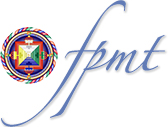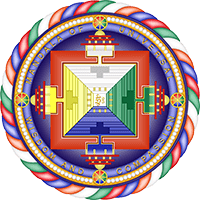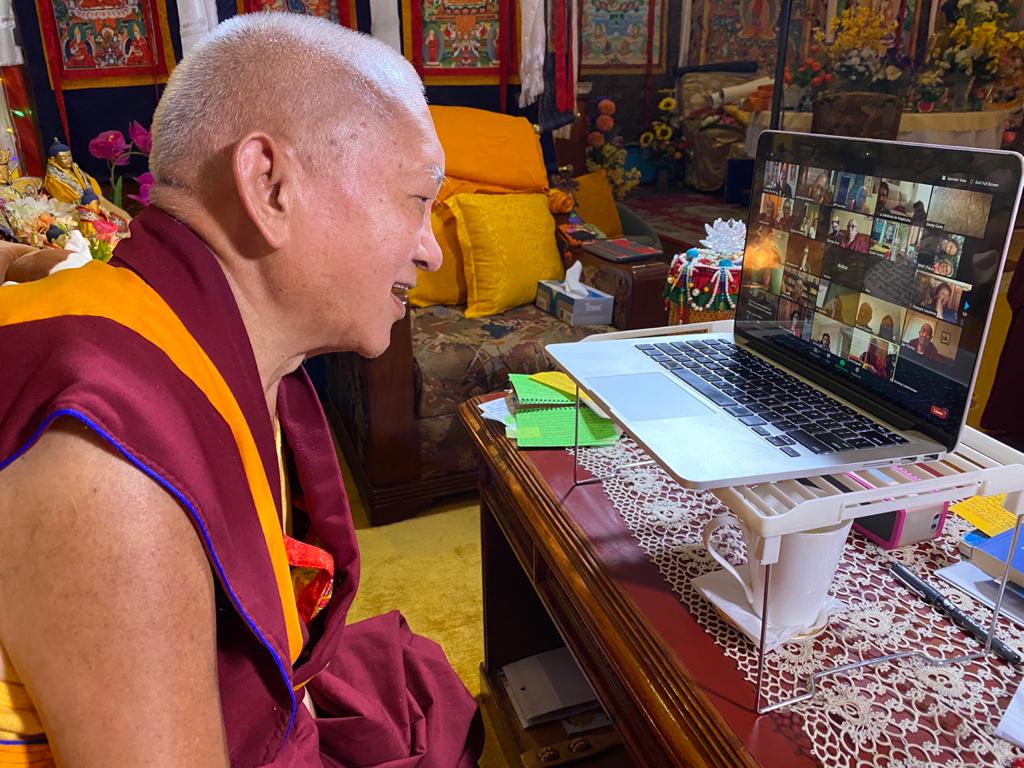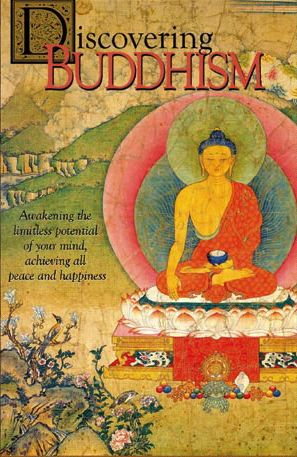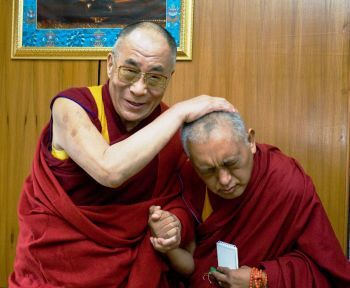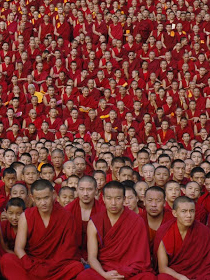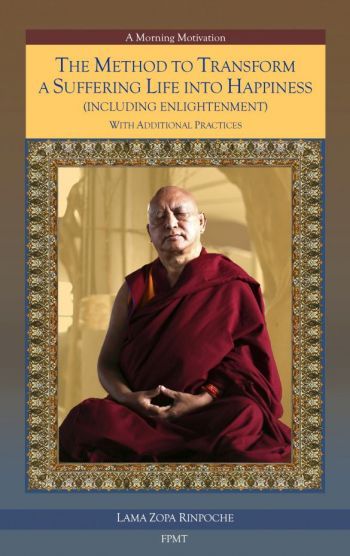- Home
- FPMT Homepage
Foundation for the Preservation of the Mahayana Tradition
The FPMT is an organization devoted to preserving and spreading Mahayana Buddhism worldwide by creating opportunities to listen, reflect, meditate, practice and actualize the unmistaken teachings of the Buddha and based on that experience spreading the Dharma to sentient beings. We provide integrated education through which people’s minds and hearts can be transformed into their highest potential for the benefit of others, inspired by an attitude of universal responsibility and service. We are committed to creating harmonious environments and helping all beings develop their full potential of infinite wisdom and compassion. Our organization is based on the Buddhist tradition of Lama Tsongkhapa of Tibet as taught to us by our founders Lama Thubten Yeshe and Lama Thubten Zopa Rinpoche.
- Willkommen
Die Stiftung zur Erhaltung der Mahayana Tradition (FPMT) ist eine Organisation, die sich weltweit für die Erhaltung und Verbreitung des Mahayana-Buddhismus einsetzt, indem sie Möglichkeiten schafft, den makellosen Lehren des Buddha zuzuhören, über sie zur reflektieren und zu meditieren und auf der Grundlage dieser Erfahrung das Dharma unter den Lebewesen zu verbreiten.
Wir bieten integrierte Schulungswege an, durch denen der Geist und das Herz der Menschen in ihr höchstes Potential verwandelt werden zum Wohl der anderen – inspiriert durch eine Haltung der universellen Verantwortung und dem Wunsch zu dienen. Wir haben uns verpflichtet, harmonische Umgebungen zu schaffen und allen Wesen zu helfen, ihr volles Potenzial unendlicher Weisheit und grenzenlosen Mitgefühls zu verwirklichen.
Unsere Organisation basiert auf der buddhistischen Tradition von Lama Tsongkhapa von Tibet, so wie sie uns von unseren Gründern Lama Thubten Yeshe und Lama Thubten Zopa Rinpoche gelehrt wird.
- Bienvenidos
La Fundación para la preservación de la tradición Mahayana (FPMT) es una organización que se dedica a preservar y difundir el budismo Mahayana en todo el mundo, creando oportunidades para escuchar, reflexionar, meditar, practicar y actualizar las enseñanzas inconfundibles de Buda y en base a esa experiencia difundir el Dharma a los seres.
Proporcionamos una educación integrada a través de la cual las mentes y los corazones de las personas se pueden transformar en su mayor potencial para el beneficio de los demás, inspirados por una actitud de responsabilidad y servicio universales. Estamos comprometidos a crear ambientes armoniosos y ayudar a todos los seres a desarrollar todo su potencial de infinita sabiduría y compasión.
Nuestra organización se basa en la tradición budista de Lama Tsongkhapa del Tíbet como nos lo enseñaron nuestros fundadores Lama Thubten Yeshe y Lama Zopa Rinpoche.
A continuación puede ver una lista de los centros y sus páginas web en su lengua preferida.
- Bienvenue
L’organisation de la FPMT a pour vocation la préservation et la diffusion du bouddhisme du mahayana dans le monde entier. Elle offre l’opportunité d’écouter, de réfléchir, de méditer, de pratiquer et de réaliser les enseignements excellents du Bouddha, pour ensuite transmettre le Dharma à tous les êtres. Nous proposons une formation intégrée grâce à laquelle le cœur et l’esprit de chacun peuvent accomplir leur potentiel le plus élevé pour le bien d’autrui, inspirés par le sens du service et une responsabilité universelle. Nous nous engageons à créer un environnement harmonieux et à aider tous les êtres à épanouir leur potentiel illimité de compassion et de sagesse. Notre organisation s’appuie sur la tradition guéloukpa de Lama Tsongkhapa du Tibet, telle qu’elle a été enseignée par nos fondateurs Lama Thoubtèn Yéshé et Lama Zopa Rinpoché.
Visitez le site de notre Editions Mahayana pour les traductions, conseils et nouvelles du Bureau international en français.
Voici une liste de centres et de leurs sites dans votre langue préférée
- Benvenuto
L’FPMT è un organizzazione il cui scopo è preservare e diffondere il Buddhismo Mahayana nel mondo, creando occasioni di ascolto, riflessione, meditazione e pratica dei perfetti insegnamenti del Buddha, al fine di attualizzare e diffondere il Dharma fra tutti gli esseri senzienti.
Offriamo un’educazione integrata, che può trasformare la mente e i cuori delle persone nel loro massimo potenziale, per il beneficio di tutti gli esseri, ispirati da un’attitudine di responsabilità universale e di servizio.
Il nostro obiettivo è quello di creare contesti armoniosi e aiutare tutti gli esseri a sviluppare in modo completo le proprie potenzialità di infinita saggezza e compassione.
La nostra organizzazione si basa sulla tradizione buddhista di Lama Tsongkhapa del Tibet, così come ci è stata insegnata dai nostri fondatori Lama Thubten Yeshe e Lama Zopa Rinpoche.
Di seguito potete trovare un elenco dei centri e dei loro siti nella lingua da voi prescelta.
- 欢迎 / 歡迎
简体中文
“护持大乘法脉基金会”( 英文简称:FPMT。全名:Foundation for the Preservation of the Mahayana Tradition) 是一个致力于护持和弘扬大乘佛法的国际佛教组织。我们提供听闻,思维,禅修,修行和实证佛陀无误教法的机会,以便让一切众生都能够享受佛法的指引和滋润。
我们全力创造和谐融洽的环境, 为人们提供解行并重的完整佛法教育,以便启发内在的环宇悲心及责任心,并开发内心所蕴藏的巨大潜能 — 无限的智慧与悲心 — 以便利益和服务一切有情。
FPMT的创办人是图腾耶喜喇嘛和喇嘛梭巴仁波切。我们所修习的是由两位上师所教导的,西藏喀巴大师的佛法传承。
繁體中文
護持大乘法脈基金會”( 英文簡稱:FPMT。全名:Found
ation for the Preservation of the Mahayana Tradition ) 是一個致力於護持和弘揚大乘佛法的國際佛教組織。我們提供聽聞, 思維,禪修,修行和實證佛陀無誤教法的機會,以便讓一切眾生都能 夠享受佛法的指引和滋潤。 我們全力創造和諧融洽的環境,
為人們提供解行並重的完整佛法教育,以便啟發內在的環宇悲心及責 任心,並開發內心所蘊藏的巨大潛能 — 無限的智慧與悲心 – – 以便利益和服務一切有情。 FPMT的創辦人是圖騰耶喜喇嘛和喇嘛梭巴仁波切。
我們所修習的是由兩位上師所教導的,西藏喀巴大師的佛法傳承。 察看道场信息:
- FPMT Homepage
- News/Media
-
- Study & Practice
-
-
- About FPMT Education Services
- Latest News
- Programs
- New to Buddhism?
- Buddhist Mind Science: Activating Your Potential
- Heart Advice for Death and Dying
- Discovering Buddhism
- Living in the Path
- Exploring Buddhism
- FPMT Basic Program
- FPMT Masters Program
- FPMT In-Depth Meditation Training
- Maitripa College
- Lotsawa Rinchen Zangpo Translator Program
- Universal Education for Compassion & Wisdom
- Online Learning Center
-
- Prayers & Practice Materials
- Overview of Prayers & Practices
- Full Catalogue of Prayers & Practice Materials
- Explore Popular Topics
- Benefiting Animals
- Chenrezig Resources
- Death & Dying Resources
- Lama Chopa (Guru Puja)
- Lama Zopa Rinpoche: Compendium of Precious Instructions
- Lama Zopa Rinpoche: Life Practice Advice
- Lama Zopa Rinpoche Practice Series
- Lamrim Resources
- Mantras
- Prayer Book Updates
- Purification Practices
- Sutras
- Thought Transformation (Lojong)
- Audio Materials
- Dharma Dates - Tibetan Calendar
- Translation Services
- Publishing Services
- Ways to Offer Support
- Prayers & Practice Materials
-
- Teachings and Advice
- Find Teachings and Advice
- Lama Zopa Rinpoche Advice Page
- Lama Zopa Rinpoche: Compendium of Precious Instructions
- Lama Zopa Rinpoche Video Teachings
- ༧སྐྱབས་རྗེ་བཟོད་པ་རིན་པོ་ཆེ་མཆོག་ནས་སྩལ་བའི་བཀའ་སློབ་བརྙན་འཕྲིན།
- Podcasts
- Lama Yeshe Wisdom Archive
- Buddhism FAQ
- Dharma for Young People
- Resources on Holy Objects
- Teachings and Advice
-
-
*If a menu item has a submenu clicking once will expand the menu clicking twice will open the page.
-
-
- Centers
-
- Teachers
-
- Projects
-
-
-
-
*If a menu item has a submenu clicking once will expand the menu clicking twice will open the page.
-
-
- FPMT
-
-
-
-
-
Faith alone never stops problems; understanding knowledge-wisdom always does. Lord Buddha himself said that belief in Buddha was dangerous; that instead of just believing in something, people should use their minds to try to discover their own true nature.
Lama Thubten Yeshe
-
-
-
- Shop
-
-
-
The Foundation Store is FPMT’s online shop and features a vast selection of Buddhist study and practice materials written or recommended by our lineage gurus. These items include homestudy programs, prayers and practices in PDF or eBook format, materials for children, and other resources to support practitioners.
Items displayed in the shop are made available for Dharma practice and educational purposes, and never for the purpose of profiting from their sale. Please read FPMT Foundation Store Policy Regarding Dharma Items for more information.
-
-
FPMT Community: Stories & News
24
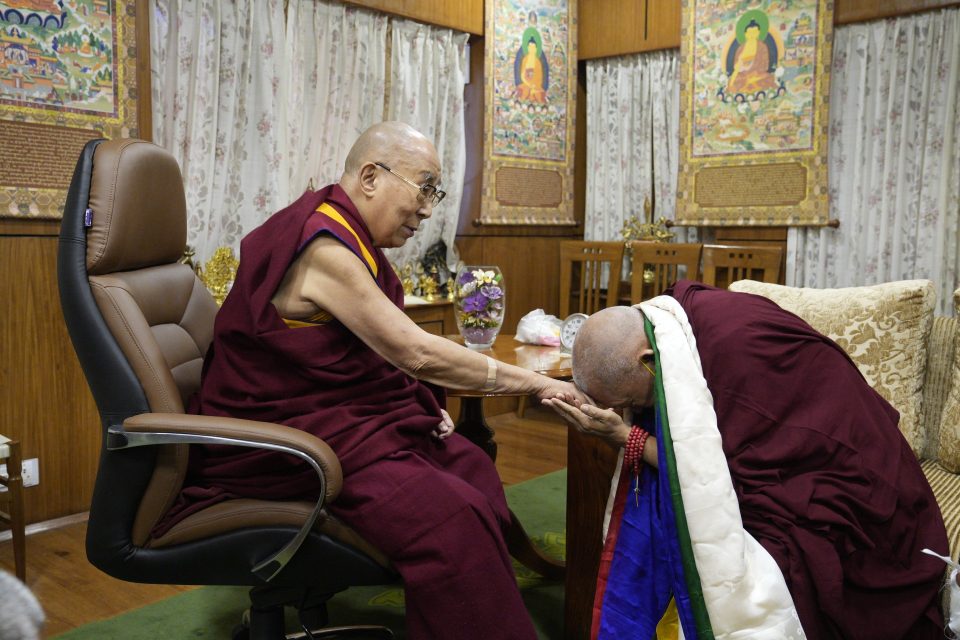
His Holiness meeting with Lama Zopa Rinpoche, Dharamsala, India, November 2, 2022. Photo courtesy of the Office of His Holiness the Dalai Lama.
As His Holiness the Dalai Lama’s ninetieth birthday is approaching on July 6, 2025, we hope to remember the unbelievable and unshakeable kindness of His Holiness.
“I thought that it would be important especially for Western people who had become Buddhist to remember the great kindness they had received from His Holiness the Dalai Lama, Padmasambhava, the Dharma Kings, Shantarakshita and the Tibetan people as a whole,” Lama Zopa Rinpoche said in 2011, explaining his motivation for composing the prayer “Remembering the Kindness of His Holiness the Dalai Lama and the Tibetan People.” This prayer is included in the booklet Prayers for the Long Life of His Holiness the Dalai Lama and Tibet.
“While thinking how important it is, in addition to providing whatever help to Tibet that they can give, for these Westerners to at least direct their thoughts and wishes to the welfare of the Tibetan people, this prayer came to my mind,” Rinpoche said. “I composed it especially for the success of His Holiness the Dalai Lama’s wishes, and in particular for the Tibetan people, and for there to be perfect peace and happiness in the world and for all sentient beings to achieve enlightenment.”
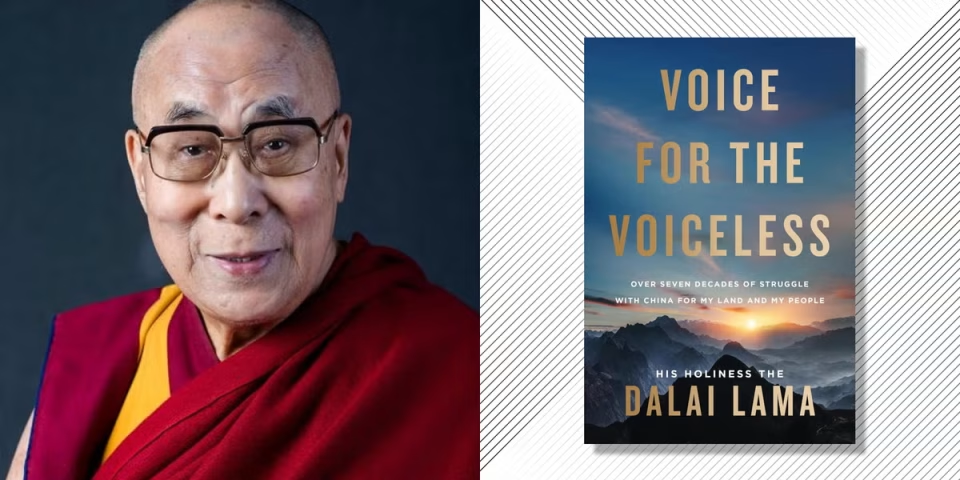
Remembering the Kindness of His Holiness the Dalai Lama and the Tibetan People concludes:
“Our Refuge and Savior, the Supreme One: His Holiness the Dalai Lama
And the Tibetan people have been so kind to us!
Remembering this we make the following dedicating prayers:
May all His Holiness the Dalai Lama’s wishes be successful immediately;
May the Snow Land of Tibet achieve pure freedom
And develop the Buddha Dharma even more than before in Tibet;
And may all mother transmigratory beings achieve enlightenment quickly!”
Lama Zopa Rinpoche offered extensive advice on prayers and practices to do for His Holiness’s birthday, remarking that by doing these prayers and practices, students also benefit their own Dharma practice. You can find Rinpoche’s collected advice in the booklet How to Do the Great Festival of His Holiness’ Birthday in the Best Possible Way.
Please also remember that on the joyful occasion of His Holiness the Dalai Lama’s ninetieth birthday, the FPMT organization will be offering one hundred statues of Shakyamuni Buddha to His Holiness! Please rejoice and read more about this offering occurring during a special long life puja for His Holiness on July 5 in Dharamsala.
For more on His Holiness the Dalai Lama and his beneficial activities, please visit DalaiLama.com.
Foundation for the Preservation of Mahayana Tradition (FPMT), is a Tibetan Buddhist organization dedicated to the transmission of the Mahayana Buddhist tradition and values worldwide through teaching, meditation and community service.
- Tagged: his holiness, his holiness the dalai lama
19
Most Secret Hayagriva: A Deep Connection to FPMT
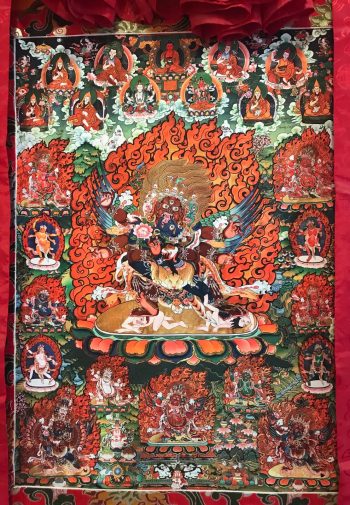
Hayagriva thangka image, courtesy of Nalanda Monastery
Hayagriva is the wrathful manifestation of Chenrezig, the Buddha of Compassion. The practice of Most Secret Hayagriva is extremely powerful to grant help and support and to quickly pacify obstacles. Lama Zopa Rinpoche has said that one of the reasons that Sera Je Monastery has been so successful and able to produce so many qualified teachers, who have very good understanding of Dharma, good hearts, and subdued minds, is due to the blessings—or holy actions—of the deity, Most Secret Hayagriva. Not only outwardly, but also inwardly having great success, this is due to this deity.
The practice of Hayagriva can be traced back to ancient India, to masters such as Mahasiddha Nagarjuna and Guru Rinpoche. It was then developed in Tibet and practiced by other realized beings such as Siddha Darcharwa and the Great Fifth Dalai Lama. The practice was brought to Sera Je Monastery in Lhasa by its founder, Kunkyen Lodro Rinchen Sengge, and has been maintained purely in Tibet. The unbroken lineage continues in Sera Je Monastery in South India, where it is extensively studied and practiced by a group of monks specialized in the practice. The entire Sera Je Monastery performs the Most Secret Hayagriva retreat annually. Both Lama Yeshe and Lama Zopa Rinpoche had a special connection to the Most Secret Hayagriva.
Most Secret Hayagriva Retreat: A Rare Opportunity!
“The Most Secret Hayagriva retreat is the practice/commitment that Lama Yeshe gave to Lama Zopa Rinpoche to do every year for the protection and success of the entire FPMT organization. So now that Rinpoche is no longer with us, we are organizing the group retreat every year for the students to do. This retreat will be held in Nalanda for the first time and then every year in Kopan Monastery as a group retreat. One needs the initiation to attend.” — Ven. Roger Kunsang
Following the Most Secret Hayagriva Initiation that will be given by His Eminence Khensur Rinpoche Lobsang Delek at Nalanda Monastery July 7 and 8, a very rare opportunity of a two-week retreat has been organized on the grounds of Nalanda Monastery starting on July 11. Nalanda has invited four qualified geshes from Sera Je Monastery: Geshe Thubten Sonam (retreat leader), Genden Dhargey (main chant leader of Sera Je), Geshe Dorjee Wangdak (Sera Je chant leader), and Geshe Tashi Dondrup (an artist of butter sculptures and tormas).
Monthly Sponsored Pujas
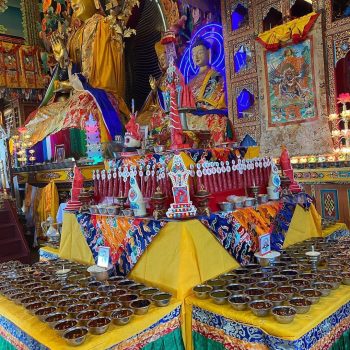
Elaborate tormas for Most Secret Hayagriva puja, Kopan Monastery, 2020.
The FPMT Puja Fund sponsors a monthly Extensive Most Secret Hayagriva puja (Hayagriva Tsog Kong) at Sera Je Monastery, performed by about 40 of the most senior monks who specialize in the practice. This is an all day puja with an elaborate torma offering and extensive prayers and meditation. This puja is dedicated to all FPMT centers, projects, and services; for the success of all Dharma activities and removal of obstacles; to all students who are facing obstacles; to the benefactors of the Puja Fund; and to all beings.
Practice Lineage and New Practice Booklets
There are two initiation lineages of this deity. The “common lineage” is from Guru Rinpoche to Siddha Darchar down through many Sera Je lamas. Lama Zopa Rinpoche gave initiations based on this lineage. The “uncommon lineage” is from the Fifth Dalai Lama Ngawang Lozang Gyatso, who received it in a pure vision and is a part of his Pure Visions Bearing the Seal of Secrecy (Sangwa Gyachen), down to His Holiness the fourteenth Dalai Lama, and more recently Kyabje Jhado Rinpoche.
Most of the Hayagriva practice texts, called “activity manuals (lejang),” are based on the Fifth Dalai Lama’s composition. The Fifth Dalai Lama composed two activity manuals. The extensive one is called The Melody of Fearless Vajra: The Activity Manual for the Chanting and Meditation of Wrathful Most Secret Lotus, and the shorter one, Compendium of the Heart Essence.
FPMT Education Services has recently made available two practice booklets:
- The Melodious Laughter of the Mighty One composed by Dagri Lozang Thubten Namgyal (19th century) is based on Compendium of the Heart Essence with additions from Melody of Fearless Vajra. This activity manual is used when the entire Sera Je Monastery does their annual Hayagriva retreat.
- A Concise and Complete Sadhana of Bhagavan Wrathful Glorious Most Secret Hayagriva compiled by Jhado Rinpoche is based on Melody of Fearless Vajra and is meant for daily practice or for the intermediate sessions of an approach retreat.
We gratefully thank Nalanda Monastery for sponsoring the translation of these two major sadhanas which will be used in the retreat at Nalanda Monastery.
These booklets can be practiced by those who have received either the common or uncommon initiations.
Practice of the Most Secret Hayagriva Mantra
Lama Zopa Rinpoche says the Hayagriva practice reciting the mantra is very powerful. “My suggestion is to recite it. It helps numberless sentient beings and yourself from sickness and untimely death and never get born in lower realms.” Practicing Hayagriva can help, “pacify the outer and inner obstacles for actualizing the path to enlightenment and success in Dharma practice, in serving the teachings of the Buddha, and serving sentient beings.” Rinpoche says that when reciting the mantra, you can think about purifying sickness, spirit harm, negative karma, defilements, and the imprints of oneself and all sentient beings, and also collecting the attainments of the holy body, holy speech, and holy mind. You can also recite the mantras doing meditation on the four activities: peaceful, increasing, controlling, and wrathful. These are all done with the motivation of attaining enlightenment for the benefit of sentient beings.
To do the mantra practice, you must have received the Most Secret Hayagriva initiation, or an oral transmission of the mantra, or, at the minimum, special permission from a qualified guru.
For more information about the Most Secret Hayagriva Retreat at Nalanda Monastery June 11- 28, 2025, please visit Nalanda’s website.
Foundation for the Preservation of Mahayana Tradition (FPMT), is a Tibetan Buddhist organization dedicated to the transmission of the Mahayana Buddhist tradition and values worldwide through teaching, meditation and community service.
- Tagged: hayagriva, most secret hayagriva
18
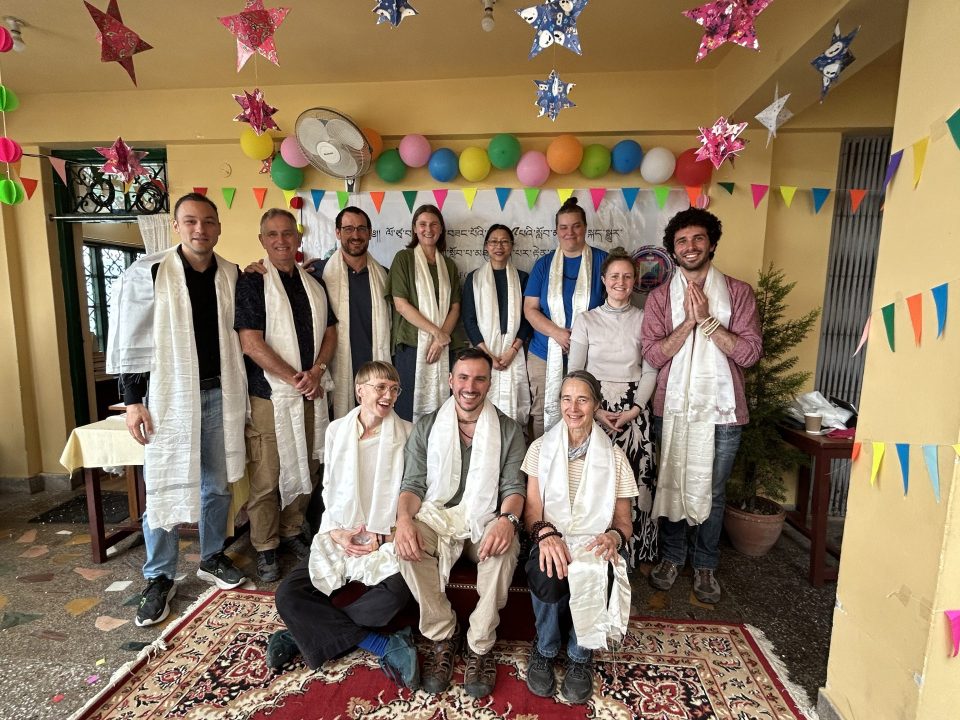
Eleven graduates of LZRTP 9 program.
Lotsawa Rinchen Zangpo Translator Program (LRZTP) is an FPMT project in Dharamsala, Himachal Pradesh, India. LRZTP has produced many gifted Dharma interpreters-translators for FPMT Dharma centers since its conception over twenty-three years ago. In addition to the two-year intensive training program, LRZTP also runs short Tibetan language courses and offers private online Tibetan language lessons.
The latest interpreters training course, LRZTP9, successfully finished with eleven new graduates on June 3, 2025! We are happy to share this report from LRZTP on this achievement:
After two years of hard work and dedication the students of LRZTP 9 can finally say: yes, we have made it! Lotsawa Rinchen Zangpo school’s ninth two-year Tibetan language program has now come to an end. The group of eleven students who came to Dharamsala in 2023 from all over the world are now happy graduates of one of the most demanding programs in the world of Tibetan language studies.
As is usually the case the students started their adventure with LRZTP from different levels. There were beginners, there were those who had already studied some Tibetan and there were those who at the beginning of the program were already quite advanced either in language or Dharma studies. In the end Lotsawa Rinchen Zangpo Translator Program is happy to announce that the latest graduates come from: Australia, Germany, Israel, Sweden, Poland, United States and Argentina.
The final module of the two-year program (Module 9) differed somewhat in terms of the contents when compared to previous modules of the second year. The main feature of the last module was the interpretation (oral translation) workshop. There were four days each week devoted to the interpretation practice. On two days half of the class was theory of interpretation, the other half was practice. Not all of these days were mandatory, but addressed to those whose main aim was learning to interpret the Dharma teachings between Tibetan and English (or their mother tongue). Additionally, now upon the official graduation, those who are interested have been attending an extra interpretation workshop three times a week, which will be going on until the monsoon break in the latter part of July.
The main guest teacher in Module 9 was Geshe Losang Drakpa who taught Introduction to Tantra and on the dissolution stage. We are very grateful to Geshe-la and to all the guest teachers who visited in the course of LRZTP 9 for devoting their time to the students. Geshe Losang Drakpa was also one of the honorary guests at the graduation ceremony.
The graduation ceremony was preceded by an audience with His Holiness the Dalai Lama at His residence in McLeod Ganj. The next day, 3rd June, the actual graduation was organized at school. All students, all teachers, guest teachers and staff were invited to attend. The ceremony began with prayers, serving of tea and traditional sweet rice, followed by the official welcome of all guests by Julia Wilson, the Program Coordinator.
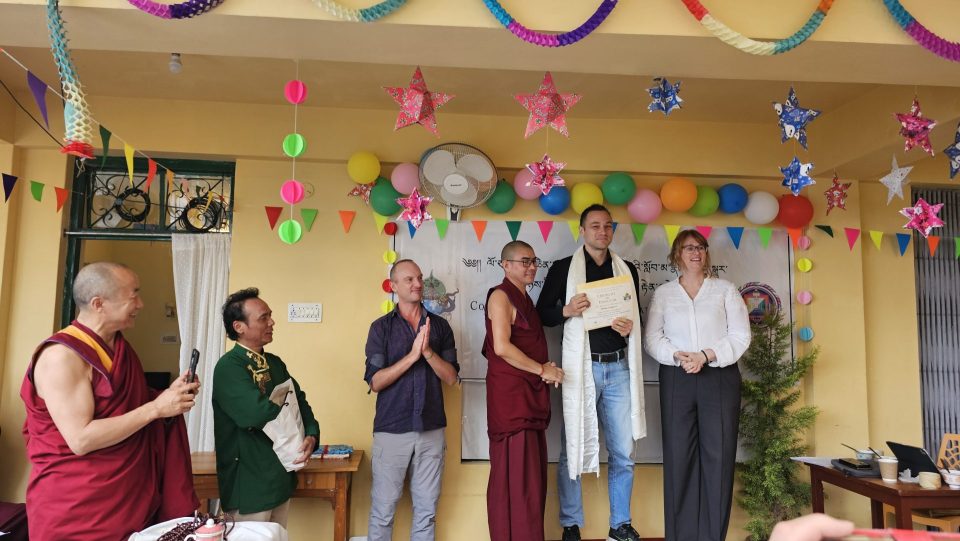
LRZTP 9 students came to the stage to proudly receive their well deserved certificates as well as some small graduation gifts.
Several of the main teachers, including the special guest teacher Geshe Losang Drakpa, then took the stage to address the happy graduates. After all the well wishes and congratulations, students one by one came to the stage to proudly receive their well deserved certificates as well as some small graduation gifts. Finally, the students themselves, gave small individual speeches and were later interviewed in Tibetan by the reporters of Tibet Express.
The official part of the ceremony ended with a delicious lunch prepared for the occasion by the school’s wonderful cooks. Later, everyone had tea and cakes and engaged in individual conversations.
We would like to stress here how much of hard work the students have put into their learning in LRZTP. It took great effort on their part to not only master the extensive material of the two years but also to gain confidence as future translators and interpreters of Tibetan language and Dharma teachings. Everyone did a wonderful job and we are very proud of all the graduates. They all did really well in the course and will certainly be brilliant lotsawas if they only choose to. They will also carry on the good name of the Lotsawa Rinchen Zangpo Translator Program into the world.
In October of 2025 the next two-year program – LRZTP 10 – will begin. The registration is still open. Anyone who has been seriously thinking of joining but has not yet registered, is most welcome to do it. The online and at-school individual classes still continue, so if you feel like two years is too long or you have other goals, check the LRZTP website and consider joining these individual one-on-one teacher-student meetings.
Foundation for the Preservation of Mahayana Tradition (FPMT), is a Tibetan Buddhist organization dedicated to the transmission of the Mahayana Buddhist tradition and values worldwide through teaching, meditation and community service.
12
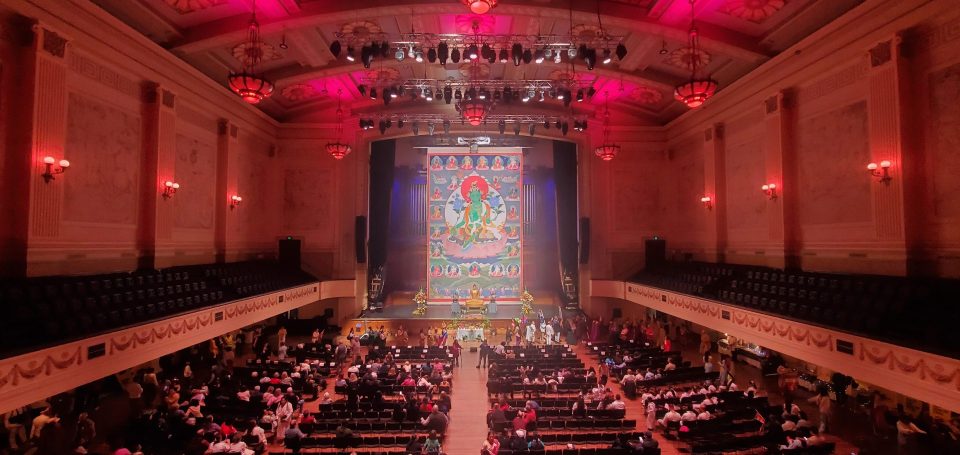
Twenty-One Taras on display at the Melbourne Town Hall. Photo by Gina Lewis.
In 2014, Lama Zopa Rinpoche requested Peter Iseli to paint a very big ( 15 meters x 9 meters, 49 ft x 30 ft) Twenty-One Taras thangka. Peter and his wife Jangchub Iseli-Sangmo spent four years creating the thangka, one section at a time, in a studio at Institut Vajra Yogini in France. At the end of 2017, Lama Zopa offered this thangka to Tara Institute (TI) in Melbourne, Australia, “to show to as many people as possible.”. In 2019 Peter made final changes requested by Rinpoche. For the third year in a row, this thangka was displayed at the Melbourne Town Hall during the annual multicultural Vesak celebrations.
Cynthia Karena shares the details of this year’s event:
In the early morning pre-dawn hours of Saturday May 3, a dedicated group of volunteers gathered to maneuver a heavy 9.5 meter (31 ft) tube containing our giant Twenty-One Taras Thangka through Tara Institute onto a waiting truck outside.
After its initial ‘unveiling’ in 2018 at the prestigious White Night festival in Melbourne, Tara Institute has most recently displayed the 21 Taras Thangka as part of the annual multicultural Vesak celebrations at the Melbourne Town Hall for the past three years.
We arrived at the Town Hall just at sunrise, where we began unrolling and hoisting the thangka, once again releasing the Taras! It’s always a beautiful experience watching the thangka flutter and rise, slowly revealing the Taras row by row. This year’s event coincided with election day in Australia, so seeing the Taras was a good purifying antidote to all the madness of the election campaign.
Many of us here at Tara Institute see the Twenty-One Taras Thangka as a precious connection with Lama Zopa Rinpoche. Not only did he give us this magnificent thangka, but he was with the thangka every day for a month at his 2018 retreat when it hung inside the Great Stupa in Bendigo. “It’s wonderful to be here. You can really feel the presence of Rinpoche,” says TI member Carol Malina.
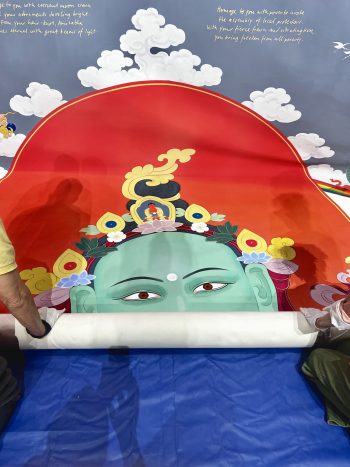
Rolling of the thangka. Photo by Cynthia Karena.
Many people walked in off the street and were amazed by these beautiful “Buddhist goddesses’,” and staff from the Melbourne Tourist Office two doors down kept coming in to ask questions or to just sit and gaze at the thangka. One woman said she sat for an hour because she couldn’t stop looking at the Taras. This year, we also did a public group recitation of the Twenty-One Tara praises, which was moving and powerful with the thangka towering in front of us.
At the end of the day, rolling up the thangka is another technical exercise. Due to the immense size, it takes at least an hour to roll up, as we need to smooth out developing wrinkles with each roll, and make sure we roll straight to avoid overhang, which is easy to do when there is 15 meters of fabric to roll onto a 9 meter long tube! But the upside is that we are up close and personal with each Tara, able to see in detail the extraordinary work Peter has created.
With grateful thanks to Cynthia Karena for this report!
Several FPMT centers have commissioned large thangkas and are now hosting festival days where these holy objects can be enjoyed. We invite you to rejoice in the displaying of these magnificent holy objects which was one of Lama Zopa Rinpoche’s Vast Visions for the FPMT organization. As Rinpoche has explained, doing this makes it “so easy for sentient beings to purify their heavy negative karma and making it so easy for sentient beings to create extensive merit. Which makes it so easy to achieve the realizations of the path and so easy to achieve liberation and enlightenment.”
Foundation for the Preservation of Mahayana Tradition (FPMT), is a Tibetan Buddhist organization dedicated to the transmission of the Mahayana Buddhist tradition and values worldwide through teaching, meditation and community service.
- Tagged: holy objects, large thangka, tara institute
4

2025 Maitripa College graduates and Chaplain Endorsees with President Yangsi Rinpoche and faculty. Photo by Chris Majors.
On May 17, the Maitripa College community, Portland, OR, USA, gathered to celebrate the 16th Commencement Ceremony honoring the 2025 graduates of the Master of Arts in Buddhist Studies and Master of Divinity programs. Dean of Education, Namdrol Miranda Adams shares a moving report of the ceremony:
On a warm spring day in Portland, Oregon this May, the Maitripa College community gathered in person and online to celebrate the 16th Commencement Ceremony, honoring the 2025 graduates of the Master of Arts in Buddhist Studies and Master of Divinity programs.
This milestone marks not only the culmination of rigorous academic and contemplative training, but also the beginning of lives deeply committed to service, wisdom, and compassion in the world. The diverse paths of this year’s graduates reflect the heart of Maitripa’s mission: integrating traditional Tibetan Buddhist philosophy and practice with the challenges and needs of modern life.
Our 2025 graduates have engaged deeply with Buddhist texts and teachings, developed their meditation practices, and completed intensive education and fieldwork. Now, they are stepping into the world as educators, caregivers, and community leaders. Among this years’ graduates are those working in special education, elder care, and suicide prevention—each embodying the union of spiritual depth and skillful means.
This year’s Commencement Address was delivered by esteemed Buddhist scholar and translator, and longtime Maitripa College friend Dr. Roger Jackson, who offered a spirited encouragement to seek wisdom not only in the texts and traditions of Buddhism but also in the world around us. With humor and heart, he reminded us that inspiration can be found everywhere—even in the words of the Beat Poets—and called on graduates to remain curious, courageous, and open in their journeys.
The ceremony was a joyful and moving gathering of faculty, students, friends, family, and supporters. It included traditional prayers and dedications, heartfelt reflections, and an offering of gratitude to the teachers and mentors who have guided the graduates on their paths.
As Maitripa College enters its 20th year, we are inspired by the example of this graduating class and all of our alumni who are manifesting the Dharma through lives of engaged, compassionate service. May the merit of their practice and study continue to benefit countless beings.
To learn more about Maitripa College and its programs, visit www.maitripa.org.
We welcome the submission of news stories from those within the FPMT community. This can be a story about something you have personally completed or accomplished, about someone else who has done so, or about the FPMT center, project, or service of which you are a part. Ideal submissions will give readers reasons to rejoice, share ideas, and create connections between those in the international community. Have something to share? Please let us know!
Foundation for the Preservation of Mahayana Tradition (FPMT), is a Tibetan Buddhist organization dedicated to the transmission of the Mahayana Buddhist tradition and values worldwide through teaching, meditation and community service.
- Tagged: maitripa college
30
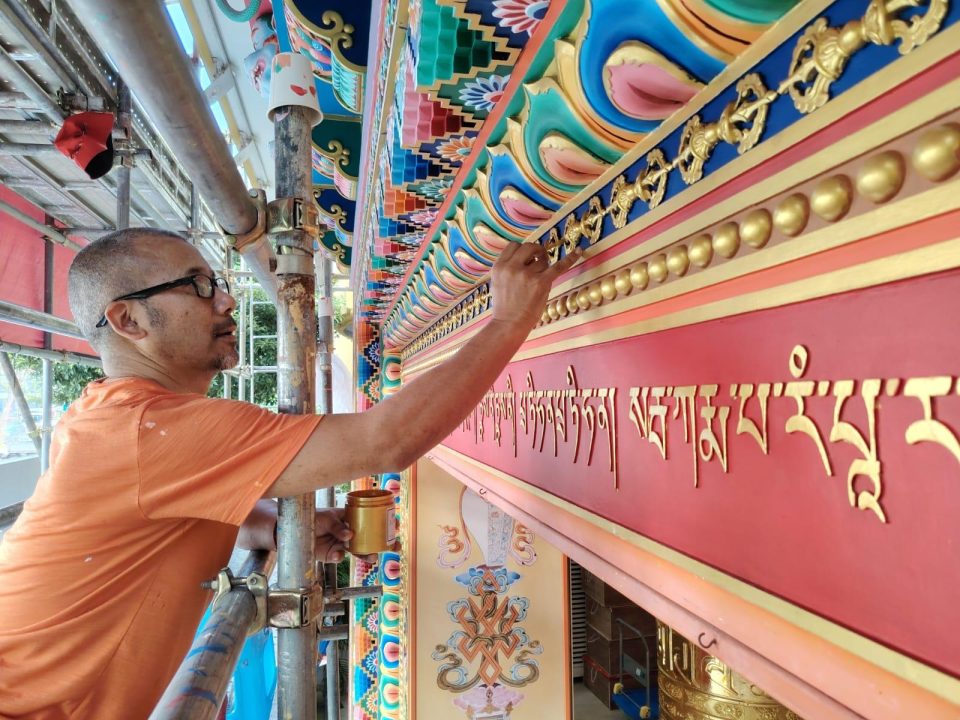
Painting of the new gateway, Amitabha Buddhist Centre, Singapore. Photo courtesy of ABC.
Ven. Tenzin Tsultrim of Amitabha Buddhist Centre (ABC), Singapore. shares news of the completion of their newly renovated gateway:
The Amitabha Buddha statue above ABC building’s gateway now shines with renewed radiance after over two months of repairs and repainting. The statue now sits with a fresh coat of paint on a newly constructed lotus, flanked by the two dragons that have also been carefully restored with gold paint.
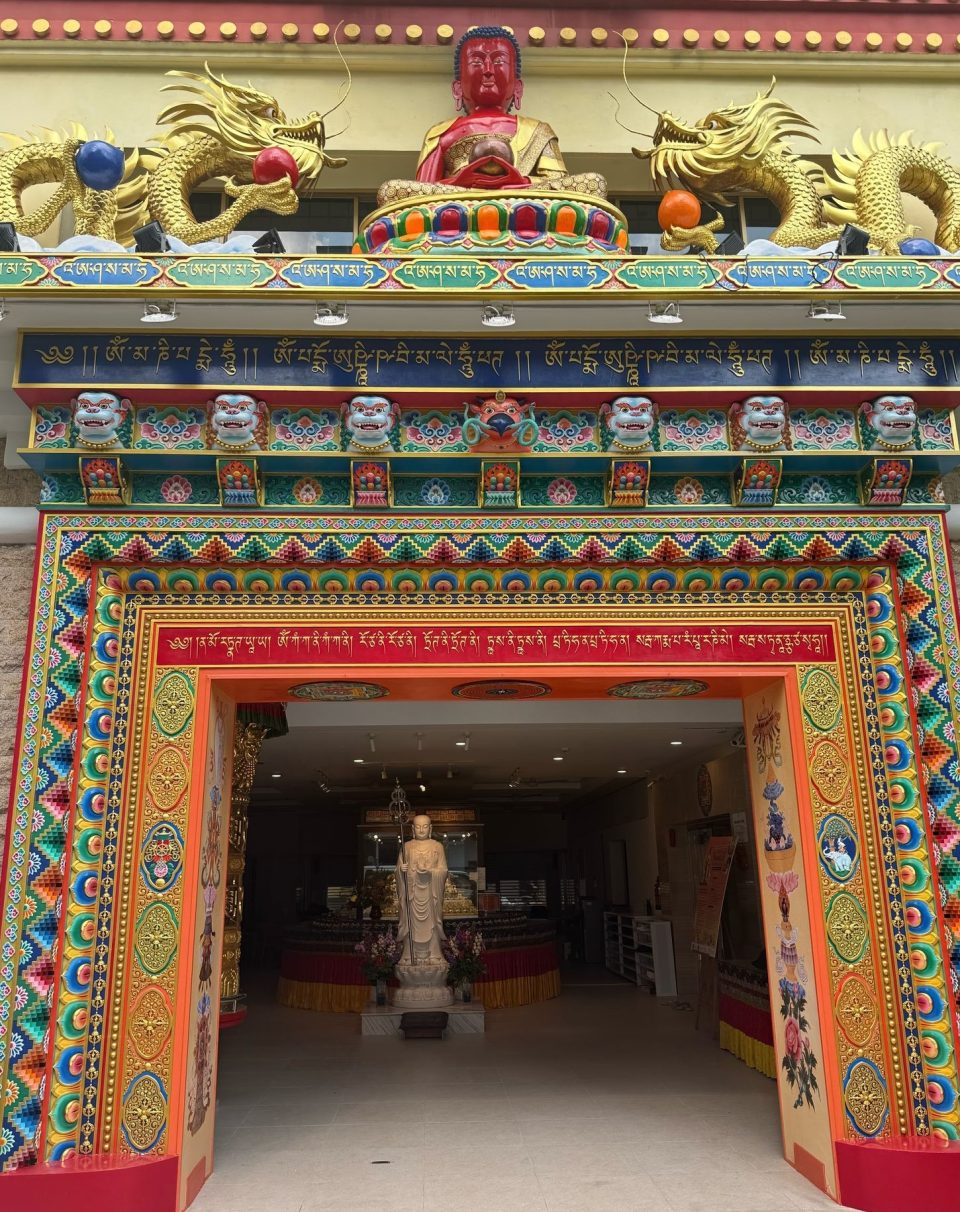
Newly finished restored gateway at Amitabha Buddhist Centre, Singapore. Photo courtesy of ABC.
The structures had been damaged by heavy rainfall over the year-end monsoon season and on the brink of collapse! The statue was carefully removed for repairs to be done. Two monks from Kopan Monastery, Ven. Jampa (Gen Tseme) and Ven. Sherab, together with ABC member Jeremy Chu, completed repainting the entire gateway with all its detailed sculptures and mouldings, including the mantras. The work was completed on April 25 and Amitabha Buddha once again sits serene over the gateway.
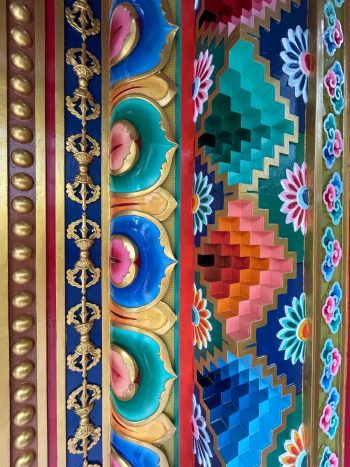
Beautiful detail of the new gateway at ABC.
ABC director, Tan Hup Cheng, is very pleased with the finished result: “It will serve as a source of inspiration and blessing for people passing by our center. We can rest assured our Guru Kyabje Lama Zopa Rinpoche would have been very happy at the completion of this major restoration of the Amitabha Buddha gateway.”
It was Rinpoche who had advised having the Amitabha Buddha seated above the building’s entrance along with specific accompanying details and mantras. Rinpoche had always emphasized how important it was for powerful mantras to be placed where they could be of greatest benefit to sentient beings.
The gateway is decorated with four such mantras that have the power to purify eons of negative karma and protect one from falling into the lower realms, just even by seeing them:
1) The Six Syllables of Clairvoyance Mantra
A AH SHA SA MA HA
This mantra decorates the skirting of the parapet that holds Amitabha Buddha and the dragons.
2) The Six-Syllable Mantra of Chenrezig
OM MANI PADME HUM
3) The Stainless Lotus Pinnacle Mantra
OM PADMO USHNISHA VIMALE HUM PHAT
Mantras #2 and #3 are painted above the snow lions and Garuda.
NAMO RATNA TRAYAYA OM KAMKANI KAMKANI ROCHANI ROCHANI TROTANI TROTANI TRASANI TRASANI PRATIHANA PRATIHANA SARVA KARMA PARAM PARA NI ME SARVA SATTVA NANCHA SVAHA
This mantra appears on a red background just above the door entrance.
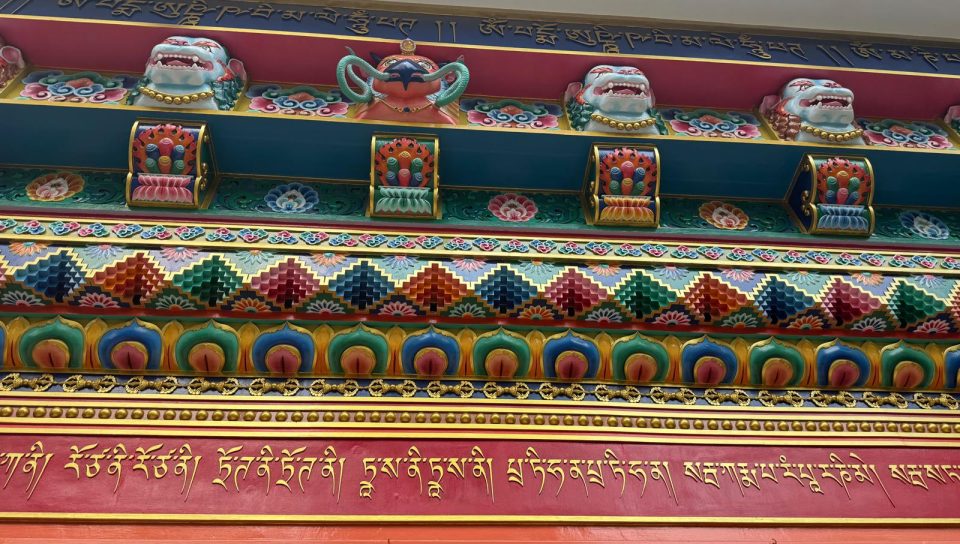
Door entrance at ABC.
There are inconceivable benefits to sentient beings in having this gateway that was designed according to Rinpoche’s advice.
Please join us in rejoicing on the completion of this extremely auspicious gateway at ABC in Singapore!
We welcome the submission of news stories from those within the FPMT community. This can be a story about something you have personally completed or accomplished, about someone else who has done so, or about the FPMT center, project, or service of which you are a part. Ideal submissions will give readers reasons to rejoice, share ideas, and create connections between those in the international community. Have something to share? Please let us know!
Foundation for the Preservation of Mahayana Tradition (FPMT), is a Tibetan Buddhist organization dedicated to the transmission of the Mahayana Buddhist tradition and values worldwide through teaching, meditation and community service.
- Tagged: amitabha buddhist centre, mantras
23
Please Enjoy Our May 2025 e-News
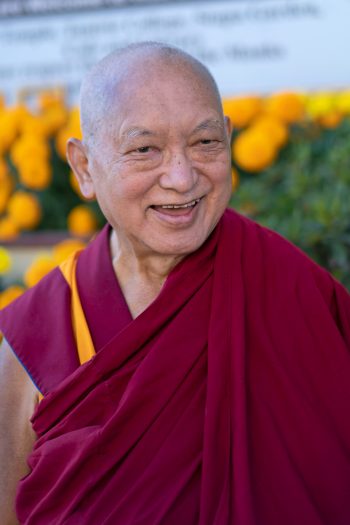
Lama Zopa Rinpoche at Kopan Monastery, Nepal, November 2020. Photo by Ven. Lobsang Sherab.
Our May 2025 e-News is now available and brings many causes for rejoicing including:
- Teachings and advice from Lama Zopa Rinpoche and Lama Yeshe
- An update from the FPMT Inc. Board of Directors
- Practice advice and merit-making opportunities on Saka Dawa
- News and stories from the FPMT community
- CPMT Summit story and photo gallery
- Resources and opportunities for study and practice
- Changes in the FPMT organization
and much more!
Please read this month’s e-news in its entirety.
Have the e-News translated into your native language by using our convenient translation facility located on the right-hand side of the page.
Visit our subscribe page to receive the FPMT International Office News directly in your email inbox.
- Tagged: enews, fpmt enews
20
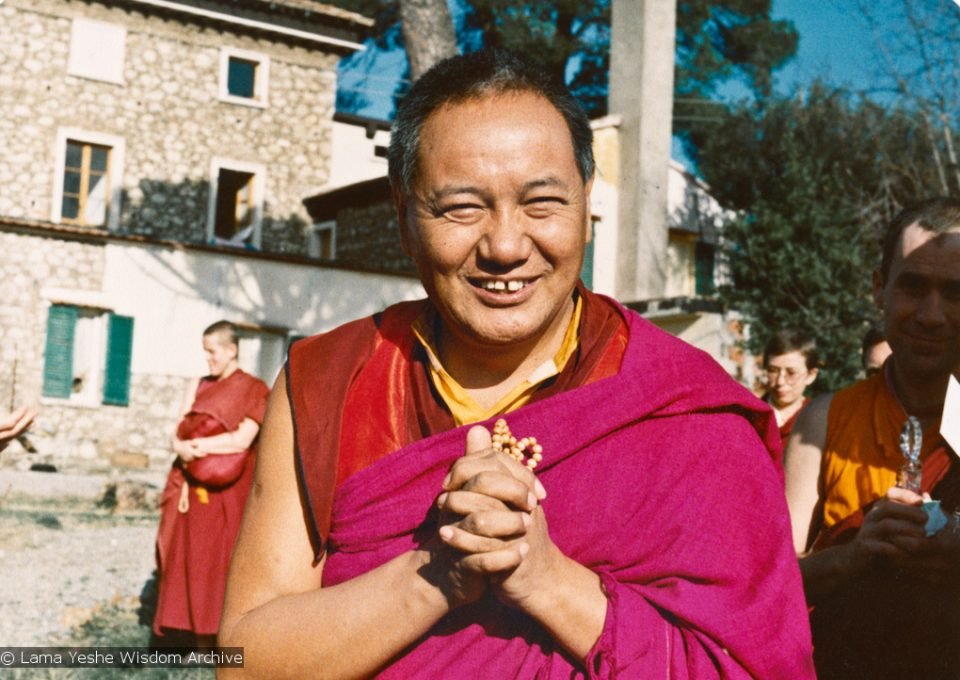
Lama Yeshe at Istituto Lama Tzong Khapa, Italy, 1983. Photo courtesy Lama Yeshe Wisdom Archive, donated by Merry Colony.
In 2025, Lama Yeshe would have reached the age of 90 years. To honor his profound legacy, Istituto Lama Tzong Khapa (ILTK), Italy, invited his students from across the globe to share their treasured memories and life-changing teachings with present and future generations. A special puja was held on May 15 at ILTK celebrating what would have been Lama’s birthday.
Carlota Pinhero shares the story:
Lama Yeshe
May 15, 2025, marked what would have been the 90th birthday of Lama Thubten Yeshe. Istituto Lama Tzong Khapa gathered to celebrate his impact on countless lives. With profound gratitude for his jewel-like teachings available in these challenging times, we reaffirm our commitment to manifest Lama Yeshe’s vision through our actions and practice. He consistently emphasized cultivating a sense of family within the FPMT community. Honoring this wish, we gathered as part of this international family united in dedication to the Dharma and the ultimate welfare of all sentient beings.
Lama Yeshe was the beginning of the transformation of the minds of many westerners; the eye-opening key to the freedom that is possible to achieve in ourselves; the pointer to how all the suffering we’re experiencing is created by nothing but our minds. As his previous incarnation, abbess Achè Jampa, prayed over and over again “May I be able to bring the Dharma to those who have never met it and who live in suffering, their wisdom eyes are blinded by the darkness of ignorance.” And that is what Lama did! Lama Yeshe lived in a time of cultural revolutions and joked about his own revolution, the “Dharma Cultural Revolution.” He inspired and continues to inspire countless people to truly investigate what it means to be a human being.
As we have been conducting the interviews with his earliest students to celebrate 90 years since his birth, new ways of viewing reality have been unfolding, just by merely listening to Lama’s words through the mouths of those who were once very close to him, just as if he was here speaking himself. The way Lama shaped people’s lives and completely changed them from very negative states to very happy ones, is unique in this world. Even those new to Buddhism can feel his influence so present here in the center. Lama Yeshe knew how to deeply love each individual, listening attentively, healing without judgment and even smiling at the shadows of the mind. His “Big Love” gave new light to those blinded by ignorance. His faith in human potential brought many students to believe in themselves and bring a positive impact to the world.
Community Celebration of the 90th Anniversary of Lama Yeshe’s Birth
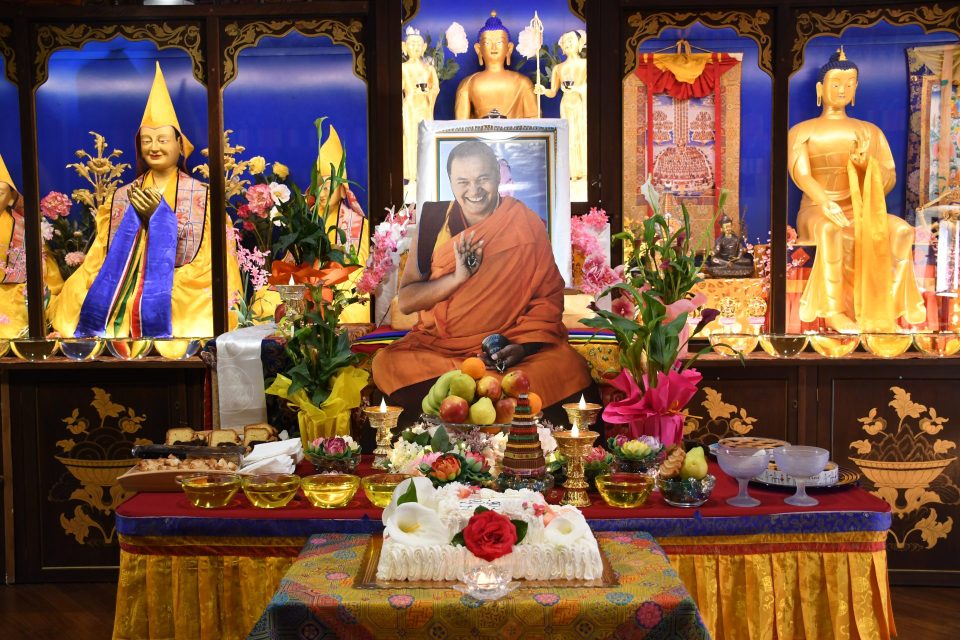
The altar at ILTK for the Lama Yeshe ninetieth birthday celebration. Photo courtesy of ILTK.
Cleaning Lama Yeshe’s Stupa
As the sun reached its zenith, a small group of us gathered in the gardens of ILTK, around Lama Yeshe’s sacred stupa, built many years ago as a testament to his enduring presence. Volunteers, intrigued by our festive environment, would go by and join us. This stupa has been a silent witness to the full spectrum of human emotion; from the grief of his passing, to the excitement of a reincarnation, and now hundreds of people each week come to circumambulate it, walk their pets, or encounter the Dharma for the first time during retreats.
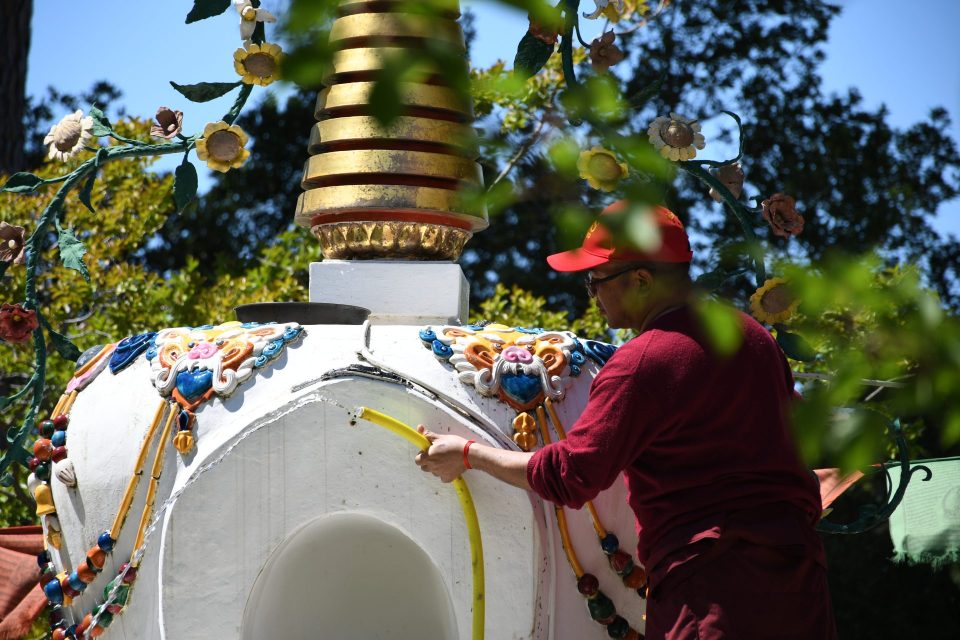
Geshe Lhundrup guiding and cleaning Lama Yeshe’s Stupa, ILTK, Photo courtesy of ILTK.
With a screwdriver in one hand and silicone in the other, clothes and sponges at the ready, we began chanting mantras while spending the next four hours meticulously cleaning every sacred detail of the stupa—polishing the ornate silver that frames Lama Yeshe’s image and the Buddha seated within, removing the weathered cloths and offering it fresh khatas and flowers. Geshe Lhundrup, a monk from Kopan now resident at ILTK, and Thubten Sherab, raised by Lama Yeshe and Lama Zopa Rinpoche, spent the day guiding us on the best way to do this. The sun was shining the whole afternoon, and the environment felt exactly like what we are here to do in this life: work with intention, remain aware of our actions, rejoice and help each other in whatever ways we can.
There is something special about coming together as a community to honor one’s teacher, to honor the legacy that allows us to be here today, working on our afflictions and, together, discovering how to cultivate happy minds and a happy family. This was Lama’s wish. In 1978, visiting ILTK, he said, “Each one of us can become a disaster when we go through difficult times, so we must try to help each other.”
Guru Puja
The day culminated in a special Guru Puja with a beautiful cake inscribed with “Big Love” at its center, offered by ILTK president, Lucia Landi, and director, Valerio Tallarico. The gompa was filled with practitioners, including some of the direct students of Lama Yeshe who shaped the center into what it is today. For him, ILTK had the function of being a refuge: “It has to be friendly, because everything is dedicated to sentient beings.”
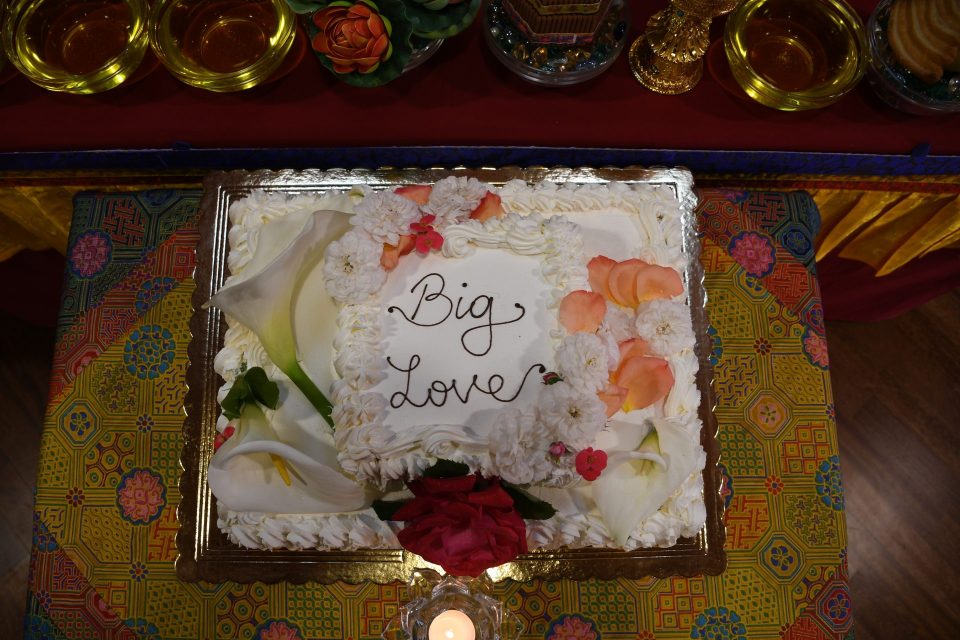
Big Love cake offered during the puja. Photo courtesy of ILTK.
The puja was conducted by Geshe Gelek and, in the end, some of Lama’s first students shared memories and funny stories, among them, Massimo Corona, founder of the Institute, former executive director of FPMT International Office, and former publisher of Mandala magazine; and Susanna Parodi, who, in the words of Lama, was, “the first lady on this earth to become Italian Mahayana Buddhist nun.” Voices united in chanting and in gratitude as we spoke about the true source of it all: The boundless compassion of our precious Lama.
Lama Yeshe joked, “There are three types of Buddhism: Hinayana, Mahayana, and Italiana!” He made this comment due to the unique passion and distinct attitude of the first Italian students. It is also thanks to this dedication that the Institute is one of the biggest in Europe and one of the doors through which the Dharma continues to spread around the world.
Direct Students Interviews
Throughout 2025 ILTK will be interviewing Lama’s direct students to share how his teachings impacted on their lives through short video. These interviews will be treasured and shared through the Institute’s social channels and with the Lama Yeshe Wisdom Archive.
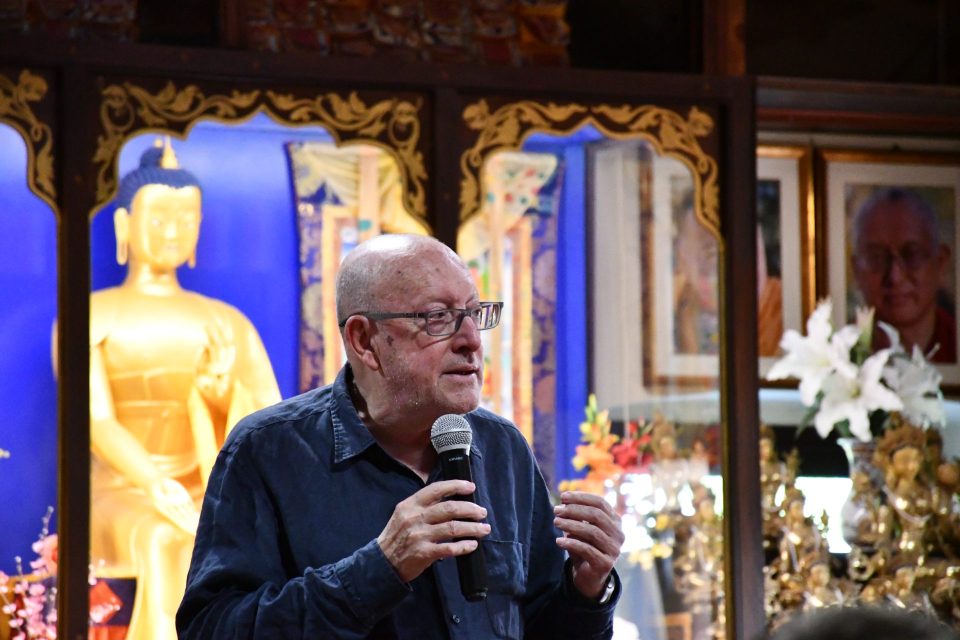
Massimo Corona speaking about Lama Yeshe and the origins of ILTK. Photo courtesy of ILTK.
Listening to the stories of those who had their minds completely transformed by Lama Yeshe and feeling this strong sense of family, devotion and, above all, deep gratitude, is deeply inspiring and has sparked the wish of keeping his legacy in any way possible. The way future generations can, especially now, benefit from his teachings, his timeless wisdom and compassion, is inconceivable. This is what the path to enlightenment is, caring for our own minds and also caring for this rare family that we build through our devotion to the Dharma and the lamas, from the single intention of leading all beings to a state free of suffering.
If you wish to help keep Lama’s legacy alive for the future generations, and were fortunate enough to have known Lama Yeshe, please consider taking part in the project 90 Students for 90 Years. If interested, please contact ILTK directly. The short video interview series will continue through 2025.
All quotes shared here are from Big Love: The Life and Teachings of Lama Yeshe. With grateful thanks to Carlota Pinhero and Fabiana Lotito for this story.
Foundation for the Preservation of Mahayana Tradition (FPMT), is a Tibetan Buddhist organization dedicated to the transmission of the Mahayana Buddhist tradition and values worldwide through teaching, meditation and community service.
- Tagged: lama yeshe
14
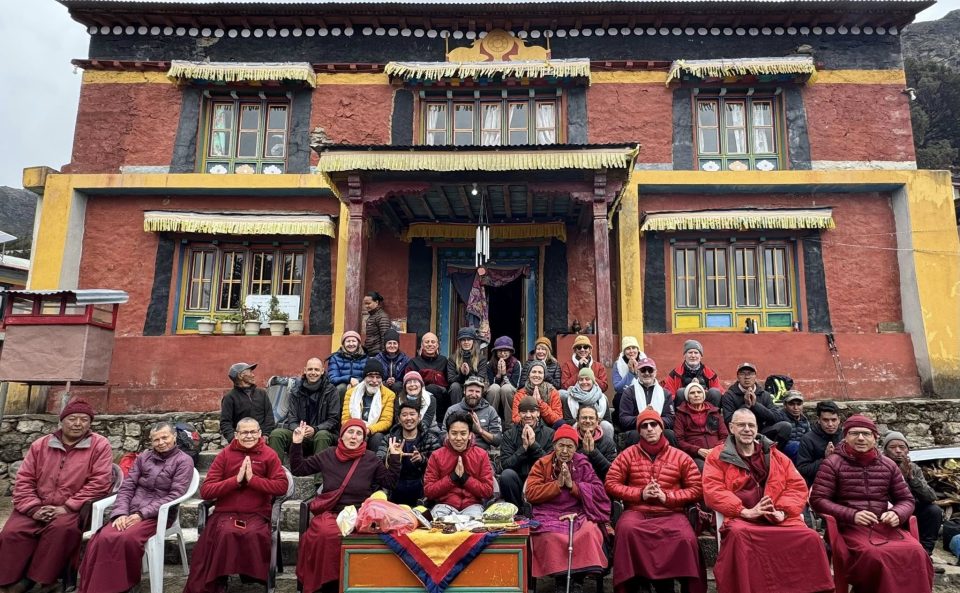
Second anniversary pilgrim participants in front of the Lawudo Gompa. The final group photo—blessing the prayer flags to be hung at the White Cliff above Lawudo. Some pilgrims left a day earlier to give more time to walk back to Lukla. Photo courtesy of Ven. Sarah Thresher.
By Ven. Sarah Thresher
The Second Lawudo Anniversary Pilgrimage ended on May 10 with the safe return of all the pilgrims to Kathmandu and a double rainbow appearing in the sky to the East of Lawudo and arching over Namche Bazar.
This year the pilgrimage was limited to 25 participants and a further 5 helpers, 5 guides and 15 porters and pretty much everyone except for the porters were disciples of Rinpoche. Surprisingly, the average age of the pilgrims was 60 and we even had a wonderful 70th birthday celebration on our first night in Phakding! Everyone had love in the hearts for Rinpoche and some had waited years and years for the opportunity to fulfill their dream of visiting Lawudo.
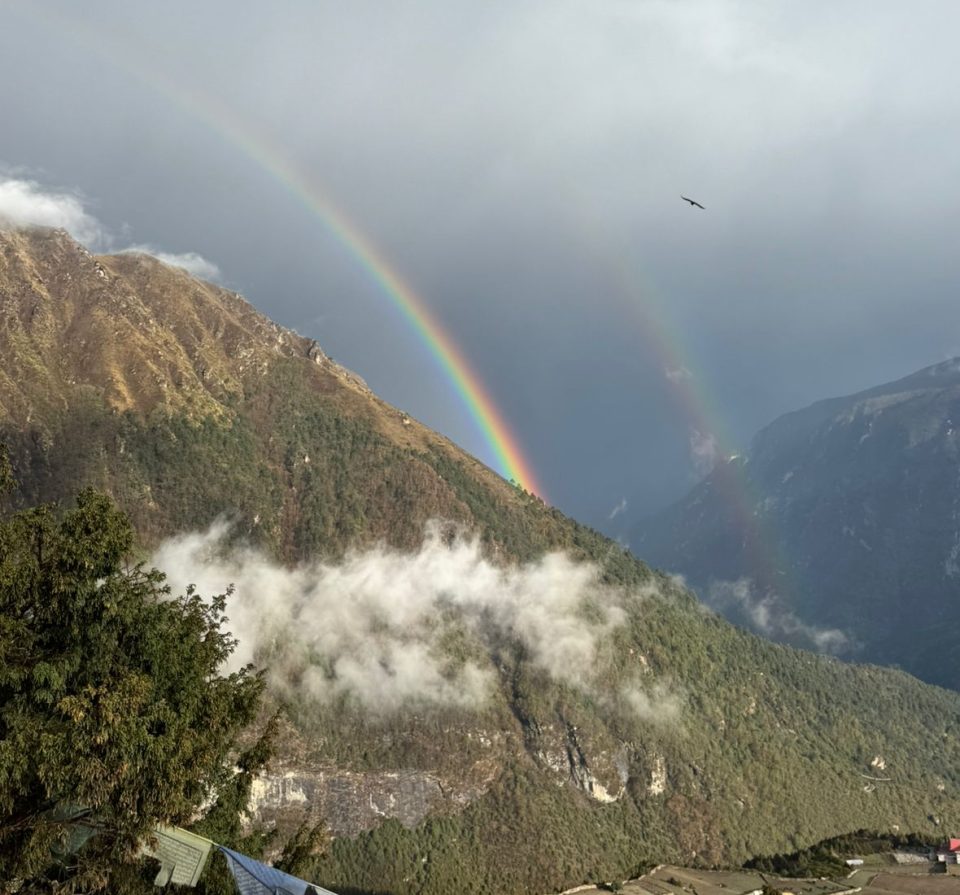
Double rainbow appearing in the sky to the East of Lawudo and arching over Namche Bazar. Photo courtesy of Ven. Sarah Thresher.
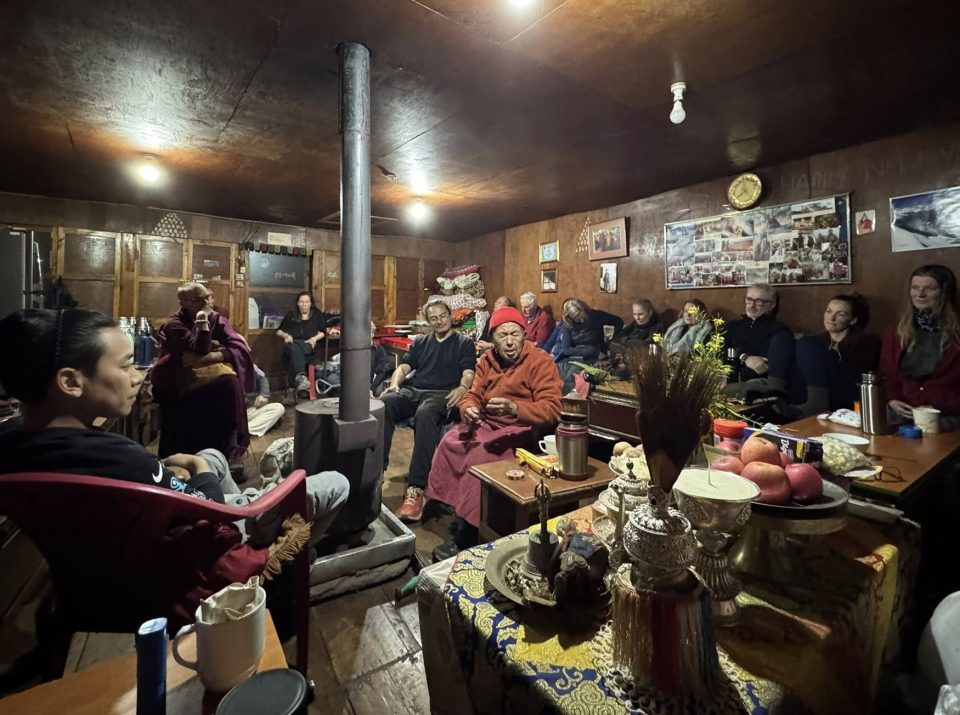
Pilgrims with Ani Samten in the evening by the fire listening to stories. Photo courtesy of Ven. Sarah Thresher.
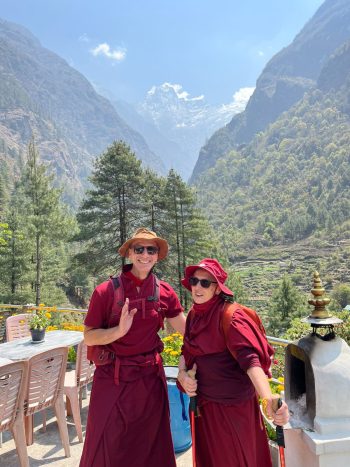
The journey begins! Geshe Legtsok and Ven. Sarah arrive in beautiful Thadokosi for lunch on the first day. Photo courtesy of Ven. Sarah.
The goal of the Lawudo Pilgrimage is to immerse in the world of the Lawudo Lamas, while doing prayers and practices for the auspicious return of our most precious Lama Zopa Rinpoche’s yangsi and for all Rinpoche’s holy wishes to be fulfilled. With this in mind we visited various gompa along the route, including Rimijung and Thame (two of the three oldest gompas in Khumbu), Namche, Khumjung, Khunde, Thamo Nunnery and Charok. We were fortunate to attend pujas at Rimijung and Thame; join the local sangha from all around the valley in reciting the Kangyur at Khumjung; make offerings to the sangha, and be guided around the gompa we visited with talks by the lamas in charge—deepening our understanding of the Sherpa religion and culture. Most of us felt very at home and humbled by the famous Sherpa hospitality.
Those who were strong enough walked to Thame for a full day visiting the holy places of Rinpoche’s birthplace—the 100-trillion prayer wheel next to the birth house, Thame monastery, Thameteng stupa and precious holy objects from the first Lawudo Lama—while also offering Lama Chopa tsog, Chanting the Names of Manjushri and other auspicious prayers for Rinpoche’s swift return.
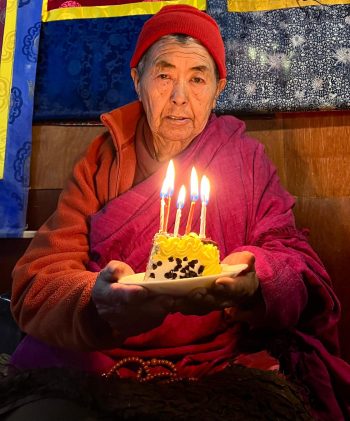
Anila Ngawang Samten’s 83rd birthday was celebrated with a special Lama Chopa Jorcho puja for her health and long life and wishes to be fulfilled offered by the pilgrims in the main gompa and a huge birthday cake brought from Namche Bazar as special tsog! Photo by Tania Duratovic.
At Lawudo, we attended inspiring and thought-provoking teachings by Charok Lama Rinpoche who moved us by his insight into Lama Zopa Rinpoche’s qualities; divided into small groups to recite the prayers for Rinpoche’s yangsi in the Lawudo cave; visited Charok Hermitage; hung prayer flags at the Amogapasha thangka above Lawudo; performed Vajrasattva tsog and even enjoyed an afternoon birthday celebration for Anila Ngawang Samten—Rinpoche’s sister—with Lama Chopa Jorcho and a special birthday cake brought from Namche. Evenings were spent gathered around the fire in the dining room listening to Anila’s stories and tales of the first Lawudo Lama Kunzang Yeshe. The weather was unpredictable—often cold and cloudy, sometimes sunny and clear, and even snowing at the sacred mountain of Khumbila—but despite the hardships there was a warmth and joy that never dissipated throughout the whole journey. We walked around numerous prayer stones, turned prayer wheels, paid respect to the many stupas, marveled at the spectacular mountain views, walked over swinging bridges, blessed many animals (Tania) and enjoyed time together with delicious food and the occasional cappuccino and apple pie!
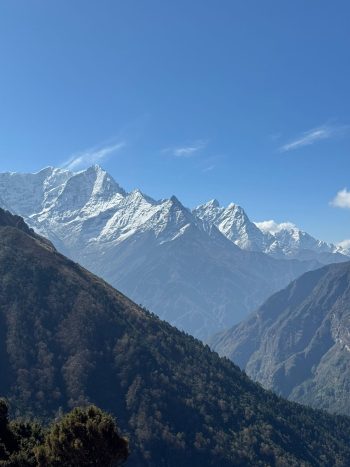
The view from the Cave of Blissful Attainment at Lawudo where both Lawudo Lamas have practiced.
It’s difficult to express the preciousness of the experience of a Lawudo pilgrimage, the depths of gratitude that arises in the heart to our teachers, the joy of entering into the hidden valley of Khumbu, and the special group feeling that arises from being together with other disciples of the lama, sharing, and doing prayers and practices together. Deepest gratitude to all who helped make this happen.
Ven. Sarah Thresher met Buddhism in 1982 at Kopan and almost immediately began working for Wisdom Publications editing and preparing Dharma materials. In 1986, after ordaining in Bodhgaya with His Holiness Dalai Lama she made her first trip to Lawudo. She has traveled and taught around the world, but her special focus is preserving and spreading the teachings, practice, and chanting lineage of Lama Zopa Rinpoche. In 2023/4 she has spent eight months in retreat and pilgrimage at and around Lawudo and looks forward to sharing the magic of Khumbu with others.
Interested in a trek to Lawudo this year? Join Ven. Katy Cole for a fifteen-day Himalayan adventure from October 6-21, from Kopan Monastery to Lawudo Gompa and back. Please learn more about this opportunity.
Foundation for the Preservation of Mahayana Tradition (FPMT), is a Tibetan Buddhist organization dedicated to the transmission of the Mahayana Buddhist tradition and values worldwide through teaching, meditation and community service.
- Tagged: lawudo, lawudo pilgrimage
9
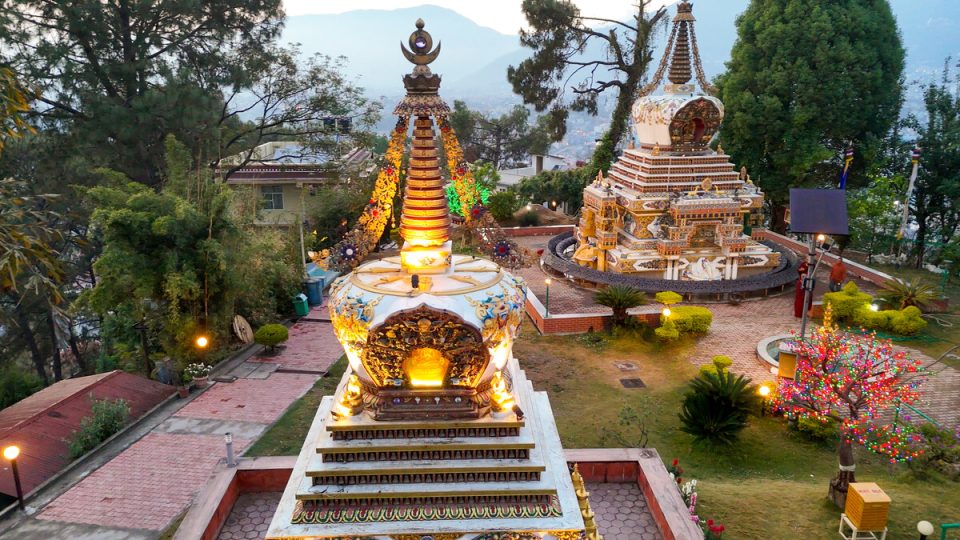
Beautiful early evening lights in the stupa garden, Kopan Monastery. Photo by Capucine T. Dekyong.
Introduction | Reunited and Establishing Our Motivation, April 6 |
Our History, Our Legacy, and the BIG Announcement, April 7 | The Tracks and Break-Out Groups, April 8-9 |
The Vast Visions, Compassion in Action, April 10 | Integration and Next Steps, April 11 |
A Deeply Connected Community | Photo Gallery
By Carina Rumrill
“It’s been so long!” was heard frequently as 195 individuals from 70 FPMT centers, projects, and services greeted each other with hugs and huge smiles upon arrival from 25 different countries at Kopan Monastery, Nepal, for the 2025 CPMT Summit: Advancing Our Gurus’ Vision of a World Guided by Compassion and Wisdom. Indeed, it had been “so long,” eleven years in fact, since the last CPMT meeting was held at the Great Stupa of Universal Compassion in Bendigo, Australia.
In addition to old friends and colleagues reuniting after so many years, many people were meeting close connections for the first time in person. Heart-warming expressions of recognition were shared abundantly— “Oh! So that’s you! It’s so good to finally meet you!” Friends were not only so delighted to see each other, but also so happy to be at Kopan. For many, this was the first pilgrimage in this life to the heart location of the FPMT organization—established at Kopan fifty years ago this year—and for others this was their first time back in many years. In either case, the gathering of this particular body of participants (FPMT directors, regional and national coordinators, spiritual program coordinators, study group coordinators, affiliate board members, key staff, and registered teachers), in this particular, most blessed and significant place (Kopan Monastery, the start of it all) was extremely meaningful.
For six agenda-packed days, participants energetically discussed, debated, dreamed, shared struggles and successes, commiserated and rejoiced, collaborated, planned, and strengthened connections old and new.
A more detailed and data-driven report of the findings, conclusions, and next steps established by this momentous meeting will be shared once all the surveys, reports, transcripts, and minutes from group discussions have been thoroughly analyzed. Meanwhile, I hope you will enjoy an overview of the activities that framed the 2025 CPMT Summit. Please also don’t miss this special photo gallery of the event.
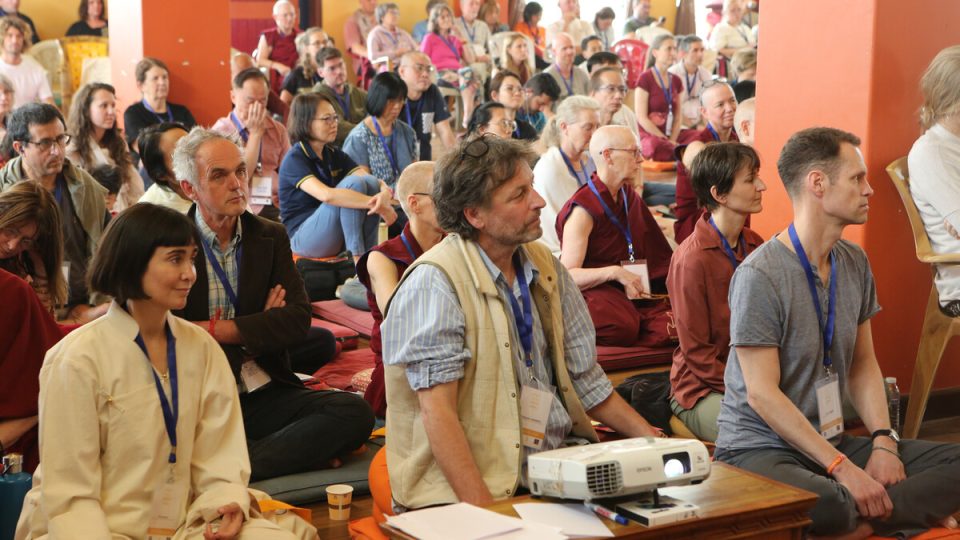
Kopan SPC Francisca, IOF COO François as well as Jeff, head of FPMT Education Services in a packed Chenrezig Gompa. April 7, 2025. Photo by Capucine T. Dekyong.
Reunited and Establishing Our Motivation, April 6
On the first evening, April 6, travel-tired students packed into the Chenrezig Gompa after a nourishing group meal in the dining hall. The lunch and evening meals for the entire week were generously sponsored by Amitabha Buddhist Centre, Singapore; and the breakfasts were provided by Losang Drakpa Centre, Malaysia. The excitement in the gompa was electric and many of us found it difficult to resist rubbernecking around the room looking for old friends.
FPMT Inc. Board member, Paul de Wys, greeted the crowd warmly as we all found our seats. She teared up as she shared, “I think that this group, coming to work together, people who have been offering service for so long, who can contribute so much, to be here with one another at Kopan looking to the future of the organization, is something that would make Lama Thubten Yeshe and Lama Zopa Rinpoche very, very happy. So … my thanks to you.” Paula then invited Khenrinpoche Geshe Chonyi, Abbot of Kopan Monastery and FPMT Inc. Board member, to address the group.
“I think it is so important that everyone has come together, to work together united to fulfill Rinpoche’s wishes. I look forward to having a meaningful and productive CPMT meeting.” Khenrinpoche Geshe Chonyi also led the motivation for the week ahead.
Another of the six FPMT Inc. Board members, Ven. Pemba Sherpa, shared a letter of support and encouragement for the meeting from His Holiness the Dalai Lama, which also provided an auspicious framing for the week to come:
“I am pleased to know that representatives of all the centers belonging to the Foundation for the Preservation of the Mahayana Tradition (FPMT) in different parts of the world will be meeting in Kathmandu, Nepal, to discuss the future direction of the organization.
“First of all I want to recall the contribution your founder teachers, Lama Yeshe and Lama Thubten Zopa have made to the Dharma. Through this organization they have enabled many people to appreciate the potential of the Buddha Dharma to contribute to the wellbeing of sentient beings. Since 1979 at their request I have also given teachings to your members on many occasions – so we have established a special bond with each other.
“Since both Lama Yeshe and Lama Zopa have now passed away, it is appropriate that you discuss the future direction of your community. Soon after Lama Zopa passed away, members of the FPMT Board came to see me. One of the issues they raised was the future of the organization. As I understand it, the FPMT has a sound structure, with teachers and prominent disciples holding leadership positions, which you can reinforce on the basis of discussion and agreement. As I told them, I will continue to offer the FPMT encouragement and support in your service to benefit others.” Please read the full letter.
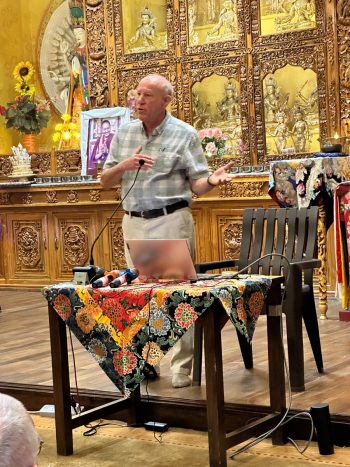
FPMT Inc. Board Chairperson Karuna Cayton addresses the CPMT group. Photo by Harald Weichhart.
Chairman Karuna Cayton addressed the group, introducing the various board members and the qualities, diversity, and expertise they bring to the organization, and remarked that this was the biggest turnout for a CPMT meeting ever, “capturing the magnitude of what we are trying to accomplish.”
Facilitator Jennifer Kim, director of Shantideva Center in New York, USA, also offered an overview of how the Summit would be structured and how the topics chosen to be discussed were selected. She explained that the surveys circulated at the end of 2023 to all FPMT centers, projects, and services; as well as regional consultations held in 2024 in Europe, Asia, Australia, America, and within FPMT International Office, had provided extensive layered data concerning the concerns and key areas of need for discussion within the organization. This pre-work for the Summit took the organizing committee over a year to gather and process in order for the agenda to be as informed as possible.
She explained that three layers, in general, would be covered during the meeting. The core, or first layer, was identified as the Dharma Education of the organization, preserving the unique legacy of teachings from Lama Yeshe and Lama Zopa Rinpoche and also bringing this lineage into a modern context. The next layer was described as the organization itself: the roots, or the structure, upon which all of our services are offered. And finally, the outer layer is symbolized by the wider community, the world outside that desperately needs our help. This includes what we are doing now in terms of the Vast Visions of our lamas, and what we can do going forward to help these visions flourish.
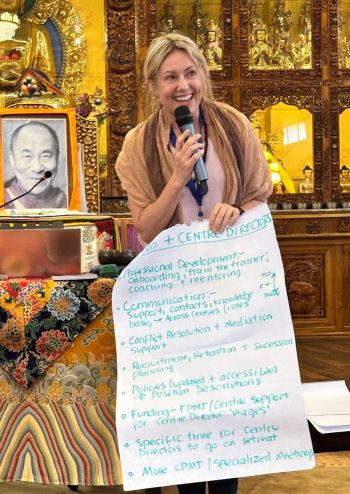
Chenrezig Institute director Emanuelle Jones presenting notes from her break-out group. Photo by Capucine T. Dekyong.
Jennifer introduced the seven tracks that would be explored during the first full two days of the Summit:
- More Experiential & Applied Dharma
- More Approachable & Inclusive Dharma
- Effective Use of Technology
- Promotion & Communications
- Professional Development & Collaboration
- Sustainability
- Protection from Abuse
FPMT International Office COO, Center Services and Teacher Services Director, Francois Lecointre, one of the organizers of the Summit, shared some opening remarks including, “This is really your CPMT. This meeting will be what you choose to do with it. Of course, we will have many sessions and it’s going to be a bit intense. I hope you will not be overwhelmed, I know many of you have come very far and are very tired. But it’s not only the sessions here at the CPMT meeting. This is a family reunion. This is a place for this family feeling to be nourished and for us to recharge with the family. I encourage you to make the most of it. See old friends but also make new friends.”
Director of FPMT Education Services and one of the organizers of the meeting, Jeff Highfill, also greeted participants and offered some “ice breakers” for all to engage in. He didn’t have to ask us twice! Immediately people were enthusiastic about engaging with those sitting next to us, and the whole gompa was buzzing with laughter and energetic exchanges. “I think we are fully thawed out now!” Paula de Wys joked.
A beautiful short video of Lama Zopa Rinpoche teaching on bodhichitta was shared, fully establishing a wonderful motivation for the whole event and reminding everyone about Rinpoche’s core teaching, “We must generate bodhichitta in our minds in this life. That should be the main aim of living life, do you understand? What are you living your life for? Why? The aim should be bodhichitta. To generate bodhichitta in this life, everything should be for that. So, whenever you collect merit, dedicate for that. Jangchub semchog, that is why we dedicate with that.”
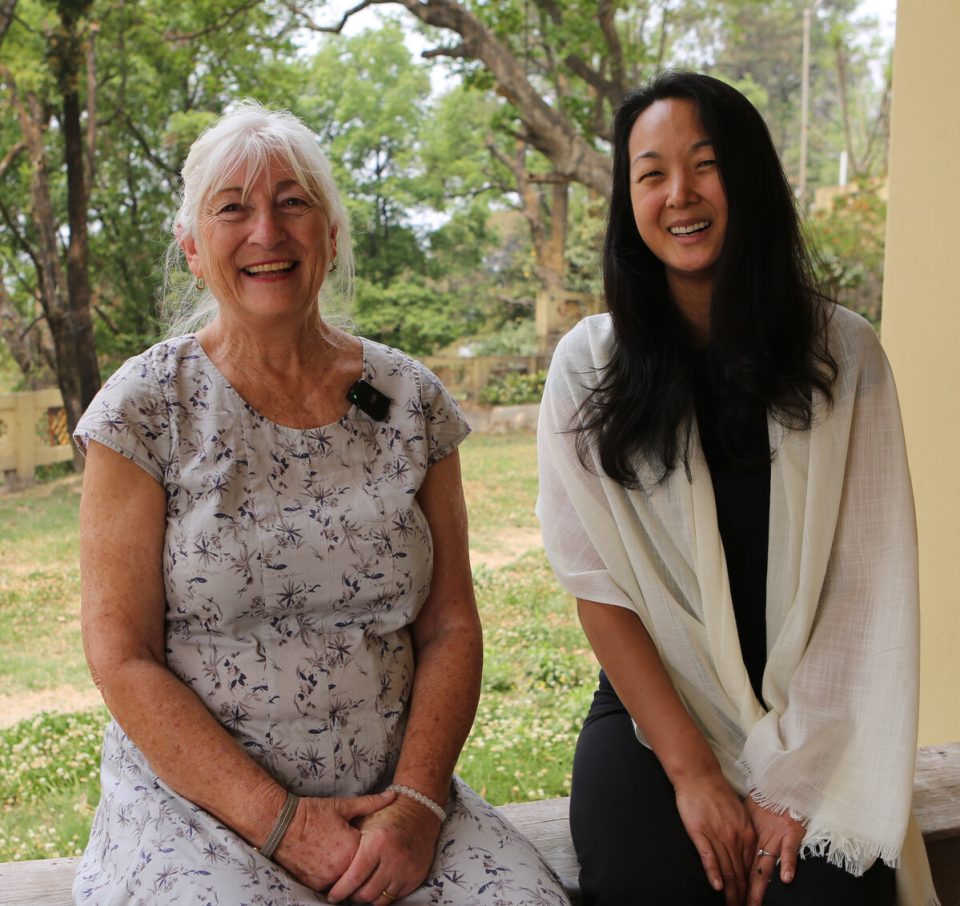
FPMT Inc. Board member Dale Davis and CPMT Summit Facilitator, Jennifer Kim. Photo by Capucine T. Dekyong.
FPMT Inc. Board member Dale Davis addressed the group, welcoming everyone and overviewing what we should expect over the days to come. Francisca Riaño, SPC of Kopan Monastery, graciously greeted and welcomed the group and went over some practical information about staying at Kopan.
After a quick Q & A with participants, Ven. Joan Nicell led a moving dedication, really sealing all the incredible energy generated on this first night together. Exhausted from travel, most of us returned to our dorm rooms to get acquainted with our roommates, unpack, and settle into our new homes for the week.
Our History, Our Legacy, and the BIG Announcement, April 7
The first full day of the Summit was dedicated to understanding and appreciating the unique history of the FPMT organization, and familiarization with the current structure and challenges of successfully moving the organization forward into the future. We were treated to several talks from some of FPMT’s beloved legends and received the joyful news that His Holiness the Dalai Lama had confirmed the rebirth of Lama Zopa Rinpoche’s incarnation in Nepal. What an auspicious start to the event!
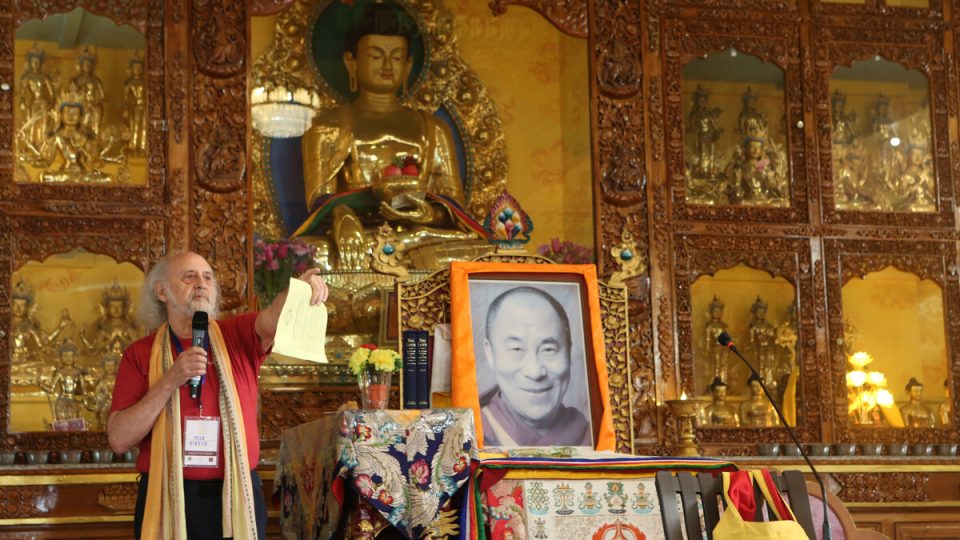
Nick Ribush discussing the early years of the FPMT organization, April 7. Photo by Capucine T. Dekyong.
The first speaker of the day was Dr. Nicholas Ribush, who is known widely in the organization not only for his contributions to preserving the legacy of our founding lamas, but also for his superb institutional memory. “Good morning. My name is Nick, and I’m a Dharmaholic,” he joked. You could sense the entire gompa relaxing with comfort and ease as Nick warmly shared many precious details and an overview of FPMT organizational history, painting a picture of the richness, magic and absurdity of some of the stories from the early years.
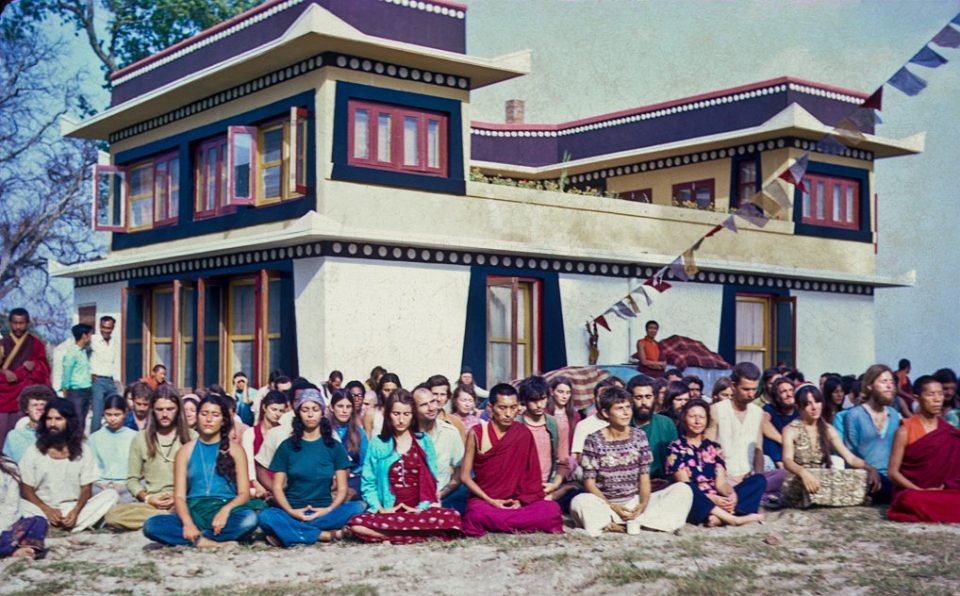
Lama Zopa Rinpoche in a group photo from the Fourth Meditation Course, Kopan Monastery, Spring 1973. Photo courtesy LYWA Collection.
In 1972, Nick arrived at Kopan Monastery in Nepal. After attending the Third Kopan Course, he offered to help Lama Zopa Rinpoche revise Rinpoche’s The Wish-Fulfilling Golden Sun of the Mahayana Thought Training, which served as the teaching text for the course. Rinpoche accepted the offer, and for several years Nick lived at Kopan, attending the month-long courses, working on revisions to The Wish-Fulfilling Golden Sun, and editing notes and transcriptions from Rinpoche’s teachings into course commentaries. After many years of offering service to a variety of FPMT activities, including Wisdom Publications, Nick founded the Lama Yeshe Wisdom Archive in 1996. After the event, Nick shared:
“It has been a great privilege to attend my 18th CPMT, especially since it was held at Kopan. Sadly, however, it was the first without the presence of either Lama Yeshe or Lama Zopa Rinpoche. Nevertheless, to be with 180 or so fellow FPMT students, all working cohesively with energy and devotion to maintain and develop our precious Lamas’ vision for the enlightenment of all sentient beings, has been a wonderful experience.
“It was the first global FPMT meeting in about eleven years, which is far too long between CPMTs, and I hope from now on we will be able to hold them regularly, perhaps every two years at Kopan. Sincere thanks to the organizers and all my FPMT colleagues for creating such a memorable event.”
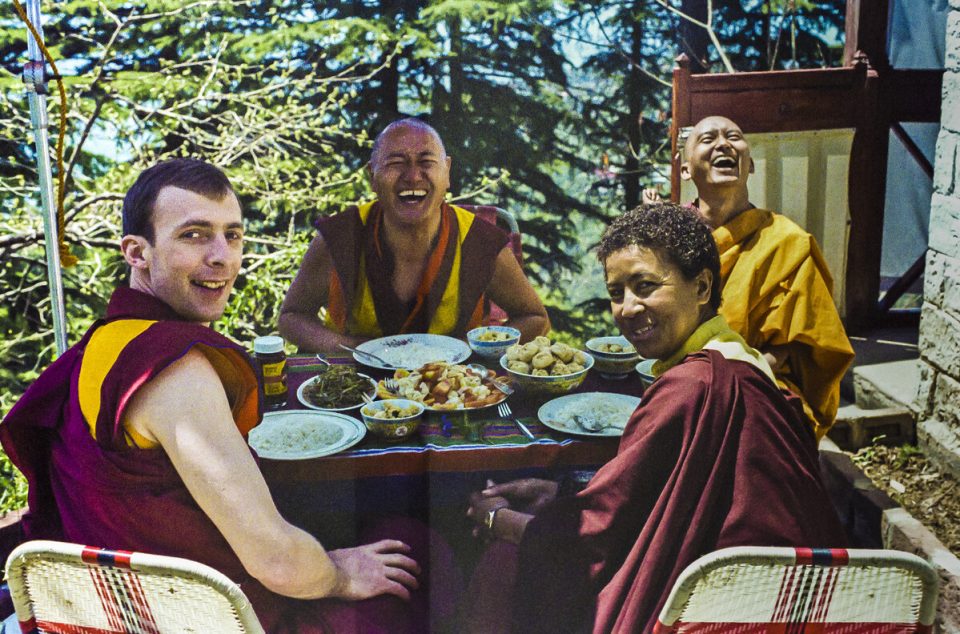
Peter Kedge, Lama Yeshe, Max Mathews, Lama Zopa Rinpoche at the First Enlightened Experience, Tushita Meditation Centre, India, 1982. Photo courtesy of LYWA collection.
Next, Peter Kedge, early student of the lamas who arrived in Nepal in 1971 and Kopan specifically in 1972 and worked closely with Lama Yeshe for twelve years prior to his passing, spoke to the Summit. Peter has been instrumental in the development of the FPMT organization and was involved in so many FPMT activities including as an FPMT Inc. Board member, and former director and CEO of the Maitreya Project. Peter joined the group over livestream from Canada and shared some additional history of the organization, stories of the lamas from the early days, and recognized some of the remarkable people who helped shape, support, fund, and establish FPMT in the early years. This is always a key message of Peter’s to really acknowledge those who selflessly gave so much of themselves to help make the lamas’ vision a reality, the “heroes,” who “hold up the sky for FPMT” as he says, including Tibetans, local Nepalis, and Westerners, particularly in the very difficult early years. Peter also discussed the challenging and pivotal time following Lama Yeshe’s passing.
One particularly interesting point Peter shared was how, when the lamas first started traveling the world, outside of India and Nepal, in 1974 and 1975, they would always come back through India and stop in Dharamsala in order to make a full written report to His Holiness the Dalai Lama. “Rinpoche has explained, several times, that our Boss is His Holiness. And that’s still the case,” Peter said.
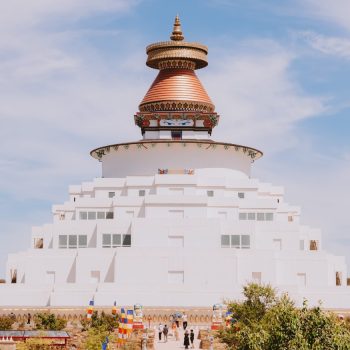
The Great Stupa of Universal Compassion, Bendigo, Australia. Photo courtesy of The Great Stupa.
“Lama was into absolutely everything,” Peter explained. “He was also very concerned with how people managed the centers. ‘The purpose of centers is to serve,’ he would say. He was very concerned about the phenomenon of groups of people in the centers becoming like a club. Lama would say, ‘This is not a club. This is not a nightclub. The purpose is to serve.’ He also said he’d rather that centers be empty than become like soup—a mixture of too many things.”
Ian Green, a long-time student of both Lama Yeshe and Lama Zopa Rinpoche, has served FPMT and the Dharma only in big ways: as a founder and director of Atisha Centre in Bendigo, Australia, as the chairman of various FPMT-related boards, and as the director of two of FPMT’s biggest holy object projects: the Great Stupa of Universal Compassion and the Jade Buddha for Universal Peace. Ian read from his new book, Monumental: The Story of the Stupa.
Ven. Elisabeth Drukier, director of Kalachakra Centre, presented next. Ven. Elisabeth is an early French student of the lamas who came to Kopan in 1974 and stayed for the next five years, ordaining in 1976. Ven. Elisabeth was instrumental in establishing Institut Vajra Yogini, Nalanda Monastery, and Kalachakra Centre in France. She shared stories about Kopan and Kathmandu in the early days of the FPMT organization and shared some of her own personal story making her way to Kopan for the first time. “Lama Yeshe had a talent for picking up people and giving them responsibilities. You didn’t know really you were capable of doing what he asked, but he knew. He knew.”
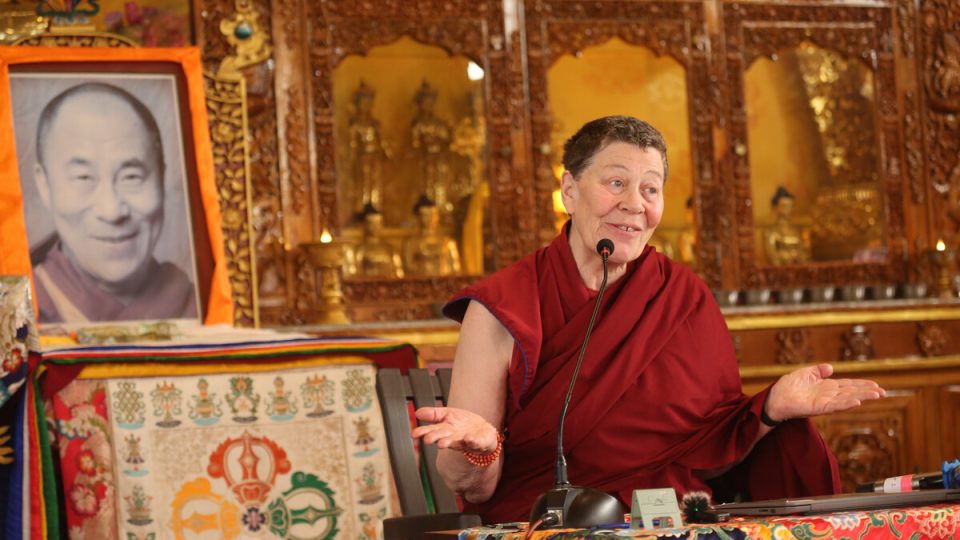
Ven. Elisabeth Drukier addressing the group about the early years of FPMT, April 7, 2025. Photo by Capucine T. Dekyong.
Ven. Roger Kunsang next discussed the early years of the organization including the period when Lama Zopa Rinpoche reluctantly took over leadership following the passing of Lama Yeshe. Ven. Roger is CEO of FPMT International Office, FPMT Inc. Board member, and was the attendant to Lama Zopa Rinpoche from 1986 until Rinpoche showed the aspect of passing away in 2023. Ven. Roger’s talk included an overview of the evolution of Rinpoche’s “office” (now known as FPMT International Office).
Khenrinpoche Geshe Chonyi offered a history and some personal stories of Kopan from the very early days. Khenrinpoche joined Kopan Monastery after being ordained by Lama Zopa Rinpoche in 1974. He studied at Kopan for six years then went to Sera Je Monastery in South India and continued another 18 years of intensive study and debate in Buddhist Philosophy. Khenrinpoche was awarded the title of Geshe Lharampa, the highest Tibetan Buddhist doctorate conferred in the Gelug monastic tradition. Khenrinpoche is currently abbot of Kopan Monastery and Kopan Nunnery, and resident geshe at Amitabha Buddhist Centre (ABC), Singapore.
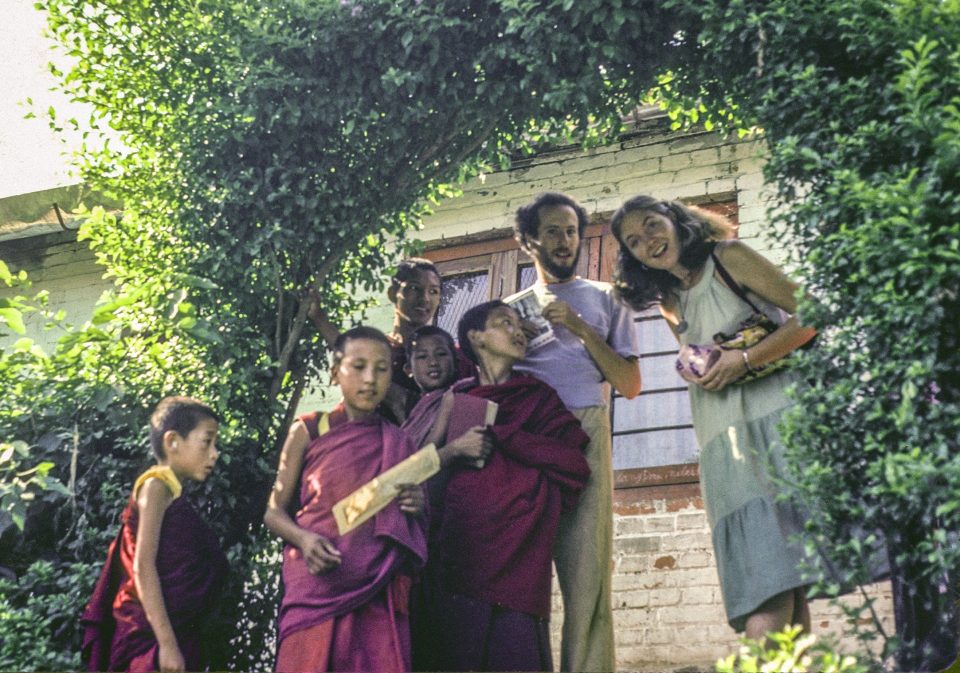
Karuna Cayton at Kopan Monastery, 1978, with the young monks and Jacie Keeley. Photo courtesy of the Lama Yeshe Wisdom Archive.
Karuna Cayton, early student of the lamas who lived at and helped manage Kopan Monastery from 1978-1988, and current chairperson of the FPMT Inc. Board of Directors, discussed Lama Yeshe’s wishes for a thorough education of the monks and his active role in establishing the educational structure during his time at the monastery. Karuna also discussed several challenges currently facing the FPMT organization, including recent events involving Osel Hita.
Geshe Sherab, headmaster of Kopan School, further discussed the development and evolution of the academic education system at Kopan, the importance of sustaining the Sangha community, and the need for integration of modern education with the traditional monastic education.
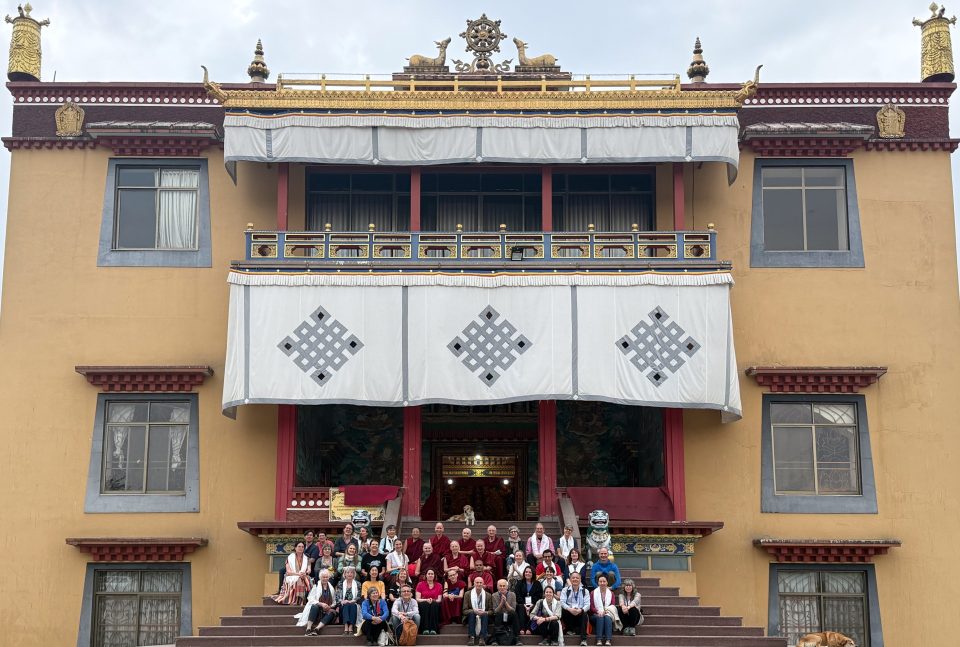
CPMT participants visiting Khachoe Ghakhyil Ling Nunnery (Kopan Nunnery), April 11. Photo by Capucine T. Dekyong.
Ven. Thubten Dekyong (known as Ani Tsenla) had everyone laughing and engaged with her energetic stories about her role in the history of Khacho Ghakyil Ling (Kopan Nunnery), located just under a half of a mile from Kopan Monastery. She shared the story of how she slowly came to the realization that Lama Zopa Rinpoche wanted her to take responsibility for the nunnery. This suspicion was sealed after she was invited to lunch by Rinpoche in the mid-1980s. “Whenever you get invited to a meal, you know … that’s a project coming. So I knew I was getting the [nunnery].”
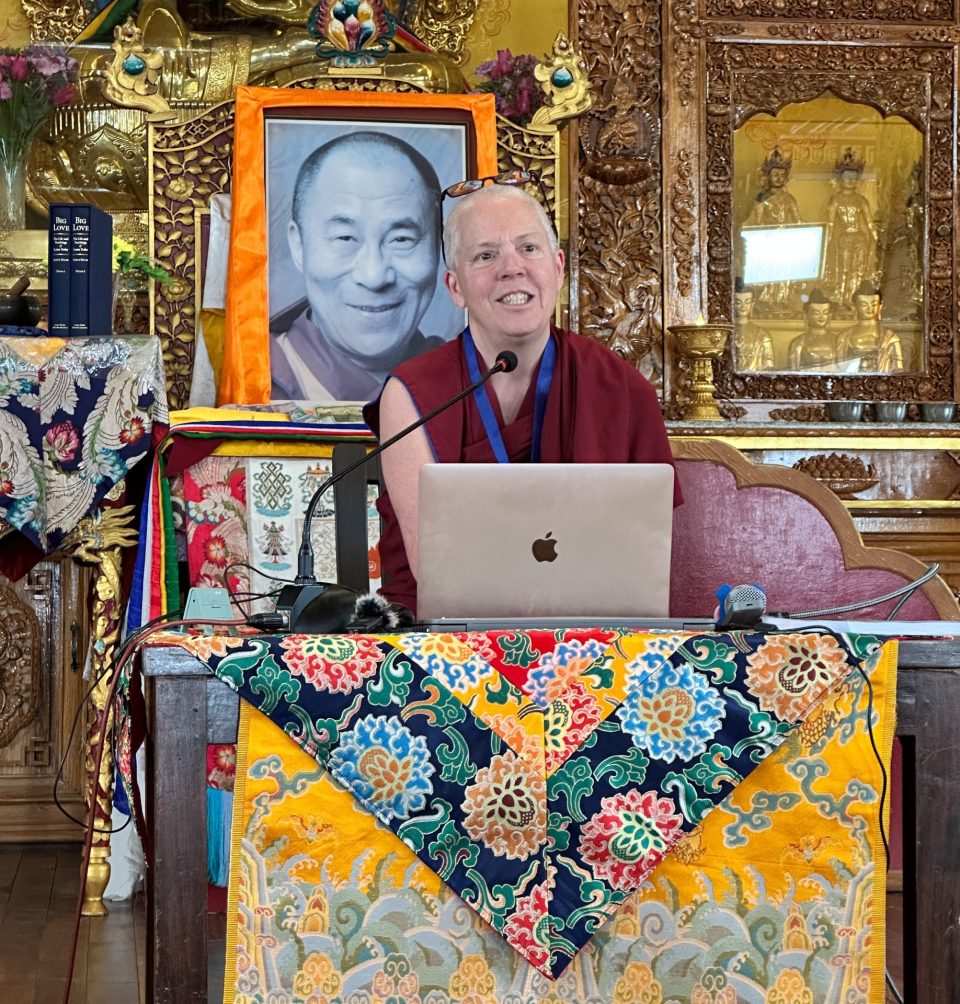
Ven. Joan Nicell presenting, April 7, 2025. Photo by Harald Weichhart.
Ven. Joan Nicell, who first attended the Kopan November course in 1987, and ordained in 1989, provided an overview of the courses at Kopan and their evolution. Ven. Joan helped set up the first Masters Program at Istituto Lama Tzong Khapa in Italy, and has worked as a translator of Tibetan texts, as an editor, and as a live transcriber of Lama Zopa Rinpoche’s teachings. She presently lives and teaches at Kopan. Ven. Joan shared that Kopan has been most successful in offering courses to beginners. Last year’s November Course included an 88-year-old student as well as two 18-year-olds, illustrating the range of participants who come from all over the world. She shared, “One thing that’s special about Kopan, and also Tushita, is that many young people come here.” Ven. Joan also offered a beautiful tribute to Ani Karin Valham, who was not well enough to offer this talk herself and asked Ven. Joan to offer it on her behalf. Ani Karin attended her first Kopan course in 1974 and ordained in 1976. She began leading meditations for the November Course in 1978 and began teaching actual courses at Kopan in 1985. Ani Karin is one of those true treasures we have within the FPMT organization, who has selflessly given her life to serving others through teaching the Dharma and it was extremely moving to hear Ven. Joan share a bit of Ani Karin’s story so we could appreciate her rich contributions.
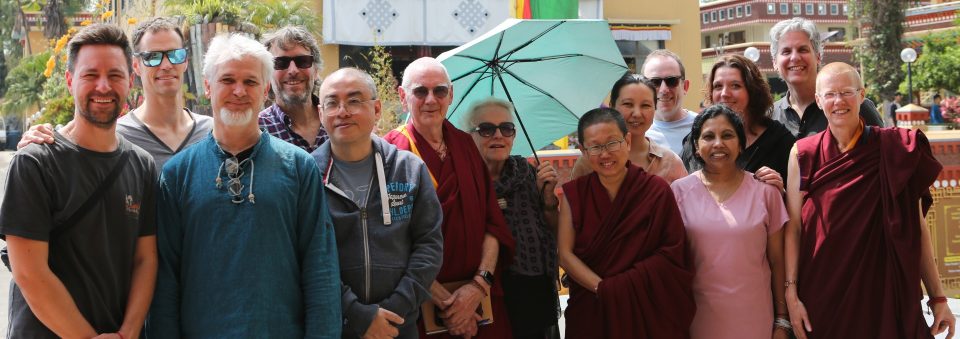
FPMT International Office Staff, Kopan Monastery following a staff meeting, April 12, 2025. Missing: Adam Payne and Justin Jenkins who could not attend the CPMT Summit. Photo by Capucine T. Dekyong.
In the afternoon, FPMT International Office was introduced and gave a brief outline of their various roles within the office. The office staff had not been together in person as a group for nearly seven years, and some staff had never met one another in person at all, so this meeting was important, and essential, for us.
After lunch, Ling Rinpoche joined by livestream and warmed everyone’s hearts with his message about the lamas’ legacy:
“One of our main aims is to follow the advice and wishes of His Holiness the Dalai Lama, and also the founder of FPMT, Lama Thubten Yeshe. Although he was a very simple monk with a very sincere wish to benefit sentient beings and the Dharma, he worked so hard for so many years to teach many students and to establish the roots of the organization. And his very heart disciple, Lama Zopa Rinpoche, carried on this work in such a tremendous and excellent way. The two of them were wonderful examples, Lama Yeshe and Lama Zopa Rinpoche, who worked very hard for so many years to establish the FPMT organization in order to benefit the Buddha’s teachings in general, and to share the Tibetan lineage of Buddhism and to spread it all over the world, especially to many places where even the word ‘Buddhism’ had never been heard before. So it’s really something wonderful they have done and that we continue to do now.”
The big news of the day was the announcement that His Holiness the Dalai Lama had recently confirmed that Lama Zopa Rinpoche’s incarnation has been born and is living in Nepal. This was a truly joyous moment for all. The FPMT Inc. Board of Directors then took some time to discuss spiritual leadership within the FPMT, and to update on some expected changes to the structure moving forward.
Ven. Sarah Thresher shared her vision for preserving Lama Zopa Rinpoche’s lineage and repaying the kindness of our spiritual friends. Ven. Sarah met the Dharma in 1982 at Kopan and almost immediately began working for Wisdom Publications editing and preparing Dharma materials. In 1986, after ordaining in Bodhgaya with His Holiness Dalai Lama she made her first trip to Lawudo. She has traveled and taught around the world, but her focus is preserving and spreading the teachings, practice and chanting lineage of Lama Zopa Rinpoche. Ven. Sarah really emphasized that Rinpoche left this incredible wealth of teachings “for US!” and we all have the responsibility to put into practice what Rinpoche advised and to preserve this most extraordinary lineage. Ven. Sarah shared three important aspects of preserving this lineage: The collected writings, the practice lineage, and the heart advice/pith instructions. Ven. Sarah also shared several proposed ideas for how we can do this. Following on this, Geshe Legtsok reminded us about the uncommon qualities of our lineage lamas. He discussed the need for following the guru’s advice (individually and organizationally).
About the event, Geshe Legtsok shared:
“After being inspired for years by news from all corners of the FPMT of people doing retreats, offering educational programs, building holy objects, supporting charitable projects and much more, it was a privilege to meet many of these people in person for the first time all at Kopan, the mothership. The kind-heartedness, commitment to serving the Dharma and sentient beings, and depth of experience was palpable in all. With each person I met it felt as though we could have spent hours getting to know each other better and sharing ideas to further our respective practice and endeavors. I came away more confident than ever in the integrity of the FPMT and the shared pure intention for our mission in the world. How fortunate to be part of this community of such good people with such a profound purpose!”
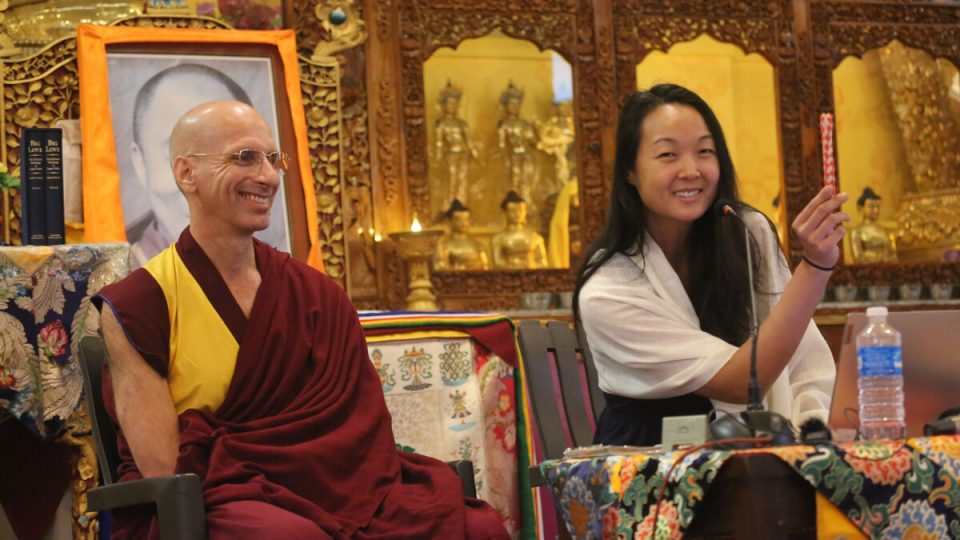
Jennifer Kim presents a small toy to CPMT participants. They had to figure out how to collaborate to easily get it off their fingers again. Hint: collaboration and moving together is key. April 7, 2025. Photo by Capucine T. Dekyong.
Geshe Legtsok then joined facilitator Jennifer Kim in a discussion on “polarities” with an enjoyable group exercise using a Chinese finger trap, which was used as a metaphor to encourage us to shift our mindset from one of resistance and struggle to one of acceptance, willingness, and collaboration.
The Tracks and Break-Out Groups, April 8-9
Our passive experience of enjoying the informational presentations came to an end on Day 3 as we embarked on the “track” section of the Summit for the next two days where participants engaged in topic-focused breakout groups to address issues identified in the surveys and consultations from earlier in the year.
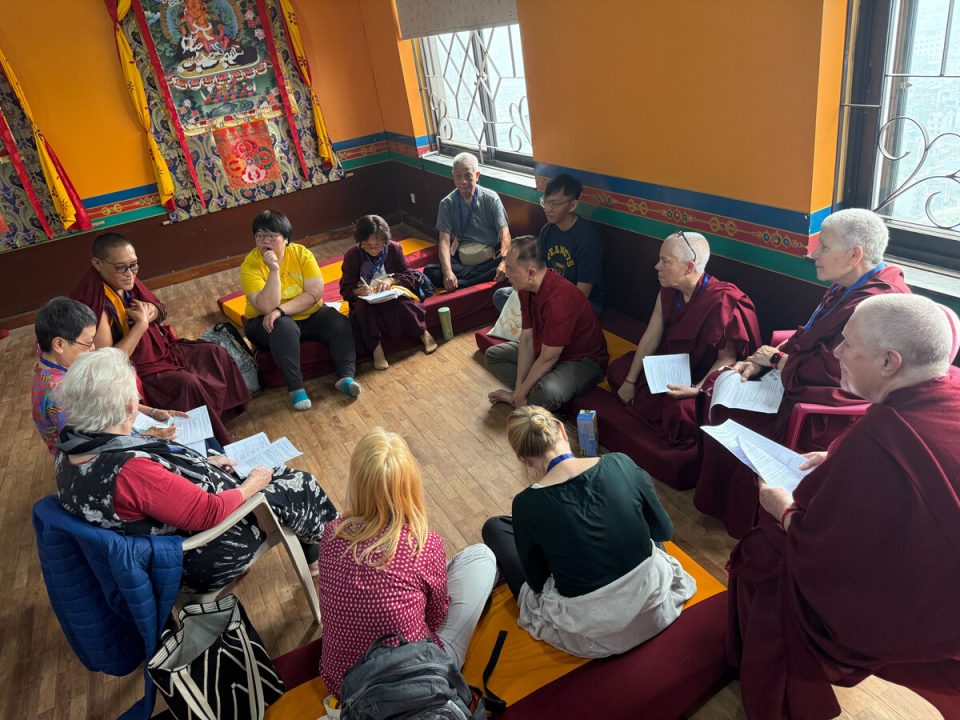
Groups discussing the topic “More experiential and applied Dharma” at CPMT 2025. April 8, 2025. Photo by Capucine T. Dekyong.
On the first day of the breakout group sessions, Strengthening Education was explored, and participants were asked to choose one of four tracks: More Experiential & Applied Dharma, More Approachable & Inclusive Dharma, Effective Use of Technology, and Promotion & Communications.
On day two of the breakout sessions, the theme of Strengthening the Organization was discussed in small groups through tracks on Professional Development & Collaboration, Sustainability, and Protection from Abuse.
Each track met in different locations to discuss thoroughly the topics after an opening presentation from the facilitators. Following the group discussion, conclusions and key points of discussion were presented by each track to the full group of participants, followed by lively Q & A discussions.
These discussions weren’t always easy. Many of the topics discussed are quite personal for those serving in various key roles throughout the organization, and passionate opinions and concerns can be challenging to navigate, particularly if one feels criticized for their own work or the work of colleagues, or if expectations are not aligned between groups which can lead to disappointment. In general, even during heated debates, participants displayed good faith in one another and reached mutual understanding or at least a shift in view from one’s own solid perception.
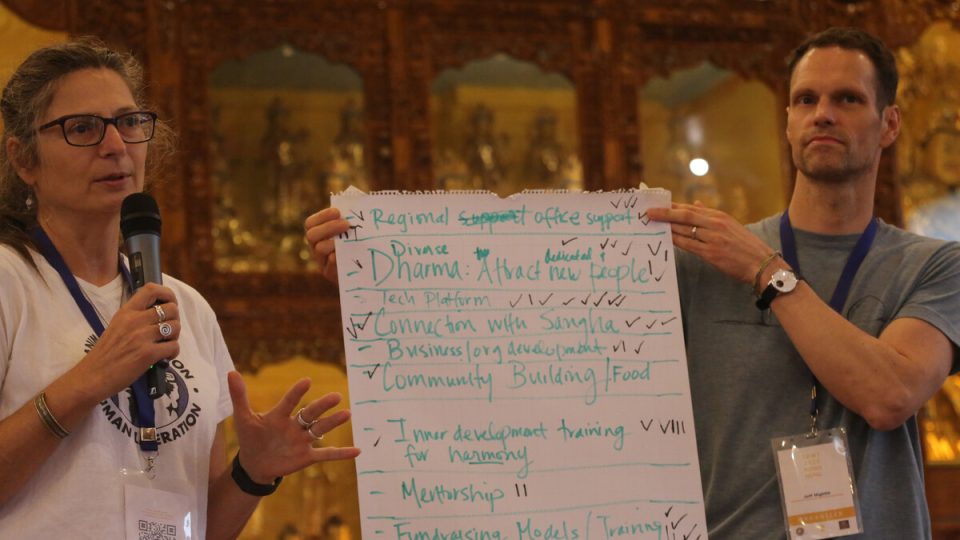
Tania Duratovic presenting from her break-out group discussion on April 9, 2025. Jeff Highfill holds her notes. Photo by Harald Weichhart.
On the evening of April 8, Geshe Tenzin Zopa offered a very moving talk about how to think when the guru is no longer physically with us.
Geshe Zopa praised the FPMT centers and students: “The dedication and the service, is unbelievable. It’s absolutely in accordance with Lama Yeshe and Kyabje Zopa Rinpoche’s vision … Very much all of you, it’s so heart-touching, so inspiring, whatever was taught in the lamrim about guru devotion such as the Fifty Verses of Guru Devotion—each and every one of you embody those teachings exactly. If not more. It’s unbelievable, really. So, my point is, if you want to focus on all this greatness, there are numberless examples, numberless. But if you want to focus on the negative side, we’re in samsara. And not only outwardly, but it’s the result of the collective karma of the samsara beings, but also, our mind is not yet purified. I don’t know about you, but at least for me … the mind is not purified, hallucinated, dualistic, delusional—and in the eyes of delusion, you see that everything is not right. Everything is false. Even when something is right, you see wrong. … But really we have so much in which to rejoice. We are so lucky. Really, so lucky.”
Geshe Zopa also shared so many hilarious and inspiring stories about Lama Zopa Rinpoche—his tireless activities taking care of every single being—be it one frog, a group of ants, a cow, or any single human—in his path at all times, day or night, the prayers, the mantras, the practices, the offerings, the patience to endure difficulties, the joyous effort Rinpoche displayed serving sentient beings. “There’s no way we can even fathom Rinpoche’s qualities,” Geshe Zopa said.
FPMT Australia Education Coordinator, Stephanie Brennan shared:
“It was such a delight to meet the people working for FPMT across the globe that had only been names on the end of an email address before. There was a genuine feeling of goodwill and happiness. There was also space for debate and discussion, which was so important. People weren’t afraid to express themselves and this led to moments of breakthrough and creative suggestions. Following the joyful news from His Holiness the 14th Dalai Lama that Kyabje Zopa Rinpoche had been reborn, there was great joy and emotion. I left with a feeling of confidence and expanded relationships.”
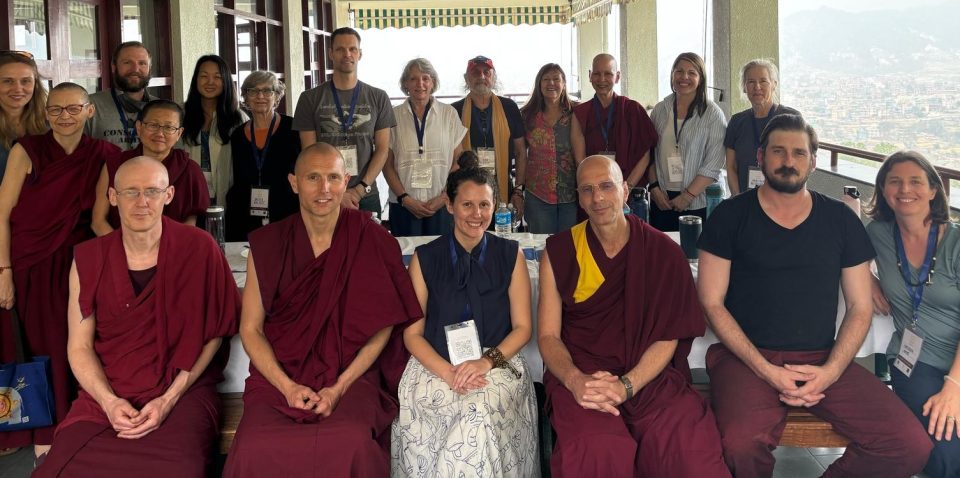
On April 8, participants took advantage of being together and gathered for a North American Regional Lunch at the Kopan dining hall. Photo courtesy of FPMT North America.
FPMT East and Southeast Asia Regional Coordinator, Selina Foong shared:
“This CPMT summit has been a long time coming, and it was a true joy to meet so many of my dear dharma family from all over the world again. And to make new friends! The past few years have not been easy for FPMT, but I found much hope and inspiration in coming together at our beloved Kopan, to collectively chart the future. Moving forward, I hope and pray that we always have harmony. I also look forward to sharing more about our East & Southeast Asia region in the years to come, as the sheer energy and scale of events offered in this part of the world is something in which to truly rejoice.”
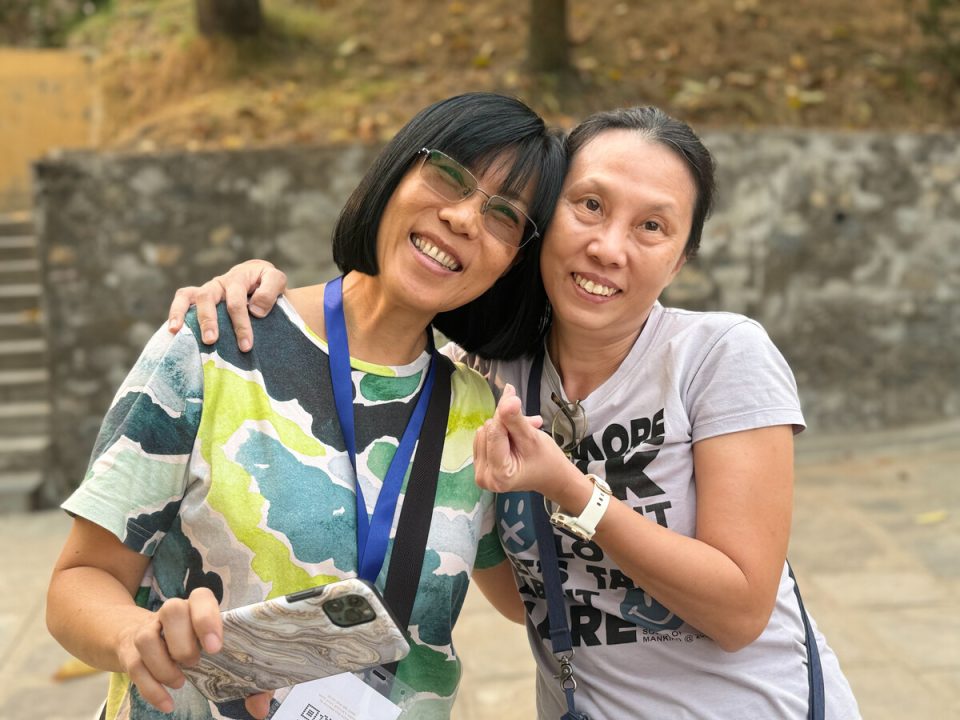
Regional Coordinator of FPMT East & Southeast Asia Selina Foong and Guat Cheng Koh, Amitabha Buddhist Centre SPC sub-committee member and registered teacher, April 8, 2025. Photo by Capucine T. Dekyong.
Newly appointed director of Chenrezig Institute, Australia, Emanuelle Jones reflected:
“What struck me most was the way this summit seamlessly blended the structure and depth of mainstream professional education with a deeply rooted commitment to inner development and global wellbeing.
“The format of the conference felt familiar—plenary sessions, breakout groups, targeted working sessions—mirroring the best of professional development in educational settings. Yet, unlike typical conferences, every discussion was grounded in the aspiration to cultivate compassion and ethical awareness.
“Whether we were exploring strategy, teacher training, pedagogy, or curriculum design, the conversations echoed the same rigor and intention you would find in leading educational institutions—but here, they were infused with the wisdom and the urgency of our shared responsibility to create meaningful change.”
Namdrol Adams, North American Regional Office Board Chair and President, and Maitripa College Dean, and Melissa Kaye, North American Regional Coordinator, shared in their report of the event:
“Repeatedly throughout the summit, regional and national offices were recognized as critical sources of support, implementation, and follow-through for the ideas and strategies generated at CPMT. In turn, coordinators emphasized the urgent need for expanded resources—people power, financial support, and active engagement from centers and projects—in order to meet these expectations and continue providing essential services to the global FPMT community.”
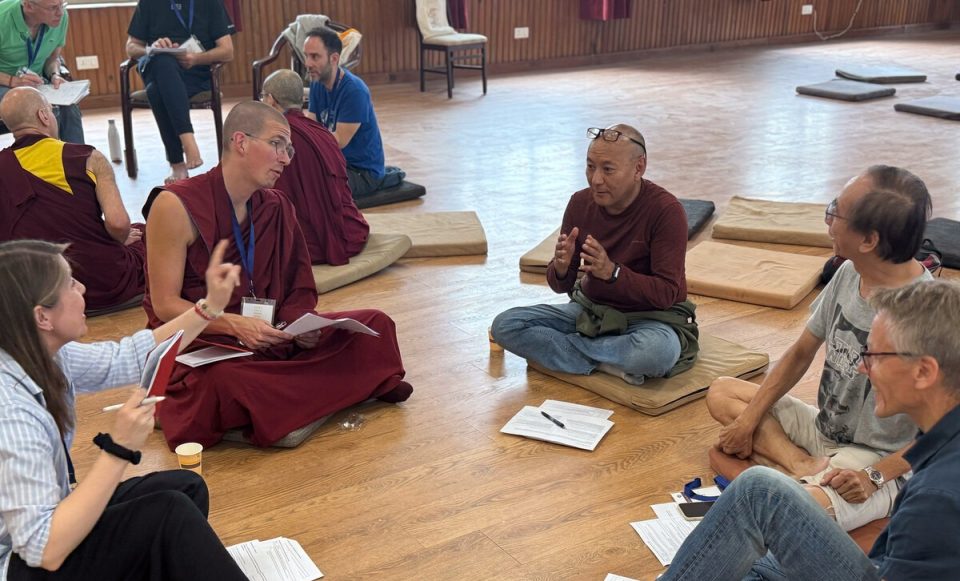
Lively discussions at CPMT 2025. April 8, 2025. Photo by Capucine T. Dekyong.
FPMT International Office will be sharing conclusions and action points from these sessions very soon—the team is collecting and processing all the valuable data collected from these discussions.
The Vast Visions, Compassion in Action, April 10
On the last full day of the meeting, Lama Zopa Rinpoche’s Vast Visions were discussed in a presentation by Ven. Roger Kunsang and Ven. Holly Ansett. It was incredibly powerful to hear from Ven. Roger, who was by Lama Zopa Rinpoche’s side nearly every moment from 1986 until Rinpoche’s passing into parinirvana in 2023, providing context for Rinpoche’s Vast Visions. These ambitious wishes for the organization were originally presented to Ven. Roger and Ven. Holly Ansett in 2007 on several blue sticky notes. From those sticky notes, Ven. Roger and Ven. Holly were able to identify four key areas: Offering Service to His Holiness the Dalai Lama, Creating and Displaying Holy Objects for World Peace, Supporting Practice and Realizations, and Social Services.
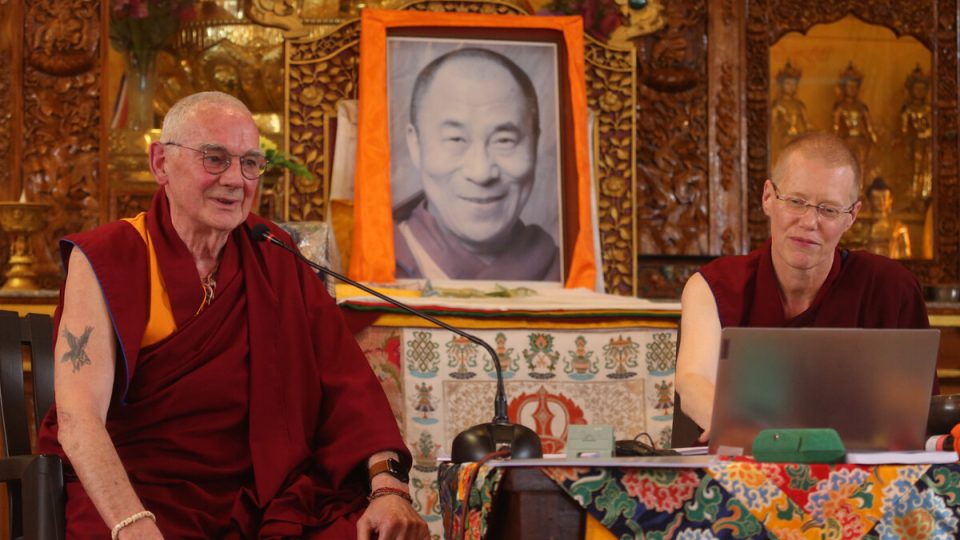
Ven. Roger Kunsang and Ven. Holly Ansett presenting Lama Zopa Rinpoche’s Vast Visions, April 10. Photo by Capucine T. Dekyong.
Ven. Holly presented each of Rinpoche’s Vast Visions in detail, outlining which visions are well underway in terms of actualization, and which projects still need energy and support. The sheer scope of each vision was incredible to see laid out, and it became so clear how much work we all must do to help make Rinpoche’s incredible wishes manifest, and to rejoice in how much has already been done. Prior to this presentation on the Vast Visions, inspiring stories and words of encouragement were shared.
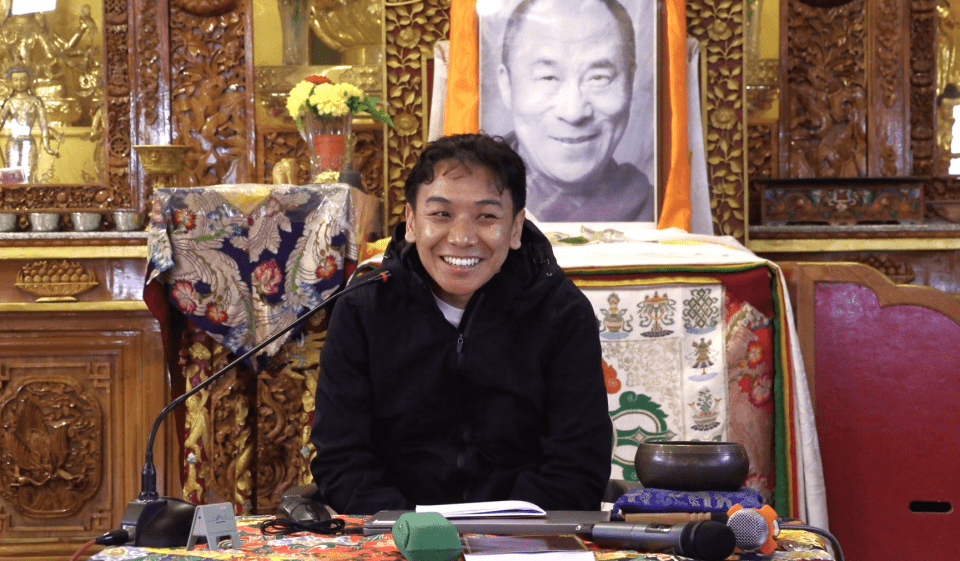
Charok Lama addressing the group, April 10, 2025.
Charok Lama began the day with an incredibly moving talk, reminding us that every action we engage in can be done with compassion, as was continually expressed by Lama Zopa Rinpoche. “The practice of compassion can be applied in any field” he reminded us. “You are one, others are countless, therefore compassion is extremely important.” Following the conclusion of the meeting, Charok Lama shared the following additional reflection of the entire CPMT Summit:
“I was invited to the CPMT meeting, and for me, it was an extremely educational and amazing experience. One of the main reasons is because I got to meet so many people who are deeply passionate about Kyabje Lama Zopa Rinpoche and Lama Yeshe’s visions.
“Of course, it’s impossible to fulfill everyone’s expectations completely. But I could see that everyone was doing their best, with genuine compassion, to try to resolve the challenges that come up. There was a real sense of openness — not just openness to understanding, but also openness to accepting feedback from others regarding the changes that need to be made.
“Overall, for me personally, it was extremely educational and very productive. I just hope that it’s not only a gathering of discussions, but that moving forward, these discussions are turned into real action — that is my humble request. Secondly to all students of Lama Yeshe and Kyabje Lama Zopa Rinpoche, FPMT has made many, many of the visions of the guru come alive and it is utmost important to resolve any disagreements by the practice of generosity, forgiveness and compassion. Let go of the ME and the MY (just for this) and think of what we can offer back to the gurus and to work together instead of working against, no matter what the case. We as students of the guru need to prove that our gurus taught us well. With a big heart, vast visions, and unlimited possibilities.”
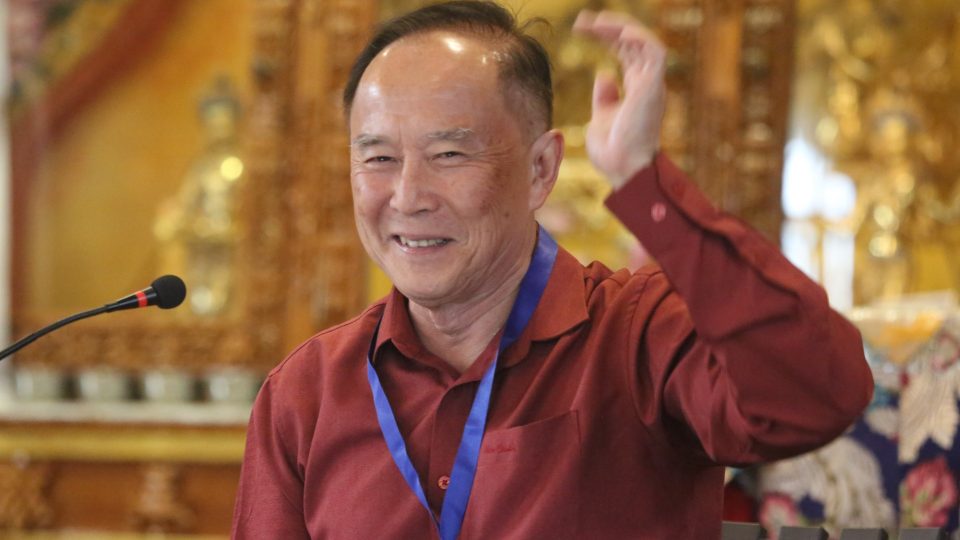
Hup Cheng, the longest serving center director within the FPMT organization, director of Amitabha Buddhist Centre, Singapore. Photo by Capucine T. Dekyong.
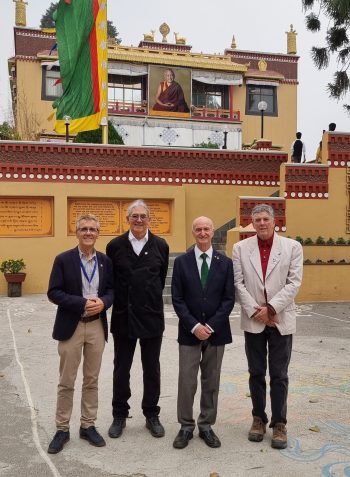
Some of the Australian contingent at Kopan Monastery: Tony Steel, Dave Andrews, Ian Green, and Brian Ashen. Photo courtesy of Ian Green.
Amitabha Buddhist Centre in Singapore Director, Hup Cheng, who is the longest serving center director within the FPMT organization, presented on “Using Technology to Construct Holy Objects.” Hup Cheng is truly an innovator. As he explained, he was given a long list from Lama Zopa Rinpoche of holy object projects to complete, and due to his unbelievable resourcefulness and creative thinking, he’s able actualize these projects. Hup Cheng described how he uses many methods, including big format printing, laser cutting technology, 3D scanning and printing, statue scan and replication, animation, and holograms! Hup Cheng’s enthusiasm and excitement about technology was so palpable: “That’s the power of digitalization! Once you scan an image and digitize it, you can upscale it as big or small as you want!”
Ian Green then addressed the group again and offered a jaw-dropping history of the Great Stupa, in Bendigo, Australia, whose actualization was a heart wish of Lama Yeshe’s. In 1980, Ian’s father had offered fifty acres of land to build a Buddhist center in Bendigo. The initial gift of land was added to by Ian’s mother and himself, accumulating into 200 acres. Lama had visited Bendigo in 1981 and was impressed by the strong community and support for Buddhist endeavors. Lama laid out his master plan for the entire site to Ian and artist Garrey Foulkes. The plan was to replicate Tibet’s 600-year-old Gyantse Stupa (Kumbum). In addition, there would be a monastery, a nunnery, a Buddhist center, aged care facility, group accommodation, a library, interpretive center, a restaurant, hotel, a village, and even a primary school. Right in the middle of all this, is the Great Stupa of Universal Compassion, which is 50 meters square at its base and nearly 50 meters high, making it the largest stupa in the Western world. Beautiful gardens surround the Stupa and the Peace Park showcasing symbols from many faiths including Catholic, Sikh, Islam, Hindu and Buddhist.
Ian also introduced the Jade Buddha for Universal Peace, which is the largest Buddha carved from gemstone quality jade in the world. After a world tour of 120 cities in 20 countries, blessing over 12 million people, the Jade Buddha is now at home at the Great Stupa. The gompa sat in stunned silence hearing about these magnificent projects.
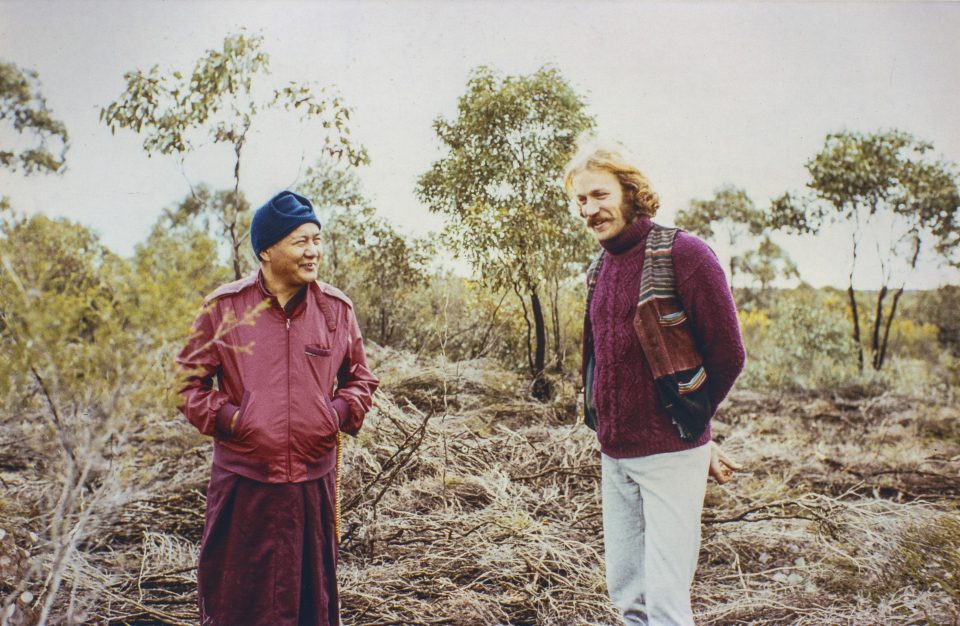
Lama Yeshe with Garrey Foulkes, Bendigo, Australia, 1981. Photo courtesy of the Lama Yeshe Wisdom Archive.
Maitreya Project Trust Director Virgina Roche offered an update on the Maitreya Project in Kushinagar. Those unfamiliar with Virginia’s personal story were deeply moved and impressed by her powerful presence, perseverance, and tenacity. “Rinpoche asked me to jump, and I replied… how high?” Virginia previously ran a leading construction company in the middle east. Rinpoche asked her to do for Maitreya Project what she had done for her own company in terms of success. Virginia has been involved in the Maitreya Project since 2017 from the outside, and since 2019 from the inside as director. She shared some of the tremendous struggles the project has faced but was also very enthusiastic about the “light at the end of the tunnel” coming for the project.
“The twenty-two-year-old stale mate finally comes to an end as we prepare to sign an MOU (Memorandum of Understanding ) with India’s leading Buddhist confederation called, The IBC (The International Buddhist Confederation) that participates and organizes several Buddhist programs and conclaves nationally and internationally. Soon we will be in a position to start the much-awaited Maitreya Project in Kushinigar,” Virginia shared, along with many details of the progress, obstacles, setbacks, and successes over the past twenty-two years of this project.
Next, Ven. Losang Gendun, an FPMT Registered Teacher and member of Mind & Life Europe, a multidisciplinary laboratory that brings together researchers and contemplative practitioners to explore the nature of experience, gave a talk on Inter-contemplative Collaboration, which is an expansion of the types of conversations commonly known as “inter-religious dialogue.” Ven. Gendun has a unique approach to this, whereas he wasn’t just interested in having discussions where participants from various backgrounds share their individual views, but instead find common views to tell a story which goes beyond the concepts of “religion” that is more inclusive to various views of life, including secular views.

Carina Thorén, Ven. Thubten Drolma, Lisette Reek presenting on climate change. Photo by Capucine T. Dekyong.
Jamyang Buddhist Centre London director Ven. Thubten Drolma; SPC of Maitreya Institute, the Netherlands, Lisette Reek; and Yeshin Norbu director in Sweden, Carina Thorén, offered a presentation addressing climate change. They asked us to consider the connection between the offerings of a Dharma center and the ongoing social and environmental upheavals of which we are all a part. “What if,” they asked, “Dharma centers were catalysts for change in the planetary crisis.” The team discussed key takeaways from the recent Planetary Crisis Summit hosted by Jamyang London as well as other ongoing efforts to continue these important discussions.
Next, Universal Education and the Foundation for Developing Compassion and Wisdom (FDCW) was discussed by three presenters: Jeff Highfill, Director of FPMT Education Services; Pamela Cayton, founder of Tara Redwood School and Creating Compassionate Cultures; and Angela Sanchez, FDCW Operations Manager.
Jeff discussed the need for a true understanding of what is meant by Universal Education and how centers can most effectively offer this as a key aspect of their courses and program.
Pam Cayton discussed her history with Universal Education. She lived at Kopan and helped to educate the monks from 1978-1988, particularly the youngest monks. Pam shared Lama Yeshe’s vision of Universal Education, which presented Buddhist wisdom and methods in a way that was accessible and relevant to all people, regardless of their religious background. This approach aimed to be both scientifically and logically grounded, making the principles of Buddhism understandable and applicable to everyday life. Lama Yeshe believed that by presenting the Dharma in a clear, rational, and universal manner, it could resonate with a wider audience and contribute to a more compassionate and peaceful world. Pam started the Tara Redwood School in 1989 in California, based on the Creating Compassionate Cultures (CCC) pedagogy.
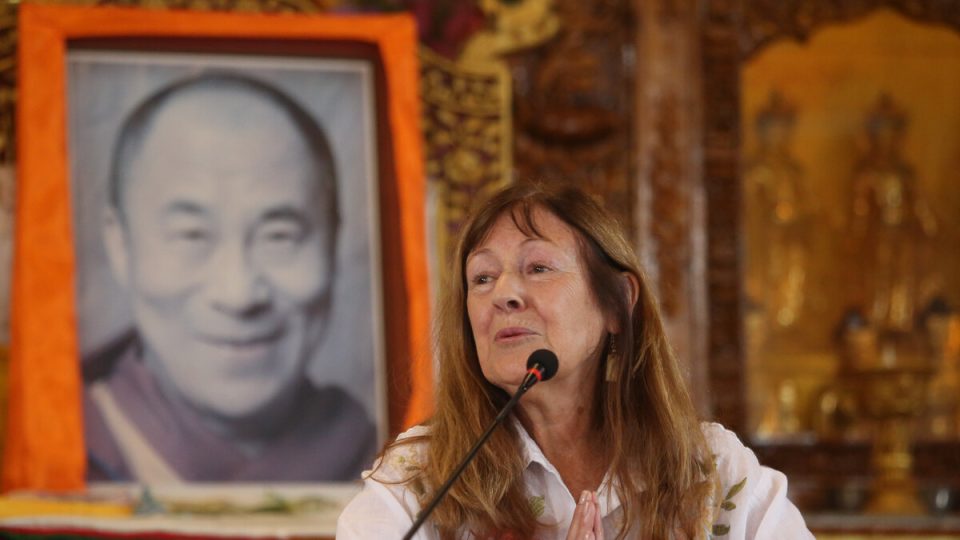
Pam Cayton presenting to the CPMT group on Creating Compassionate Culstures. Photo by Capucine T. Dekyong.
Angela Sanchez gave an overview of the Foundation for Developing Compassion and Wisdom (FDCW) and how new communities of FDCW facilitators are growing and flourishing around the world including a new development of the 16 Guidelines Meditation Course, which centers can use in their own programming.
Angela invited Ven. Gyalmo to discuss the development of 16 Guidelines for Life in Mongolia. Among their efforts in social services, they recently completed translations of the 16 Guidelines children’s resource book Ready, Set, Happy, and The 16 Guidelines for Life Book. The 16 Guidelines for Life Book was created by FDCW to offer a practical framework for enhancing one’s life and well-being. The guidelines are designed to deepen our understanding of ourselves, cultivate compassion, and promote a more meaningful and fulfilling life. The guidelines are organized around four main themes: 1) How we think, 2) How we act, 3) How we relate to others, and 4) How we find meaning.
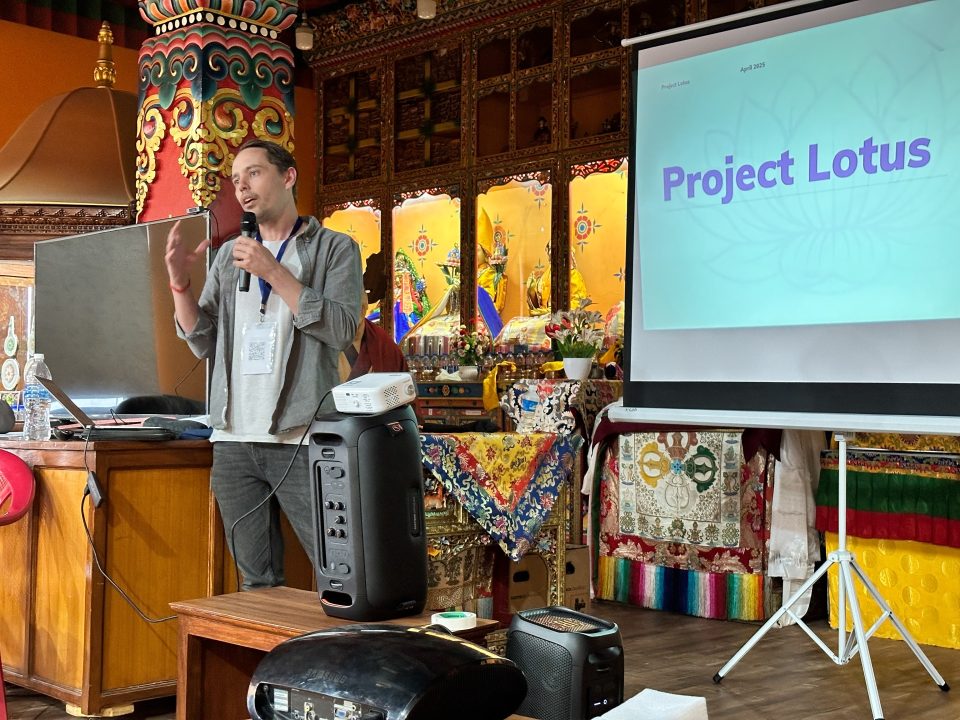
Matt McArthur presents Project LOTUS . Photo by Capucine T. Dekyong.
Following this, it was a “choose your own adventure” afternoon, where various participants shared details about their Compassion in Action initiatives and attendees could learn how they might incorporate some of these ideas into their own programs and projects. The innovation sessions and topics of interest included: Mental Health, the Lama Yeshe Wisdom Archive, International Mahayana Institute (IMI), Foundation for Developing Compassion and Wisdom (FDCW), Creating Compassionate Cultures (CCC), Reaching the Elderly in our Community, Climate Change, Project LOTUS (a global event website prototype), In-Depth Meditation Training, Global Harmony, a visit to the Animal Liberation Sanctuary, and Maitripa College.
Many of us circulated through as many presentations as we could fit into the afternoon. How inspiring to hear these presenters share passionately on topics and projects so close to their hearts. It was easy to feel that indeed, “anything is possible, everything is possible,” as Lama Yeshe used to remind students.
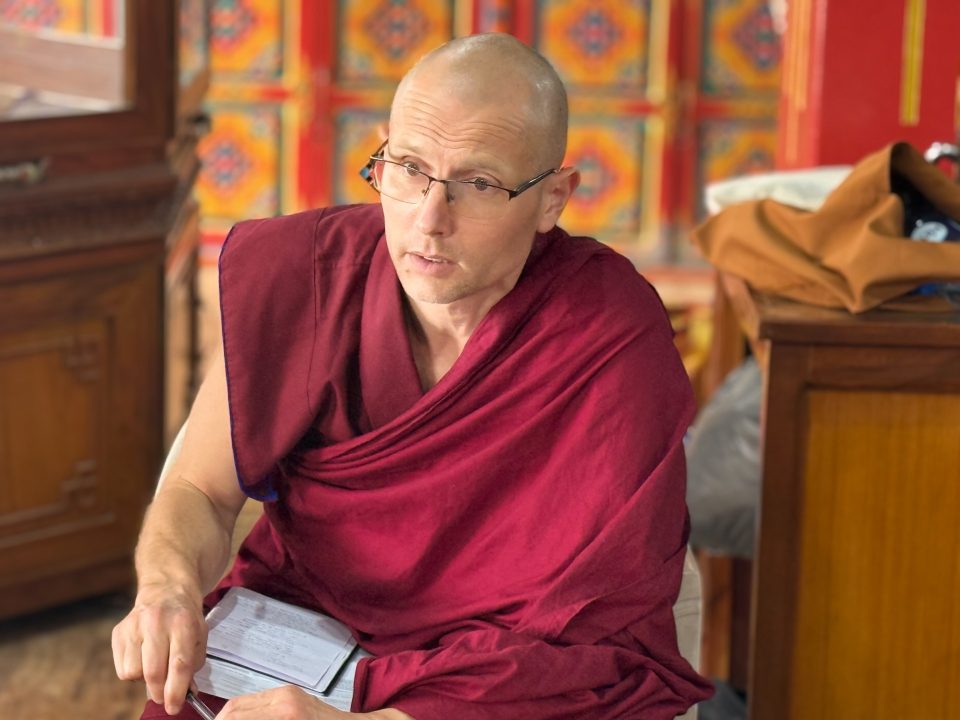
Ven. Tenzin Gache discussing during the CPMT Summit. Photo by Capucine T. Dekyong.
Ven. Tenzin Gache, an American monk and director of the IMI House at Sera Je Monastery, who is currently in the geshe studies program at Sera Je, reflected about the event: “There’s a sense that it’s up to us now. Without Rinpoche here, we have to use our own wisdom to find the way forward. And there’s a sense that though it won’t be easy, that we can do it. We can do it if we work together, and each of us works to subdue our own minds. I was impressed by the maturity of the people in leadership positions within the organization.”
Integration and Next Steps, April 11
On the final day of the Summit participants were given the opportunity to share some of their key impressions of the event. These takeaways, along with details of the evaluations/surveys participants have completed, will be shared in detail soon.
This was also a day for thanking all the various groups of people who helped ensure the meeting was a success, including: the entire Kopan staff who offered “ten star” treatment to all participants, leaders of the optional morning meditations, the track facilitators, the presenters, the translators, the tech support team, the photographers, the CPMT meeting organizers, the FPMT International Office staff, and the facilitator of the event, Jennifer Kim, who was praised for her tireless effort and dedication helping to make the event a reality with such thorough engagement.
In addition to the work of the organizers, facilitator, and everyone else involved in making the event a reality, the behind the scenes work of the tech team was truly indispensable and should be highlighted: Alexis Ben El Hadj and Harald Weichhart set up extensive equipment to ensure good audio quality in the gompa as well as made sure audio and video recordings (both on camera as well as on the computer) were created reliably to preserve the event. The requirements were even more complex than usual as many presentations included slide shows and several speakers presented via Zoom, all of which required continuous changes in the setup in very short time. Real time translations were provided in Spanish (Ven. Paloma), Italian (Ven. Siliana), French (Vens Chantal, Chokyi, and Lhamo), and Chinese (Chun Hui Chang).
About the event, Jennifer reflected, “I was deeply inspired by the care, commitment and wisdom coming from the attendees of the CPMT meeting. It gave me hope that collectively we can preserve our Lamas’ legacy and benefit others in newfound ways for years and even generations to come.”
The morning began with Yangsi Rinpoche, President of Maitripa College, joining the group via livestream. “I want to really rejoice, this is like fifty years of Rinpoche’s prayers and the students’ dedication that contribute to the flourishing of the FPMT Mandala,” Yangsi Rinpoche said. “The flourishing of individual students, projects, Dharma centers, the directors, and communities are due to their dedication together. This is really a source of rejoicing, as is our dedication to our teachers, particularly Kyabje Lama Zopa Rinpoche and Lama Yeshe”.
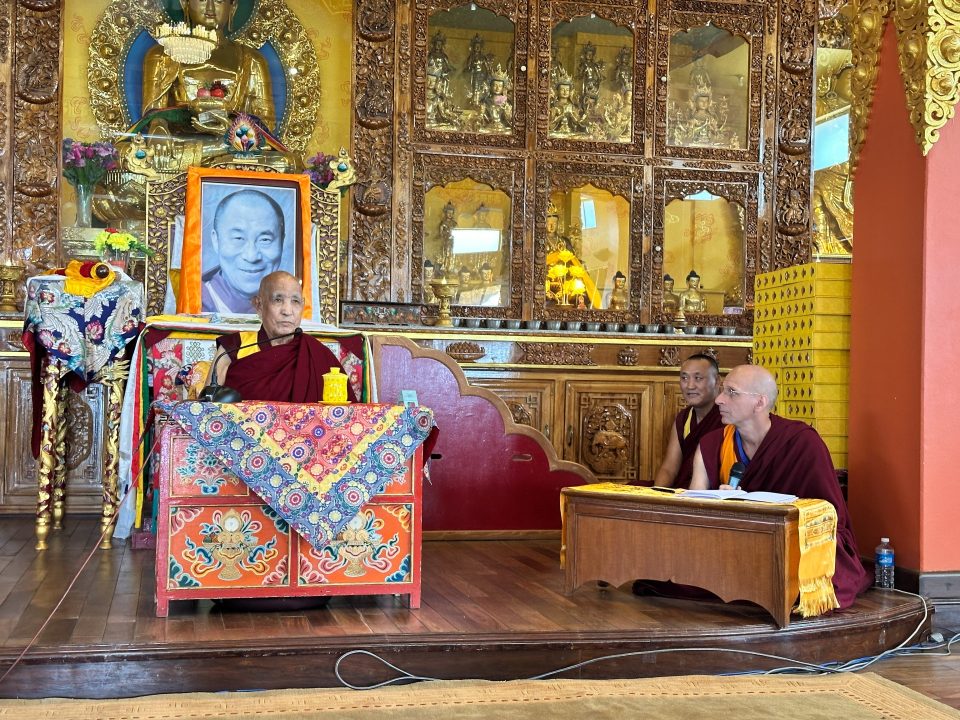
Trisur Rinpoche Jetsun Lobsang Tenzin addressing the CPMT group, April 11, 2025. Photo by Harald Weichhart
After morning tea, Trisur Rinpoche Jetsun Lobsang Tenzin joined the group personally to share a few words of encouragement:
“It’s very excellent that you all have come here and gathered together, and through your discussions with each other at this conference, it’s very important that you come to conclusions about what are the most important things that we want to do in the organization, and be clear about that. Going forward, one of the most important things will be to decide on that. And each of you, as you go back to your own centers, to carry that message with you, and tell others, and to actually put into practice what was concluded here, so in the future, we can see visible results from this meeting.
“It is important for each of you to make effort in your study and practice and really work well together. And for each of you to take responsibility to work together, because that’s the only way as an individual or as an organization that we grow. If we just do something on our own, it won’t be of much benefit. So please do this together.”
Trisur Rinpoche then consecrated beautiful boxes with a stupa of Lama Zopa Rinpoche’s holy blood relics that were then offered to each participating center by Khenrinpoche Geshe Chonyi.
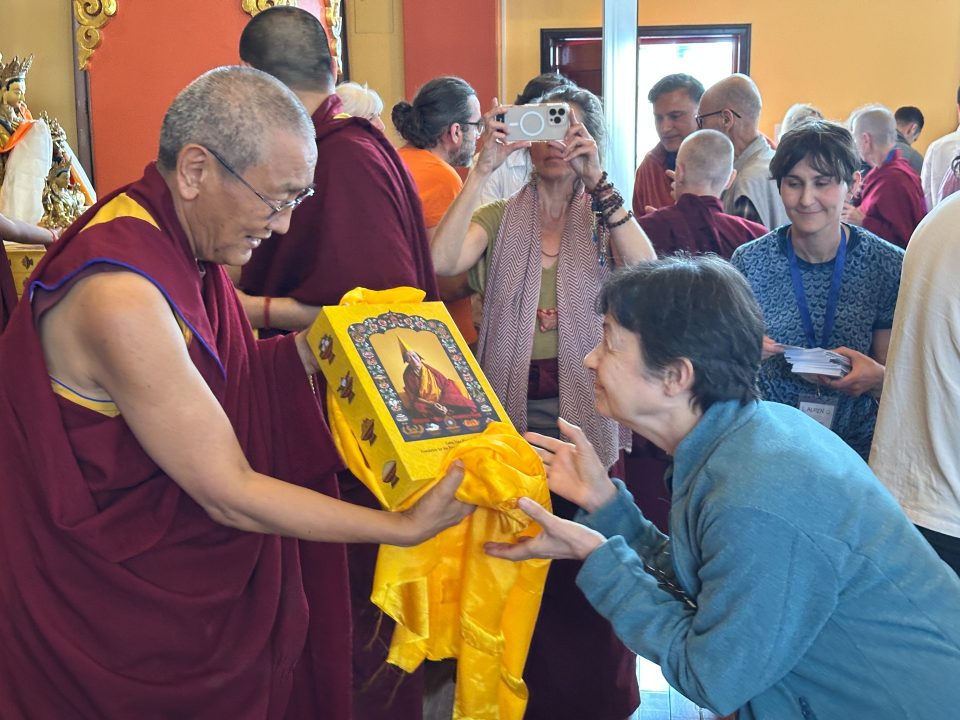
Beautiful boxes with a stupa of Lama Zopa Rinpoche’s holy blood relics were offered to each participating center by Khenrinpoche Geshe Chonyi. Photo by Harald Weichhart.
Two raffles were held on this final day—one recipient, Tara Liberation Study Group, Finland, received a copy of Big Love: The Life and Teachings of Lama Yeshe from the Lama Yeshe Wisdom Archive, and Arya Tara Institut, Germany, was the recipient of a beautiful Tara thangka which was offered by Ven. Roger Kunsang. In 2022 Lama Zopa Rinpoche explained as one of his Vast Visions that he’d like Tara thangkas continuously made for protection of the FPMT organization. This was the first thangka painted for this purpose, and it was offered to the center chosen in the drawing (Arya Tara Institut) with the commitment that the center will offer Tara puja once a month, dedicated to the success and protection of the FPMT organization.
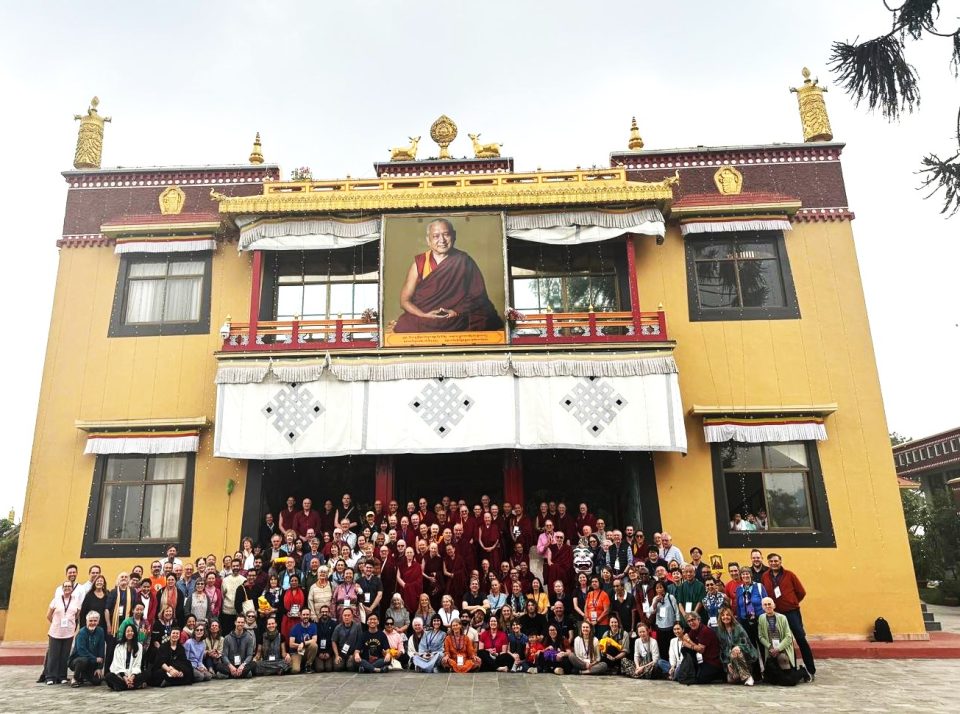
CPMT 2025 participants group photo.
The event finished with a joyful group photo taken in front of the main gompa, and lunch together, snapping our final selfies and exchanging contact info with energetic plans to continue conversations, collaborate on projects, and keep better communication with one another.
For the next couple of days, many participants stayed on at Kopan to participate in smaller group meetings with colleagues, engage in pilgrimage and group prayers at Swayambunath and Boudhanath Stupas, enjoy meals out together in Kathmandu, and join the Kopan Sangha and community for the second anniversary puja and prayers commemorating the parinirvana of Lama Zopa Rinpoche.
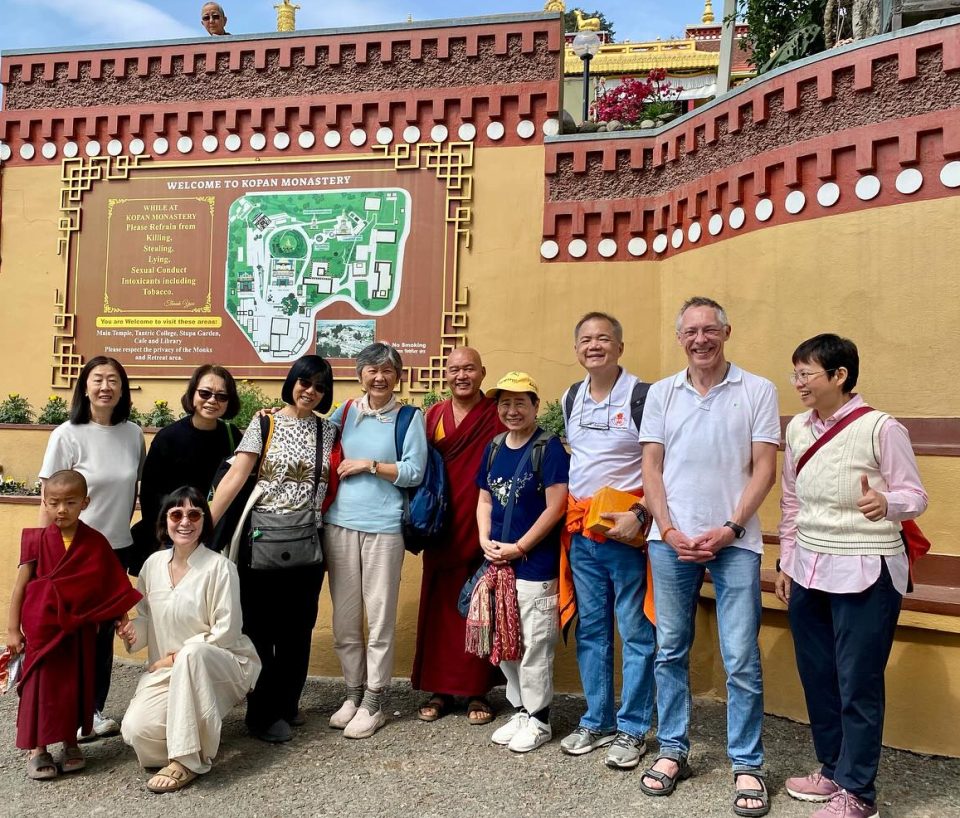
Some of the Malaysian contingent bidding a temporary goodbye, as they prepare to fly back to the land of Nasi Lemak! Photo courtesy of Selina Foong.
Ven. Joan Nicell shared this reflection about our group prayers for Lama Zopa Rinpoche’s swift return at Boudhanath Stupa. This event turned into a bit of a wild Kathmandu experience for us all—we originally had obtained permission to assemble at the first level of the stupa for our group session, but due to a misunderstanding, we had to move back down to the street in the middle of our session—picture nearly 200 of us carrying and moving mats and the altar through the shoulder-to-shoulder packed crowds and arranging ourselves on the sidewalk among the pigeons:
“The day after the CPMT meeting ended, we gathered together at the holy stupa of Boudhanath to pray for Rinpoche’s swift return. In spite of the many curious people who stopped to stare and take photos of the crowd of foreigners doing prayers in English and the flocks of pigeons pecking at the corn scattered on the ground, the feeling was of a great big family joining voices and hearts to request Rinpoche to quickly come back to guide us once again,” Ven. Joan shared.
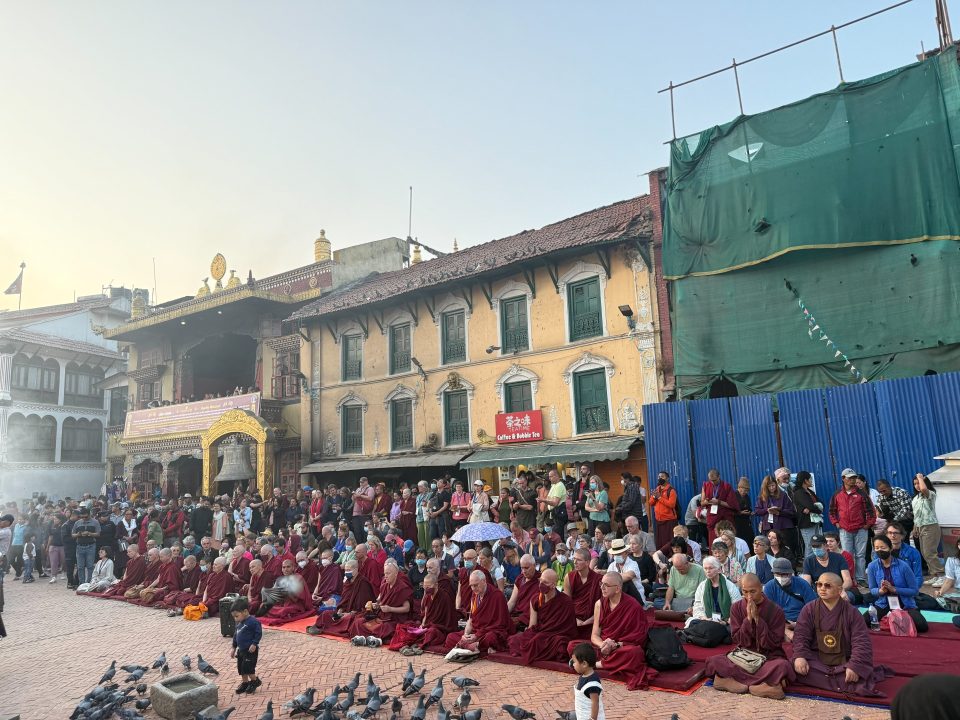
CPMT participants reciting prayers together at Boudha Stupa, April 12, 2025. Photo by Capucine T. Dekyong.
A Deeply Connected Community
Throughout the Summit, optional daily practice sessions were offered, including morning meditation using Lama Zopa Rinpoche’s How to Make My Lives Wish-Fulfilling, and each evening included an optional group activity such as the premiere of a new documentary, Vision of Lama Zopa Rinpoche: Pure Land of Guru Rinpoche at Lawudo, by Capucine T. Dekyong who was also our on-site photographer for this event, snapping an incredible 9,000 photos and video clips! About the event, Capucine shared:
“Shooting the event was like a dance, heart to heart with harmonious friends of the FPMT family. I did my best to extract the essence and inner beauty of participants—A reflection of our guru devotion, guiding us to co-create the future of the community!” All are welcome to enjoy a selection of these photos as well as contributions from others in this photo gallery.
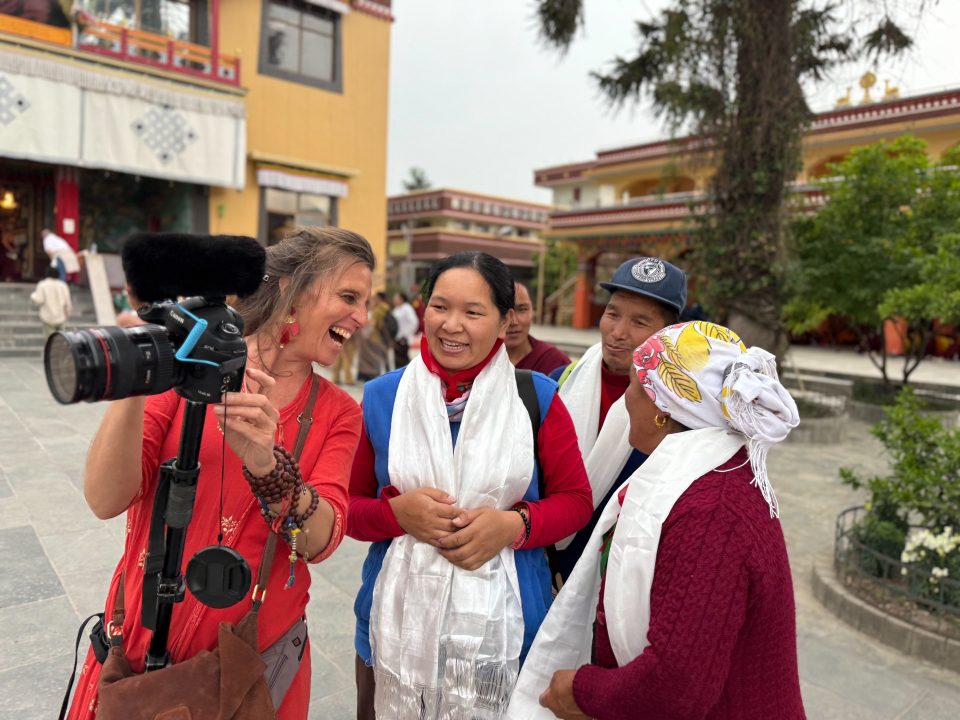
Capucine joyfully shooting the 2025 CPMT Summit.
Paula de Wys reflected on the event at its conclusion:
“This CPMT Summit was truly extraordinary. There was a sense of happiness that was present from the beginning—the happiness of being together at Kopan expressing our thoughts and ideas on how we are continuing our work for the lamas and the Dharma and then having the opportunity to help improve so many aspects of that work. We were inspired by what others are doing and we also worked hard on the future, looking at what needs to be done to make our dreams a reality. The positive energy of the first day remained strong during the whole meeting and made it indeed a truly extraordinary CPMT!”
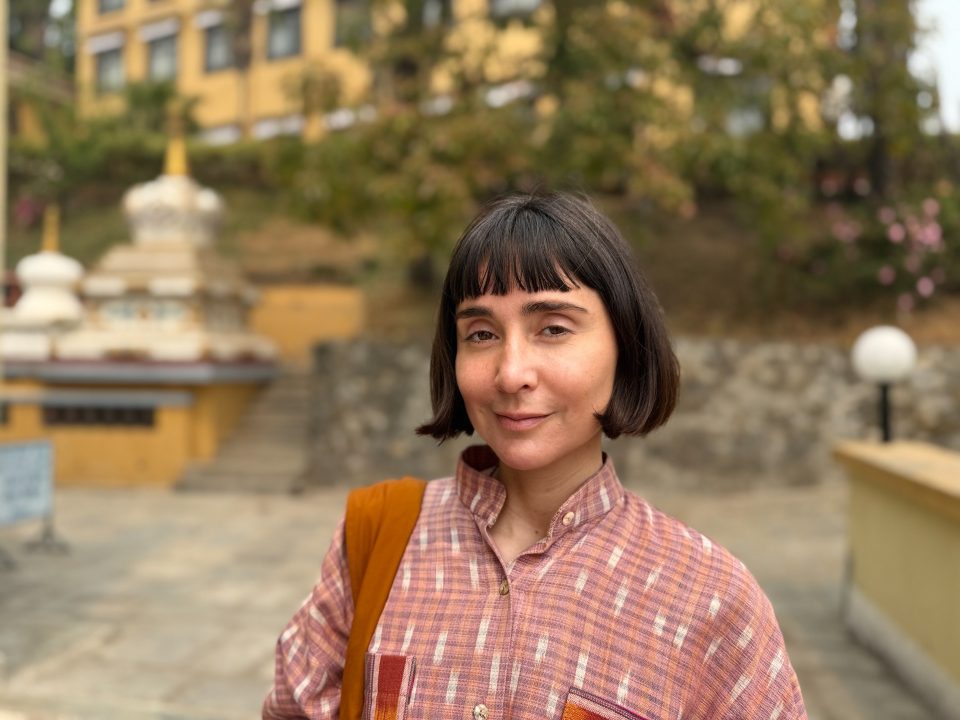
Kopan Monastery SPC, Francisca Riaño during the 2025 CPMT Summit. Photo by T. Dekyong.
Kopan Monastery SPC, Francisca Riaño, shared the following insightful comments about the CPMT Summit, which really captures the spirit of the event shared by many:
“The CPMT meeting was an experience I will cherish forever. If I could distill it into one word, it would be ‘together.’ The feeling was like family, and it was a humbling honor to help organize a gathering that brought together 195 participants, including some of the earliest students of Lama Yeshe and Lama Zopa Rinpoche, as well as a 5-year-old whose joy lit up the room. The energy and legacy of our founding lamas were palpable throughout, and many felt deeply connected to the community they built.
“I was moved by the efforts of the board, the International Office, and our dear Kopan team, who worked tirelessly to make this gathering a reality. We faced challenges—such as a car crashing into an electricity post during a live Zoom session with Ling Rinpoche, causing a temporary loss of connection—yet the spirit of the gathering never wavered. The energy at Kopan remained vibrant, reminding us of the strength and resilience of our global Sangha.
“For those of us serving at centers like Kopan, it can sometimes feel isolating, especially for newcomers. This gathering was a powerful reminder that we are not alone, our network is strong, and we have kindred spirits to walk this path with us. With 70 centers represented out of 133, all gathered where it all began, it was a deeply moving experience, a warm embrace for the heart and a reminder that, in a world marked by separation, coming together is the only way forward.
“Discussions around caring for the planet and preserving our lamas’ lineage highlighted the inseparable link between inner work and outer responsibility. Connecting with fellow practitioners and honoring those who have guided many of us on this path was truly inspiring. Today, there is a clear sense of direction, and our commitment to co-creating a ‘world guided by compassion and wisdom’—the theme of the gathering—is stronger than ever.”
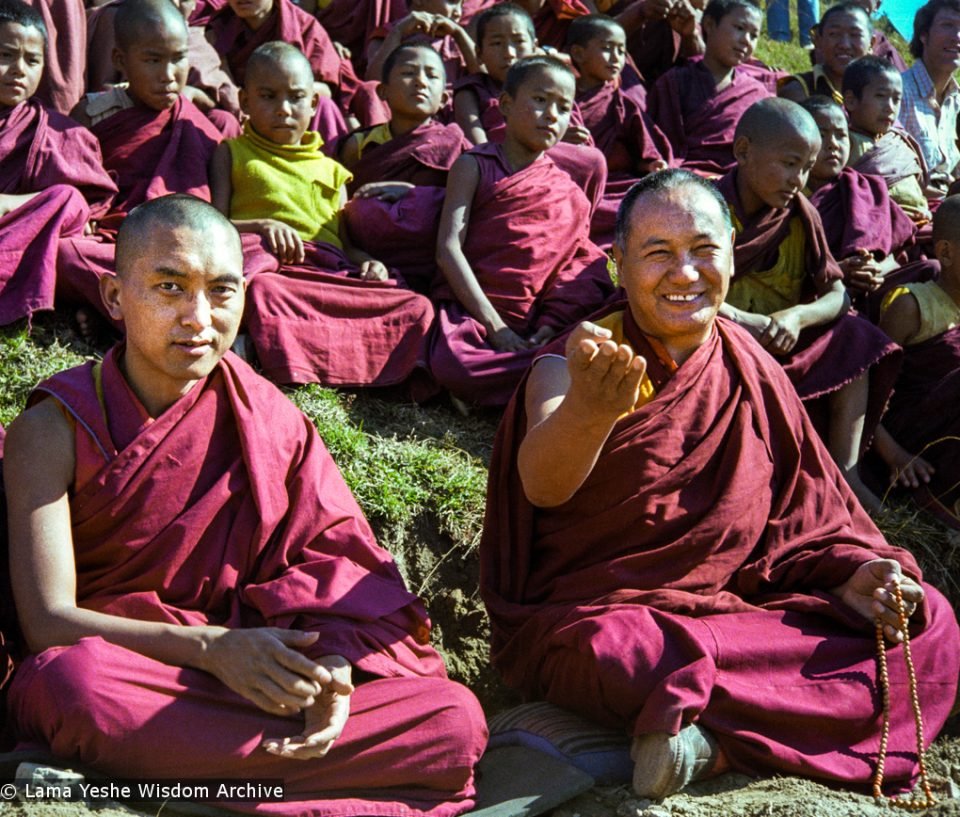
Lama Zopa Rinpoche and Lama Yeshe at the 12th Meditation Course, Kopan Monastery, Nepal, 1979. Photo by Ina Van Delden, courtesy of Lama Yeshe Wisdom Archive.
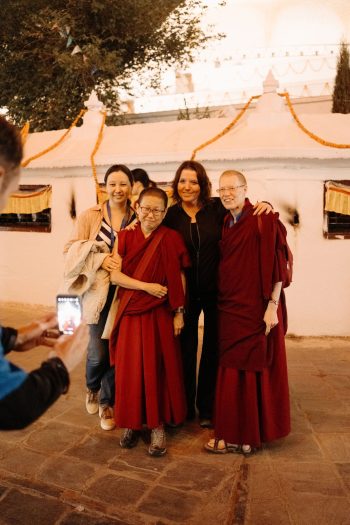
FPMT International Office friends and colleagues: Zarina Osmonalieva, Ven. Tenzin Tsomo, Carina Rumrill, Ven. Holly Ansett, in front of the Boudha Stupa after a meal together. Photo by Matt Linden.
May this collective effort and enthusiasm from the goodhearted and sincerely-motivated participants and organizers of this momentous meeting, blessed by our most kind teachers, create the causes for the FPMT organization to thrive and flourish long into the future so it may continue benefiting sentient beings through the ongoing actualization of our lamas’ incredibly vast vision, put into motion fifty years ago at the heart of it all—Kopan Monastery, and carried forth by every single person tirelessly working, supporting, studying, practicing, teaching, and actualizing the path within the FPMT mandala.
Written by Carina Rumrill, Managing Editor for FPMT International Office with tremendous thanks to Justin Jenkins, Harald Weichhart, Capucine T. Dekyong, Matt Linden, and the International Office staff and Board of Directors for their help providing editing suggestions, details, media, and technical support as this story took shape.
Carina has worked for the FPMT organization since 2004, first with Ven. Robina Courtin at the Liberation Project Project when it was based in San Francisco, CA, USA. She joined the FPMT International Office team in Portland, OR, in 2008 as Managing Editor and Publisher of Mandala magazine and has since worked in various capacities within the communications department. She lives in Vermont.
Foundation for the Preservation of Mahayana Tradition (FPMT), is a Tibetan Buddhist organization dedicated to the transmission of the Mahayana Buddhist tradition and values worldwide through teaching, meditation and community service.
8
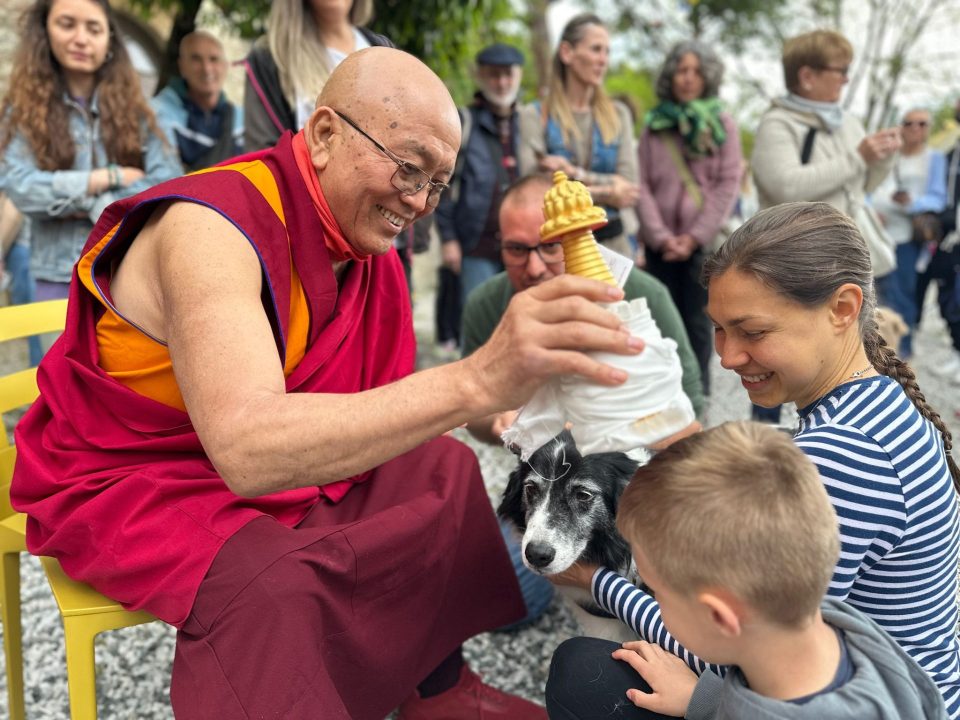
Geshe Tenzin Tenphel blessing a family and their dog at the ILTK animal blessing, April 17, 2025. Photo courtesy of ILTK.
On April 17, 2025 Istituto Lama Tzong Khapa hosted a special animal blessing event. Carlota Pinhero shares the story:
Our lamas’ teachings continue to live through our actions. Lama Zopa Rinpoche consistently emphasized boundless kindness toward all sentient beings, including our animal companions. Throughout his life, Rinpoche dedicated himself completely to the welfare of all beings, establishing numerous projects focused on caring for animals, liberating them, and creating conditions for their wellbeing in this life and favorable rebirth in the next. Anyone who had the fortune to meet Rinpoche witnessed his tireless blessing of animals with mantras and sacred images—his effort and devotion were truly extraordinary.
As we mark two years since Lama Zopa Rinpoche showed the aspect of passing away, and now joyfully celebrate the wonderful news of his reincarnation being born, Istituto Lama Tzong Khapa (ILTK) is honored to hold this special day of animal blessing in his remembrance. This beautiful tradition embodies the compassionate vision that Lama Zopa Rinpoche shared with the world—a vision where every sentient being, regardless of form, is recognized as worthy of our care and attention. Through these blessing ceremonies, we not only honor his legacy but actively continue the work of creating positive connections between beings and the Dharma.
Morning Blessing in the Ocean
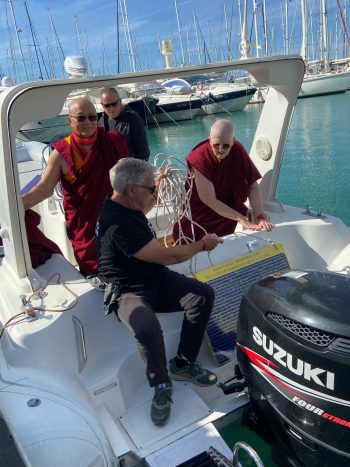
Preparing to bless animals in the ocean on April 17, 2025. Photo courtesy of ILTK.
The events of April 17 began early at 10:00 a.m. at Porto Cala De’ Medici in Rosignano. Standing at the harbor entrance with a group of practitioners, we gathered to bless the animals of the ocean. It was a memorable sight—one group remained on shore reciting prayers facing the water, while another ventured out on a small inflatable boat, carefully trailing two large metal plates engraved with the Namgyalma mantra through the water.
There is something profoundly moving about this practice. These sacred words are silently blessing countless unseen beings beneath the waves. Watching the ripples spread across the water’s surface we can’t help but reflect on Lama Zopa Rinpoche’s view about our connection to all sentient beings: we are all equal; it’s just that at the moment we have different bodies.
The words of our dear Lama Zopa Rinpoche, echo through this day: “All sentient beings, including animals, have been our mothers countless times and have cared for us in infinite ways. This blessing is a powerful and effective way to repay their kindness—not only by saving them from the suffering of death, but more importantly, by allowing them to hear the Dharma and thereby lay the foundations for a fortunate rebirth.”
Afternoon Blessing for Pets
After lunch, the main courtyard of ILTK was used for the blessing of domestic animals. The atmosphere was joyful as people arrived with their beloved pets: dogs wagging their tails and cats observing everything with typical feline attitude. Geshe Tenzin Tenphel, one of our resident teachers, led the ceremony alongside Geshe Lhundup Sherab and our monks, nuns, and special guest Angelo Vaira from the ThinkDog School who shared, “I had the honor of meeting Lama Zopa Rinpoche in person and he encouraged me to continue my work as a teacher, nurturing the human and animal relationship through awareness and compassion.”
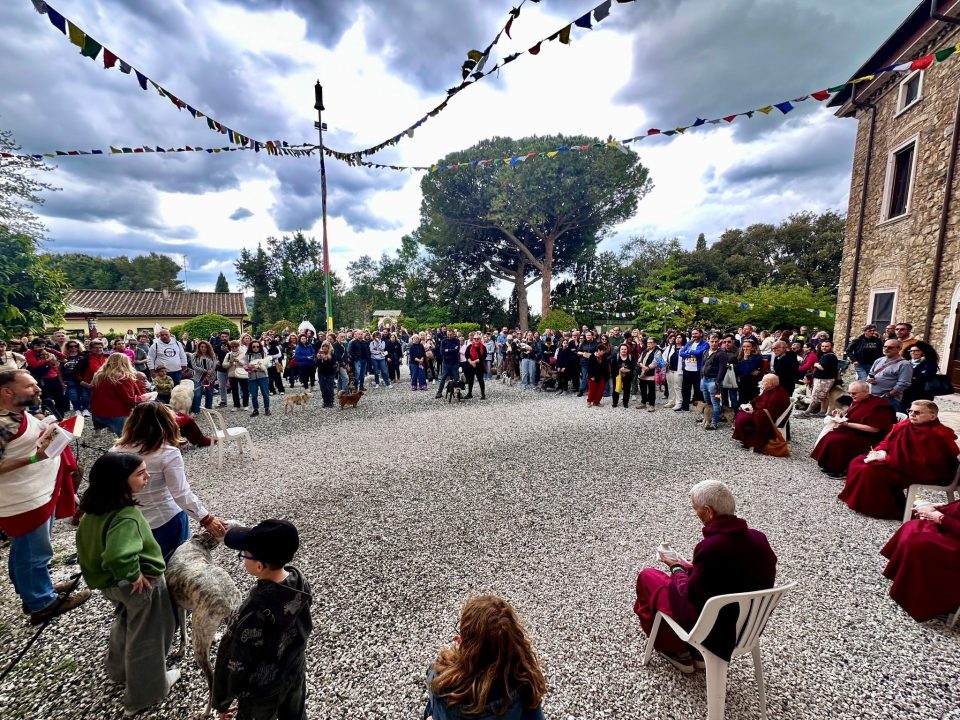
Courtyard at ILTK during the April 17 animal blessing. Photo courtesy of ILTK.
The courtyard filled with the gentle sounds of mantras as each animal had a consecrated stupa briefly placed on their head. Every pet owner also received a blessed thread and a certificate of participation, a small but meaningful reminder of this special day.
Reflections Over Tea
After the ceremony, many of us gathered in the Tea Garden, which had been opened for the occasion. Sipping warm tea and sharing stories about our animal companions, there was a strong sense of community among strangers united by love for animals and spiritual practice. Everyone noticed how some pets seemed to intuitively understand the significance of the moment, becoming remarkably calm during their blessing, reflecting the genuine care and respect shown to each animal throughout the ceremony.
Lama Zopa Rinpoche talked about these blessings saying that they’re not just about alleviating immediate suffering but about planting seeds for fortunate future rebirths for these beings. It’s a perspective that extends compassion beyond the present moment into a much vaster timeframe.
Why This Matters
In our busy, often disconnected modern lives, ceremonies like this remind us of our interdependence with all living beings. They ask us to pause and recognize the consciousness in every creature, no matter how different from us they may appear. This beautiful tradition bridges ancient Buddhist wisdom with our contemporary relationships with animals. In a world that can sometimes feel divided and harsh, witnessing such pure expressions of compassion restore something essential in our hearts. ILTK is always honored to host these types of events and welcome everyone to join, not just for your own pets, but for the perspective it offers on our place within the vast web of sentient life.
“We are all the same. We are all one family. It’s just that, for now, we have different bodies. I should feel as close to these animals as I do to my current family. I should hold them in my heart. I must free all these animals from all their suffering and its causes, and lead them to enlightenment. To free all sentient beings from their obscurations and lead them to enlightenment, I must attain enlightenment myself—there is no other way. To do that, I must practice the six perfections. Therefore, I will give the Dharma to the animals of the ocean by blessing them with the mantras of Chenrezig, Namgyalma, and so on.” — Lama Zopa Rinpoche
With grateful thanks to Carlota Pinhero and Fabiana Lotito for sharing this story.
Many resources are available for those wishing to benefit animals, including advice from Lama Zopa Rinpoche and links to practices and materials:
https://fpmt.org/education/prayers-and-practice-materials/benefiting-animals-practices-and-advice/
Foundation for the Preservation of Mahayana Tradition (FPMT), is a Tibetan Buddhist organization dedicated to the transmission of the Mahayana Buddhist tradition and values worldwide through teaching, meditation and community service.
- Tagged: animal blessing, istituto lama tzong khapa
7
Wheel of Sharp Weapons Retreat at Kopan Monastery
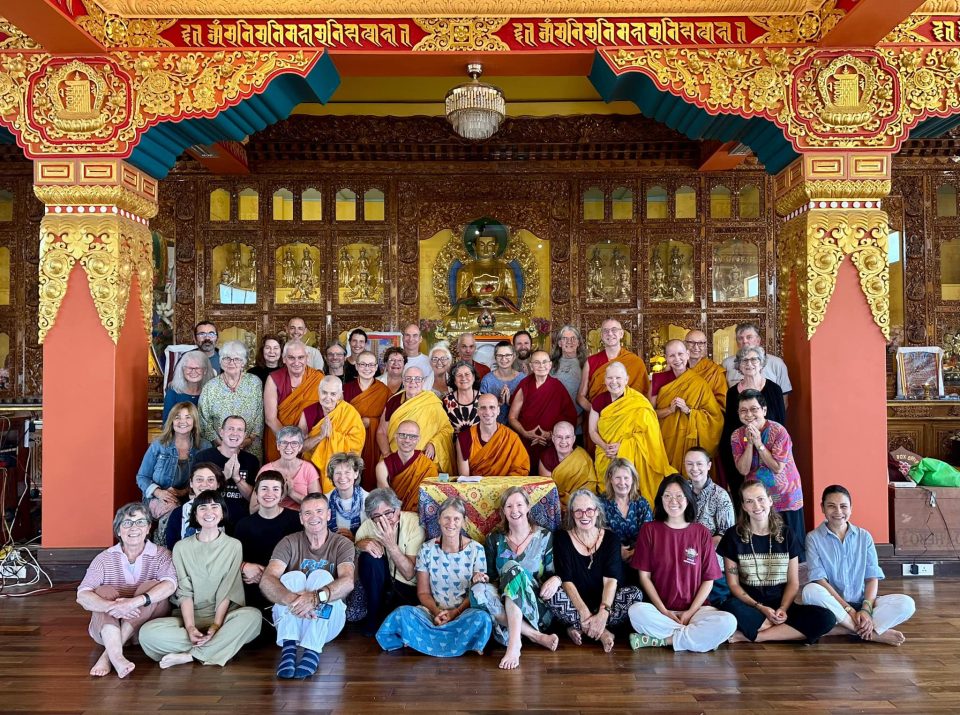
Participants in the 2025 Wheel of Sharp Weapons retreat at Kopan Monastery. Photo courtesy of Nalanda Monastery.
Kopan Monastery Spiritual Program Coordinator, Francisca Riaño and retreat leader Geshe Legtsok shared details of the Wheel of Sharp Weapons retreat, an expressed wish of Lama Zopa Rinpoche, which recently ended at Kopan:
In the spirit of honoring Kyabje Lama Zopa Rinpoche’s wishes, we were blessed to host the first Wheel of Sharp Weapons retreat, led by Geshe Tenzin Legtsok from April 17-23, following the CPMT Summit and the anniversary of Rinpoche’s mahaparinirvana on April 13. With 53 participants, many of whom had just taken part in the CPMT meeting, the retreat offered a profound space for deep practice and transformation.
The days began with one of the twelve international monks or nuns, who volunteered to guide the precepts ceremony and morning meditation. Afterward, Ven. Dechen from Malaysia and our dear Kopan nun, Ven. Tenzin (Ani Janne), led the Lama Chopa practice. Their leadership greatly enriched the retreat, ensuring participants could experience the practices authentically. Ven. Dechen’s voice, a true gift, brought an added sense of devotion and peace to the space.
Our retreat leader, Geshe Legtsok, was a source of inspiration. With humor and humility, he shared his vast knowledge and infused every session with his deep devotion to His Holiness the Dalai Lama and Kyabje Lama Zopa Rinpoche. His teachings not only enlightened our minds but also touched our hearts, reminding us of the interconnectedness of our practice and spiritual family.
Each day, we were fortunate to watch two videos of Lama Zopa Rinpoche’s teachings, seamlessly integrated into our morning and afternoon sessions. These teachings were deeply inspiring and brought Rinpoche’s presence into the retreat, blessing us with his timeless wisdom and boundless compassion. The collective energy in the gompa throughout the retreat felt like a mandala of joyful perseverance. Each day felt like an opportunity to deepen our commitment to the path.
The retreat was a transformative experience, bringing together wisdom, devotion, and heartfelt connection as we practiced in honor of our precious teachers. It was an embodiment of the teachings of The Wheel of Sharp Weapons and a powerful reminder of the importance of perseverance, wisdom, and compassion on the spiritual path.
About the retreat, Geshe Legtsok shared: “Lama Zopa Rinpoche’s intention for the Wheel of Sharp Weapons retreat was that students actually develop realizations. Among the participants about 40 had attended the CPMT meeting, and many were senior students or ordained sangha. During the meditation sessions one could feel that all were very focused and making sincere effort in deepening their understanding and transformation. The essential aim was seeing how suffering fundamentally arises from selfishness and self-grasping ignorance; and how we can reduce and destroy these tendencies with powerful wisdom, compassion, and ethical conduct. At the conclusion many said they were deeply moved by their experiences in the retreat. The combination of Lama Chopa, Rinpoche’s teaching videos, a classic text, and explanations worked well a as basis for meditation. Also, practicing as a harmonious group definitely generates a special positive power. I’m grateful to all who made this possible and look forward to more such retreats.”
With grateful thanks to Francisca and Geshe Legtsok for the report on this very special retreat.
Foundation for the Preservation of Mahayana Tradition (FPMT), is a Tibetan Buddhist organization dedicated to the transmission of the Mahayana Buddhist tradition and values worldwide through teaching, meditation and community service.
- Tagged: wheel of sharp weapons
- Home
- News/Media
- Study & Practice
- About FPMT Education Services
- Latest News
- Programs
- New to Buddhism?
- Buddhist Mind Science: Activating Your Potential
- Heart Advice for Death and Dying
- Discovering Buddhism
- Living in the Path
- Exploring Buddhism
- FPMT Basic Program
- FPMT Masters Program
- FPMT In-Depth Meditation Training
- Maitripa College
- Lotsawa Rinchen Zangpo Translator Program
- Universal Education for Compassion & Wisdom
- Online Learning Center
- Prayers & Practice Materials
- Overview of Prayers & Practices
- Full Catalogue of Prayers & Practice Materials
- Explore Popular Topics
- Benefiting Animals
- Chenrezig Resources
- Death & Dying Resources
- Lama Chopa (Guru Puja)
- Lama Zopa Rinpoche: Compendium of Precious Instructions
- Lama Zopa Rinpoche: Life Practice Advice
- Lama Zopa Rinpoche Practice Series
- Lamrim Resources
- Mantras
- Prayer Book Updates
- Purification Practices
- Sutras
- Thought Transformation (Lojong)
- Audio Materials
- Dharma Dates – Tibetan Calendar
- Translation Services
- Publishing Services
- Teachings and Advice
- Find Teachings and Advice
- Lama Zopa Rinpoche Advice Page
- Lama Zopa Rinpoche: Compendium of Precious Instructions
- Lama Zopa Rinpoche Video Teachings
- ༧སྐྱབས་རྗེ་བཟོད་པ་རིན་པོ་ཆེ་མཆོག་ནས་སྩལ་བའི་བཀའ་སློབ་བརྙན་འཕྲིན།
- Podcasts
- Lama Yeshe Wisdom Archive
- Buddhism FAQ
- Dharma for Young People
- Resources on Holy Objects
- Ways to Offer Support
- Centers
- Teachers
- Projects
- Charitable Projects
- Make a Donation
- Applying for Grants
- News about Projects
- Other Projects within FPMT
- Support International Office
- Projects Photo Galleries
- Give Where Most Needed
- FPMT
- Shop
Translate*
*powered by Google TranslateTranslation of pages on fpmt.org is performed by Google Translate, a third party service which FPMT has no control over. The service provides automated computer translations that are only an approximation of the websites' original content. The translations should not be considered exact and only used as a rough guide.In my mind, one of the beauties of Buddhism is that it offers us a practical training for our mind. It does not say, ‘Bodhicitta is fantastic because Buddha said so!’ Instead, it gives us the methods for developing such an attitude and we can then see for ourselves whether it works or not, whether it is fantastic or not.
